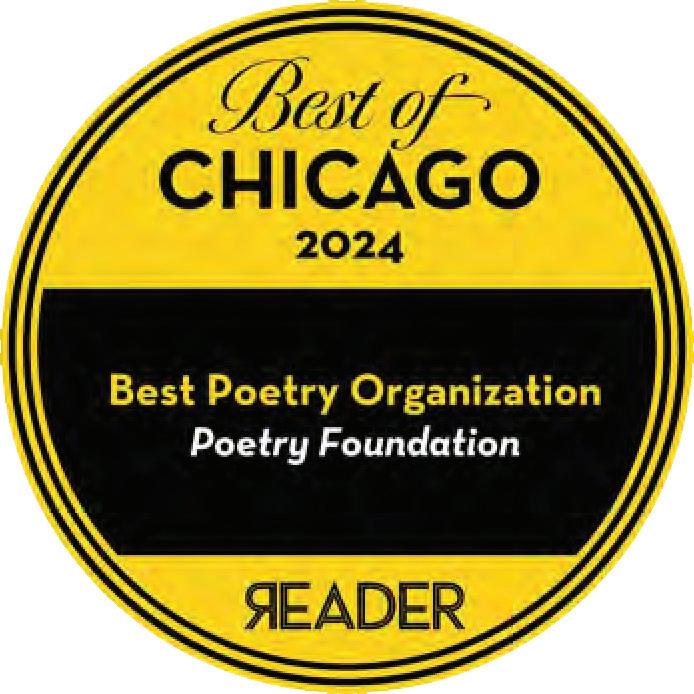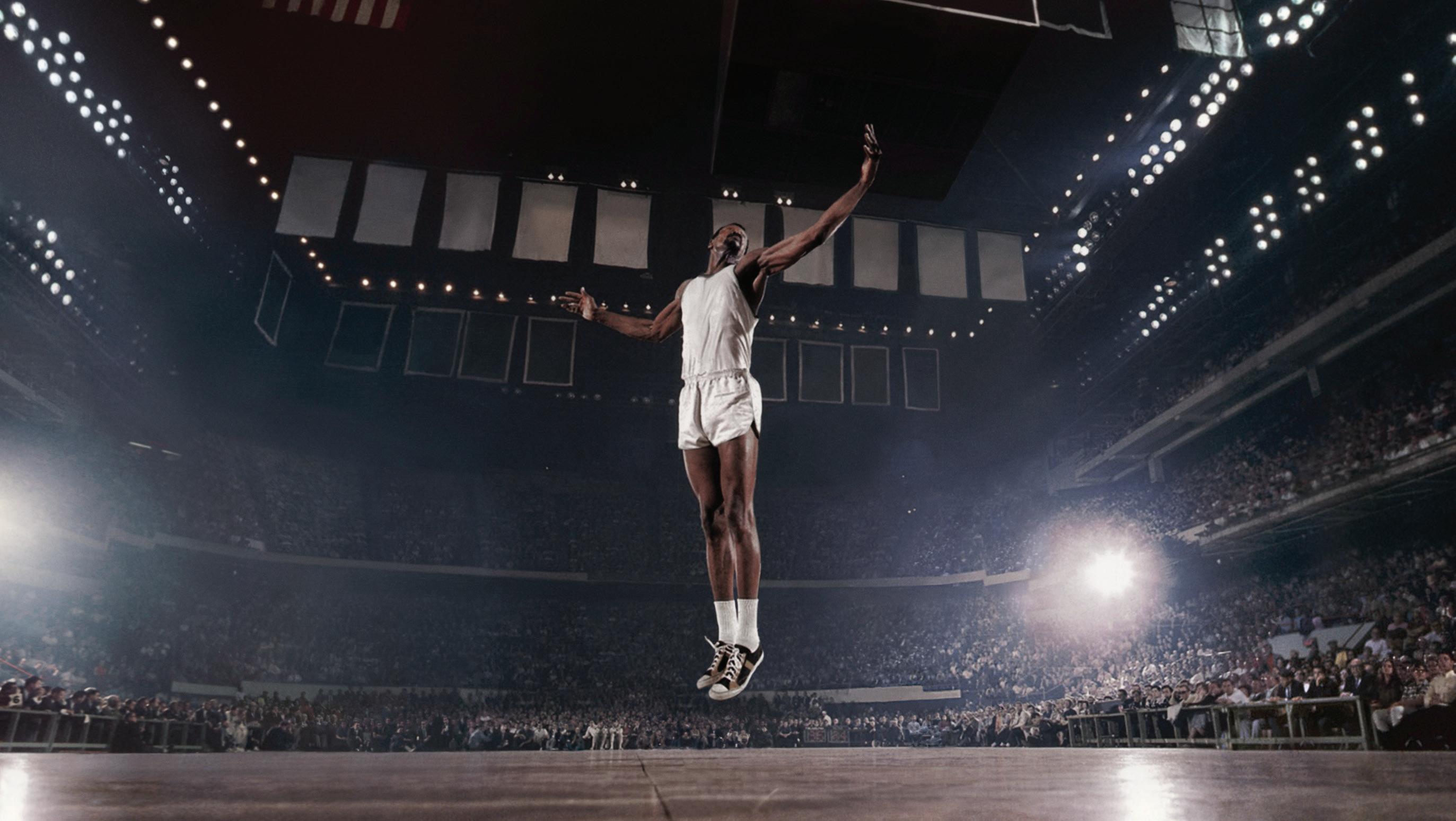









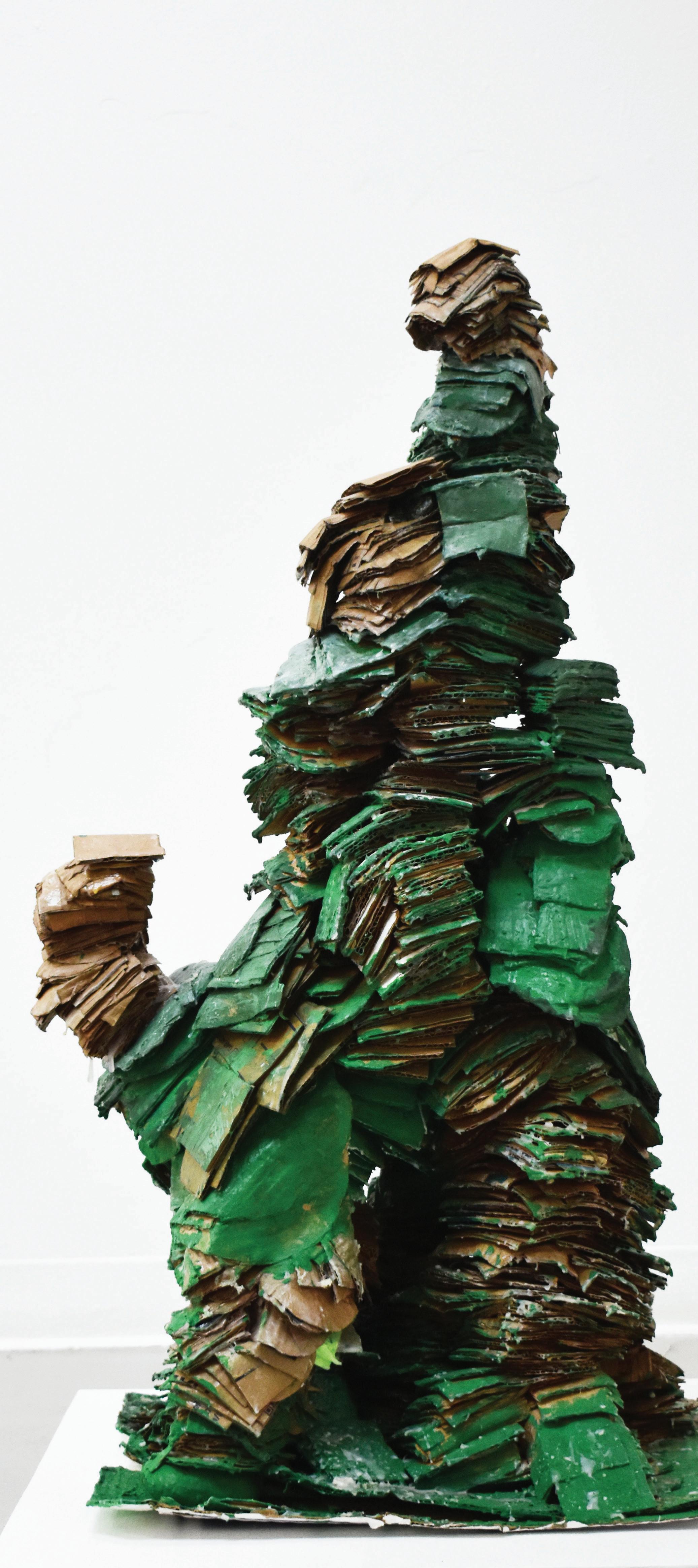
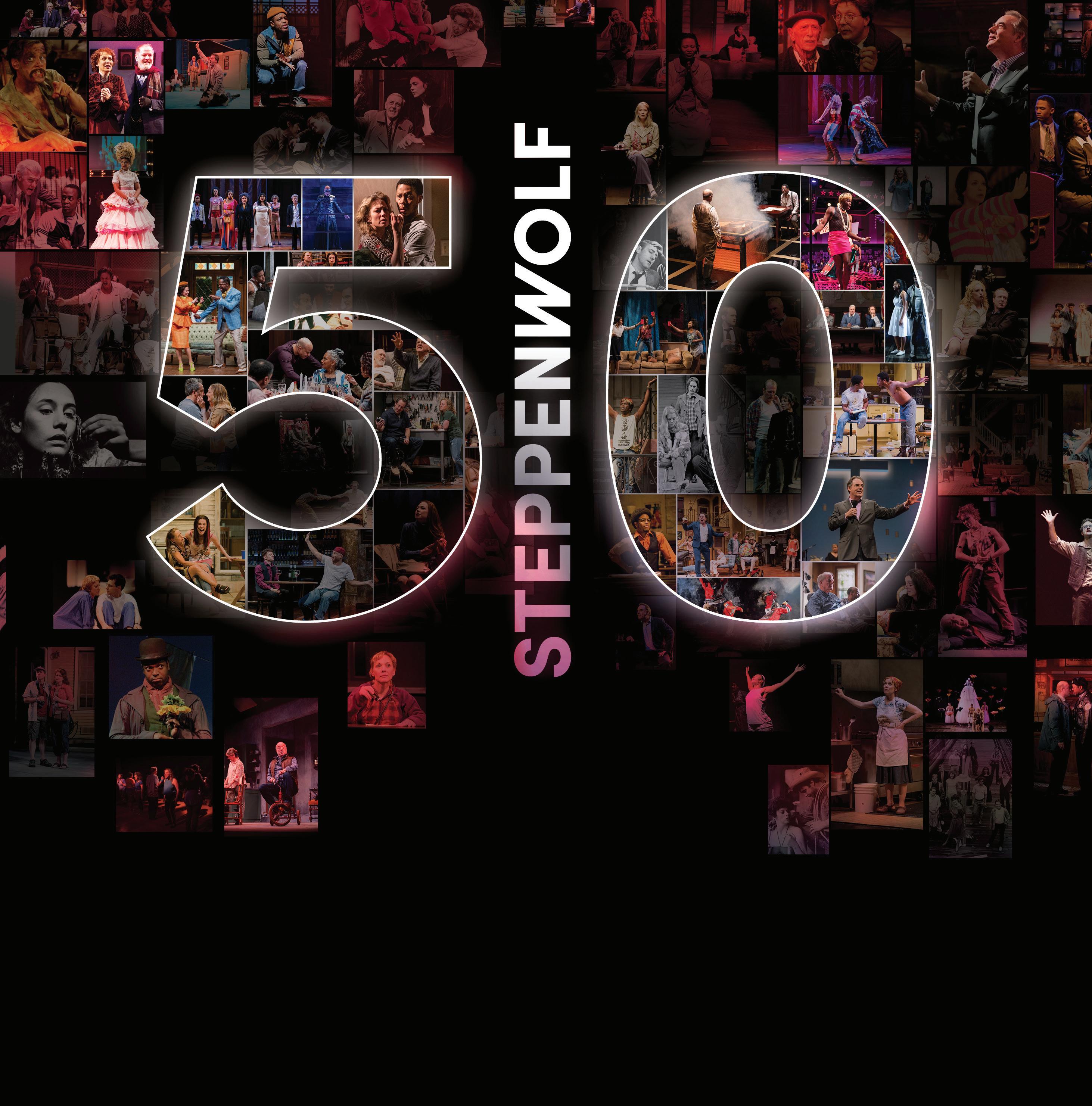



















The Chicago Reader is a crucial part of Chicago’s vibrant arts culture. A perfect storm of economic challenges has put its future at risk--but we’re not giving up. If you value independent journalism and want to see the Chicago Reader survive, please chip in now with a tax-deductible donation. Support Independent Journalism. Donate Now.
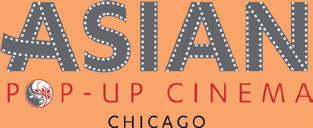






































































































































































































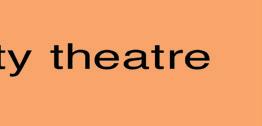







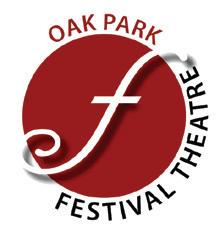
























































































06 Editor’s Note Spring theater and arts FOOD & DRINK
07 Feature | Sula New Chicago food and beverage books you should read
& POLITICS
09 Make It Make Sense | Mulcahy Trump continues his attacks on higher education, the City Council signs off on four police misconduct settlements, and more.
10 Cover Story | Cardoza Celebrating 25 years of Arts of Life
12 Art of Note Melissa Leandro at Andrew Rafacz
14 Cover Story | Renken Book drag kings. Period.
16 Feature | Reid What the Reader means for the past and future of theater journalism
18 Performance Picks Helluva Cabaret gives a drag makeover to Helluva Boss; Giordano Dance Chicago returns to the Harris; Céline Dion crashes a maritime tour in the jukebox musical Titanique
20 Shows of Note A bilingual musical of Go Dog Go!; Hamlet as imagined by actors with Down syndrome; Concrete Content’s The Pillowman
FILM
22 Feature Revolution until victory: the 24th Chicago Palestine Film Festival
26 Movies of Note The Alto Knights plays more like a History Channel special than a pulsepounding mob movie; Steven Soderbergh’s Black Bag is a nimble spy thriller; and more.
27 Moviegoer Drawn and quatered MUSIC
28 Secret History of Chicago Music Soul singer Bobby McClure tried to evolve with the times.
30 Shows of Note Previews of concerts including BbyMutha, Quest Master, Refused, and Ibelisse Guardia Ferragutti & Frank Rosaly
33 Jobs 33 Services
34 Savage Love Advice for when sex hurts; a chance to talk to Dan Savage

Drag king Monsieur Bombastic GREG INDA
ON THE COVER
Le : Drag performers Po’Chop (le ) and Switch the Boi Wonder of Notes on Masculinity. Photo by Greg Inda. More from Inda can be found at greginda.com or instagram.com/greg_inda. Story on page 14.
Find us on socials: facebook.com/chicagoreader twitter.com/Chicago_Reader instagram.com/chicago_reader threads.net/@chicago_reader linkedin.com search chicago-reader
The Chicago Reader accepts comments and letters to the editor of less than 400 words for publication consideration. m letters@chicagoreader.com
@CHICAGOREADER.COM
PUBLISHER AMBER NETTLES
CHIEF OF STAFF ELLEN KAULIG
EDITOR IN CHIEF SALEM COLLO-JULIN
ASSISTANT MANAGING EDITOR
SAVANNAH RAY HUGUELEY
PRODUCTION MANAGER AND STAFF
PHOTOGRAPHER KIRK WILLIAMSON
SENIOR GRAPHIC DESIGNER AMBER HUFF
GRAPHIC DESIGNER AND PHOTO RESEARCHER SHIRA
FRIEDMAN-PARKS
THEATER AND DANCE EDITOR KERRY REID
MUSIC EDITOR PHILIP MONTORO
CULTURE EDITOR: FILM, MEDIA, FOOD AND DRINK TARYN MCFADDEN
CULTURE EDITOR: ART, ARCHITECTURE, BOOKS KERRY CARDOZA
NEWS EDITOR SHAWN MULCAHY
PROJECTS EDITOR JAMIE LUDWIG
DIGITAL EDITOR TYRA NICOLE TRICHE
SENIOR WRITERS LEOR GALIL, DEANNA ISAACS, BEN JORAVSKY, MIKE SULA
FEATURES WRITER KATIE PROUT
SOCIAL JUSTICE REPORTER DEVYN-MARSHALL BROWN (DMB)
STAFF WRITER MICCO CAPORALE
MULTIMEDIA CONTENT PRODUCER SHAWNEE DAY
SOCIAL MEDIA ENGAGEMENT
ASSOCIATE CHARLI RENKEN
VICE PRESIDENT OF OPERATIONS ANN SCHOLHAMER
VICE PRESIDENT OF PEOPLE AND CULTURE ALIA GRAHAM
DEVELOPMENT MANAGER JOEY MANDEVILLE DATA ASSOCIATE TATIANA PEREZ
MARKETING ASSOCIATE MAJA STACHNIK
MARKETING ASSOCIATE MICHAEL THOMPSON
VICE PRESIDENT OF SALES AMY MATHENY
SALES REPRESENTATIVE WILL ROGERS
SALES REPRESENTATIVE KELLY BRAUN
MEDIA SALES ASSOCIATE JILLIAN MUELLER
ADVERTISING
ADS@CHICAGOREADER.COM, 312-392-2970
CREATE A CLASSIFIED: CLASSIFIEDS.CHICAGOREADER.COM
DISTRIBUTION CONCERNS
DISTRIBUTIONISSUES@CHICAGOREADER.COM
READER INSTITUTE FOR COMMUNITY JOURNALISM, INC.
CHAIRPERSON EILEEN RHODES
TREASURER TIMO MARTINEZ
SECRETARY TORRENCE GARDNER
DIRECTORS MONIQUE BRINKMAN-HILL, JULIETTE BUFORD, DANIEL DEVER, MATT DOUBLEDAY, JAKE MIKVA, ROBERT REITER, MARILYNN RUBIO, CHRISTINA CRAWFORD STEED
READER (ISSN 1096-6919) IS PUBLISHED WEEKLY BY THE READER INSTITUTE FOR COMMUNITY JOURNALISM 2930 S. MICHIGAN, SUITE 102 CHICAGO, IL 60616, 312-3922934, CHICAGOREADER.COM
COPYRIGHT © 2025 CHICAGO READER ALL RIGHTS RESERVED. CHICAGO READER, READER,




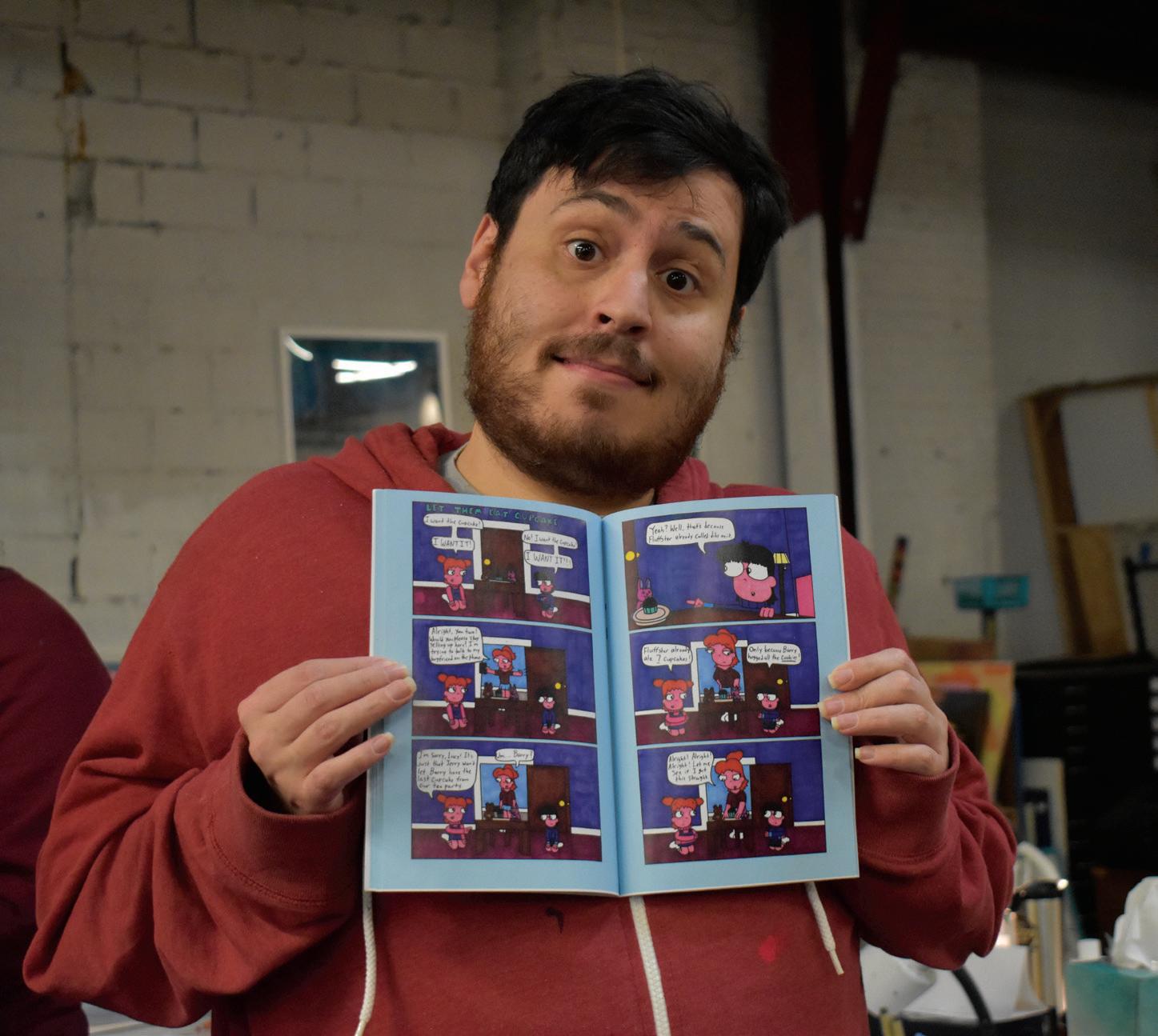
If you listed Lawndale Complex or the Lawndale Community Area on your Housing Choice Survey as a place you would like to permanently live, please read the information listed below.
& HCV PROGRAM PARTICIPANTS: PUBLIC COMMENT PERIOD FOR FY2025 MTW ANNUAL PLAN AMENDMENT
The Chicago Housing Authority (CHA) is scheduling a 30-day public comment period for a proposed FY2025 MTW Annual Plan Amendment related to the ground lease or sale of land at Altgeld Gardens for the future rehabilitation and expansion of the Up Top building by the non-profit By The Hand Club for Kids to expand their after-school programming.
The 30-day public comment period begins March 20 and ends April 18, 2025. All CHA residents and the community-at-large are invited to review the proposed Plan Amendment, attend the public hearings and submit written comments. You are not required to view or attend the public comment hearings to submit comments. Your presence or absence at the hearing does not affect your housing.
The Draft Tenant Selection Plan (TSP) and Lease for Ogden Commons, a mixed-income community is available for review. The Chicago Housing Authority (CHA) has worked with its development partner to develop a Draft TSP and Lease for use at the private development known as Ogden Commons (previous site of the Lawndale Complex). The units within this development will be used as replacement public housing units for Lawndale Complex and the Lawndale Community area. If you listed Lawndale Complex/Lawndale Community area on your Housing Choice Survey as a place you want to live or maintain a right to return to new CHA replacement housing per the Relocation Rights Contract (RRC), you can comment on the Draft TSP and Lease during the 30-day public comment period.
The 30-day public comment period will be held for CHA to receive written comments starting April 7 through May 7, 2021. The Tenant Selection Plans (TSP) will be available on CHA’s website beginning April 7, 2021.
CHA will host two public comment hearings—one livestream and one in-person:
Though snow is again on the forecast for Chicago this week, spring was definitely in the air the day I visited Arts of Life (AoL) for my Spring Theater and Arts feature story. Birds were chirping, plenty of people were out in T-shirts and shorts, and the colorful artwork being made in the studio was positively buzzing.
• In-person: Wed, March 26, at 6:00 pm Altgeld Gardens 951 E 132nd Pl (Sign and Spanish interpreters will be present.) Comments can be submitted in person.
Due to COVID-19, CHA has suspended all in person public meetings and instead, CHA will livestream one public comment hearing. The date and time of the public comment livestream hearing is as follows:
• Livestream: Mon, March 31, at 11:00 am www.thecha.org Live Comment Hearing (Sign interpreter will be present.) Comments can be submitted in the Livestream chat.
Tue, April 20, 10:00am: https://youtu.be/QBGG47BHXMg
A recording of the livestream session will be available following the hearing. If you require translation services, check with your property manager for more details or call the number below.
We ask that comments pertaining to the TSP & Lease be submitted electronically to commentontheplan@thecha.org at least 48-hours prior to the comment hearing. Comments will be read live during the time outlined above. Comments received after the hearing will be added to the comment grid.
The Summary and Proposed FY2025 MTW Annual Plan Amendment will be available on CHA’s website at www. thecha.org on March 20, 2025. You may also mail or fax comments for the Proposed FY2025 MTW Annual Plan Amendment All comments must be received by April 18, 2025.
If you require translation services, please read the attached notice or check with your property manager for more details. Do not mail comments to CHA.
Chicago Housing Authority
E-mail or Fax comments to: commentontheplan@thecha.org Fax 312. 913.7837
Attention: Proposed FY2025 MTW Annual Plan Amendment 60 E. Van Buren St, 12th Floor Chicago, IL 60605
Email: commentontheplan@thecha.org | Fax: 312-913-7837
Ifyouhaveaquestionaboutthisnotice,pleasecalltheCHAat312.913-7300. Torequestareasonableaccommodation,pleasecall312.913.7062. TTY 866.331.3603
If you have a question about this notice, please call 312-913-7300. To request a reasonable accommodation, please call 312-913-7062. TTY 866-331-3603
The organization, which provides artists with intellectual and developmental disabilities space to expand their practice, is celebrating its 25th anniversary with programming all year long. Opening March 28 is a group exhibition, “What they said,” co-organized by Bob Faust and Nick Cave of Facility at AoL’s Circle Contemporary gallery. Like all exhibitions there, works by AoL artists will be on view beside artists from the greater community. “We wanted to fi nd artists, Arts of Life artists, as well as younger, emerging artists from our network that we can put in conversation with one another visually,” Faust told me. He and Cave were delighted to learn that when they approached artists in their networks, presenting the AoL artist they wanted to pair them with, the artists immediately understood the connection.
“We’re connecting folks through primarily a formal lens of choice, with the hope that when they’re in the same room together, this opportunity during the opening just allows folks to get to know one another a little better and maybe be fueled by each other,” Faust said. Works on view will vary wildly in medium, from colored pencil and marker to hair extensions and beads. “It’s not a great commercial project, it’s a great social project at the end of the day.”
The rest of our Spring Arts section is also bursting with dynamism, from Reader staer Charli Renken’s celebration of Chicago’s drag kings to theater and dance editor Kerry Reid’s piece on the vital role of our performing arts coverage to Kat Sachs’ feature on the 24th annual Chicago Palestine Film Festival. By the time you pick up this issue, spring will have o cially sprung (hopefully Mother Nature gets the memo soon). With the dawning of the new season—and its promise of warmer weather, brighter days, and new life—there’s no better time to get out into the city and explore our cultural o erings. v
—Kerry Cardoza, culture editor m kcardoza@chicagoreader.com
Find more one-of-a-kind Chicago food and drink content at chicagoreader.com/food.
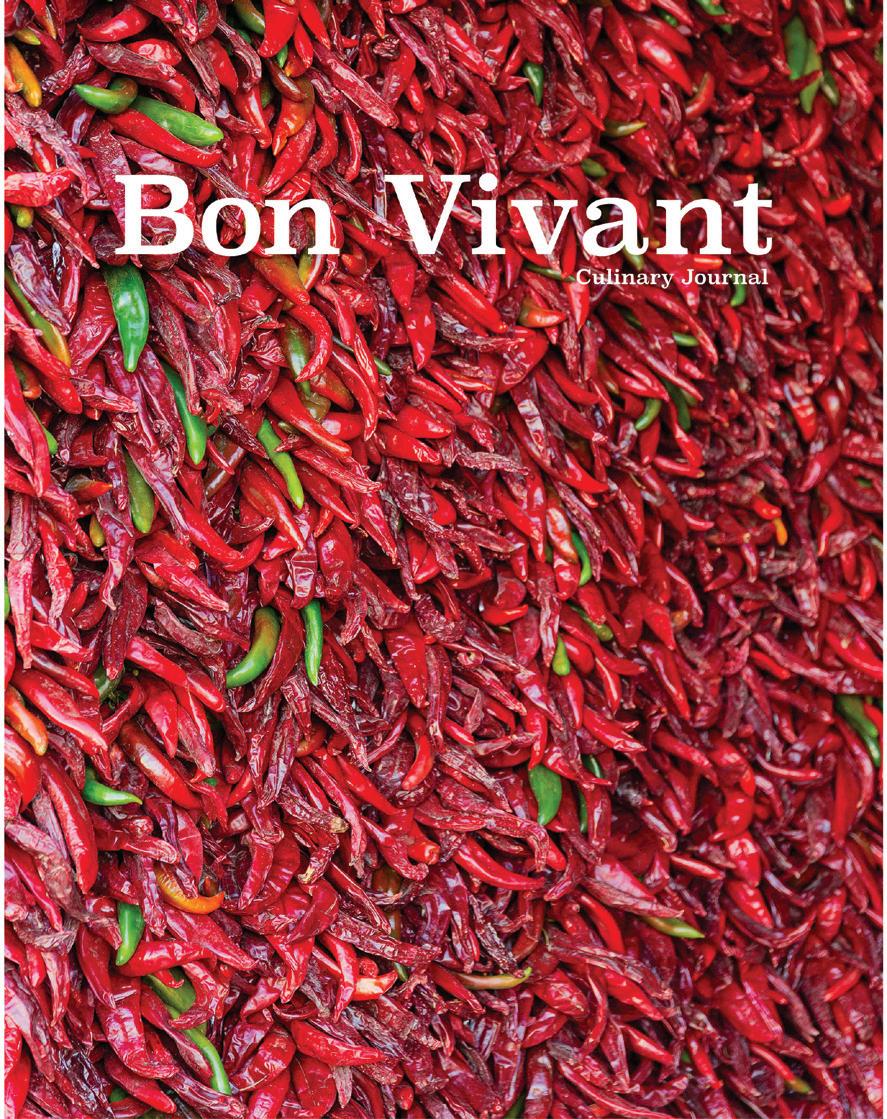


Enjoy them before paper is tariffed out of existence.
By MIKE SULA
There is a relatively small crop of Chicago food and drink books this spring (unlike last year). And only two of these new titles are available through the usual retail corridors. If they strike a fancy, please don’t reward the sniveling anticipatory obedience of the oligarchy by shopping online. Visit your local brick-and-mortar bookstore. For victory.
Bon Vivant Issue 7: Southwest Road Trip, Hugh Amano, editor (A Sterling Bay Production), winter 2025
It’s the end of the road for Amano’s biannual(ish) culinary travel journal. This one is a semisolo project of sorts: a 101-page essay tracking a road trip from Palm Springs to El Paso with photographer-designer (and his soon-to-be-spouse) Alexis Teichman.
I’ve been writing about the former Fat
Rice-Sterling Bay chef’s literary projects for 16 years, and as ever, they’re never just about the food (though a seed of inspiration for this final chapter came out of the Bobby Flay tribute at Next).
Amano’s words paint the sun-washed deserts, mountains, date farms, and diners of the southwest as vividly as Teichman’s photographs, and while the foods they encounter are certainly portrayed compellingly, just as often it’s about the brief encounters with the locals within. Eight recipes inspired by these joints bring up the rear (carne adovada, stacked enchiladas, flautas), but it’s not a guidebook— you’ll have to Google the addresses yourself.
Instead, like all the issues of Bon Vivant past, food is the natural vehicle for understanding and empathizing with the culture that created it.
So why stop now? This road trip is to be suc-
ceeded by another, to Bozeman, Montana, where Amano and Teichman are moving this spring.
“It takes some of the pressure o turning 50,” he told me. “I don’t want my body breaking down in any kind of food service job. I’m always pursuing that fantasy of just writing books.”
To that end, you can look for the next one in the spring of 2026 when his cookbook collaboration with Atlanta chef Ron Hsu rolls o the presses.
Unfortunately, if you haven’t scored a copy yet, you can’t get your hands on Bon Vivant Issue 7 anymore. Just like Amano, come April, it’s gone.
The Balls (Le Polpette), Alfredo Ramos
Perhaps the roughest of the crop is this self-published memoir/cookbook by the chef of Andersonville’s rustic Italian Bar Roma—and
that’s a good thing. Unpolished but earnest, it recounts in 49 pages Ramos’s rise from pot-smoking southwest suburban skid, to pot-smoking Kendall College overachiever, to peripatetic kitchen journeyman, to opening chef—and for the past nine years, head chef—at Bar Roma, which is where you can buy the book.
The title refers to the restaurant’s signature meatball repertoire. Six of them are represented, along with a fetching collection of classic and innovative Italian recipes, plus a few curveballs, like weed-infused dark chocolates that suggest Ramos still has a bit of the skid left in him. Ramos is also old-school without coming o like a goon, and frequently hilarious in a way not often encountered in restaurant lifers anymore. In his intro, the chef admits his inspiration for writing was to keep his daughter out of the industry (it didn’t work), and in his acknowledgments, he thanks his editor for eighty-sixing “some of the dumb, sick, childish, words and stories I told.” I wish that editor would have paid more attention to sentence structure and less on preventing Ramos from being Ramos.
Birrias, Jesse Valenciana, the Quarto Group
Now based in Nashville, where he caters under the name Secret Bodega, Chicago-born Valenciana previously published two cookbooks
continued from p. 7
with Crust Fund Pizza’s John Carruthers while working as the national events manager for Goose Island. He admits he was turned o by the traditional Jalisciense goat stew as a kid and didn’t develop a passion for it until the pandemic. That was well into the crispy birria/ melted cheese taco craze that, via 80s Tijuana, erupted out of Los Angeles four years earlier. For better or worse, that trend has led most Americans to believe that birria is strictly made from beef. In fact, Mesoamericans made something like it from wild game, according to Texas Monthly taco editor José R. Ralat. Further, birria is not an ingredient, but a technique, employed in various Mexican regions with chicken, fish, and pork, in addition to goat and beef. Valenciana understands all of this without getting too bogged down in the details, o ering variations on all five proteins in every possible execution, from birria tacos, burritos, and ramen, to sausages, smashburgers, Chicago-style pu s, and crunchwraps.
Chicago Cocktails: An Elegant Collection of Over 100 Recipes Inspired by the Windy City, Nicole Schnitzler, Cider Mill Press
Part of a series of hardcover cocktail collections from around the globe, the Chicago entry very loosely organizes its recipes in neighborhood clusters. On its face, that promises a varied representation of the creative diversity that has evolved behind the city’s sticks ever since the Violet Hour ushered in the modern cocktail renaissance in 2007. And sure, there’s
a fair mix of old and new, like Q&As with OGs like the VH’s Toby Maloney and Crafthouse Cocktails’s Charles Joly, and relatively newer players like Julia Momosé of Kumiko and Bronzeville Winery’s Cecilia Cu . And yet, I’m not sure how many home barkeeps are clamoring for four separate espresso martini builds, or five old-fashioneds, especially when there are only five south-side cocktails represented (two of them from one bar) and only one Malört recipe, which is especially weird when the intro devotes a whole page to acknowledging its influence on the city’s cocktail maturity.
Bridging the Gap: Ethiopian Fusion Cooking: Recipes from the Kitchen of Wilhelmine Stordiau, by Wilhelmine Stordiau and Harry Kloman
I wouldn’t typically include a free download from a retired University of Pittsburgh journalism professor in this roundup (even if I hadn’t taken his class as a freshman), but there is a Chicago connection: a recipe for tefach injera, or “injera bread pudding” from Zenash Beyene, owner of Edgewater’s Ras Dashen, which closed in 2022. It was on the menu, but it’s unusual, given there’s no Amharic word for “pudding,” nor are there any desserts native to Ethiopian cuisine.


The text itself is singular, given that Armenian Ethiopian entrepreneur Stordiau, who
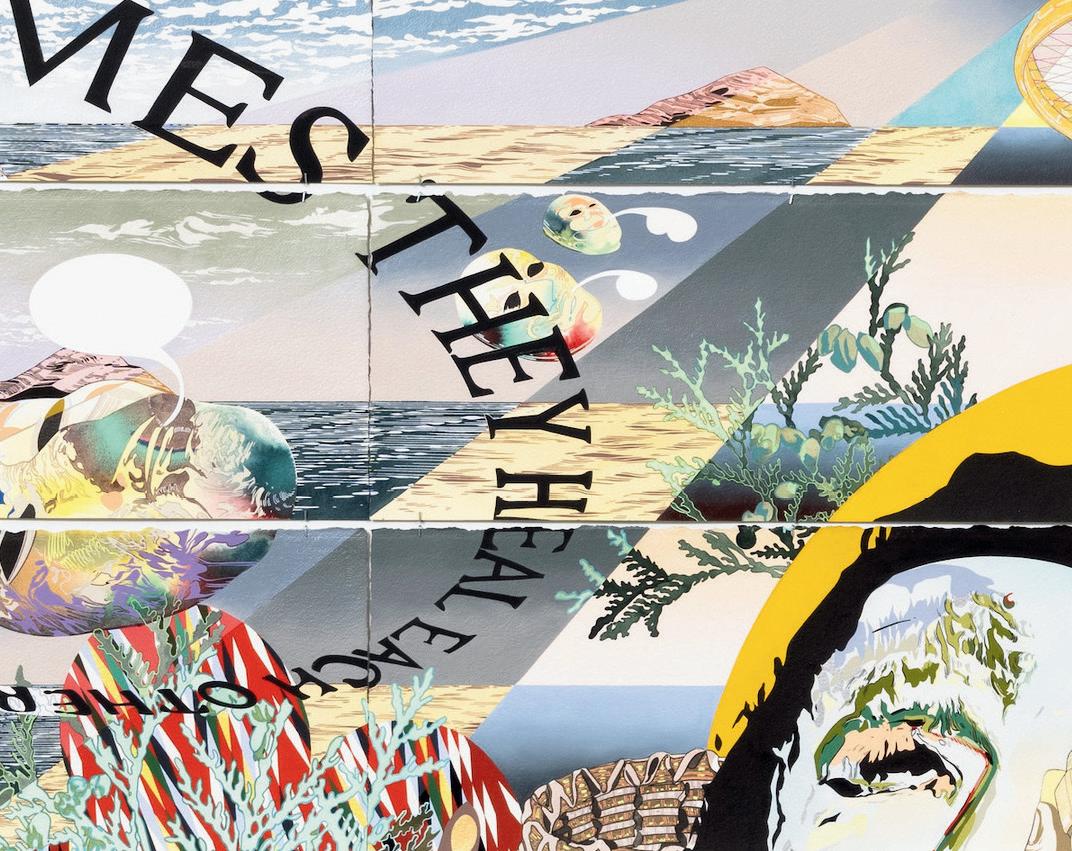
lives in Germany, has developed her own repertoire of hybrid dishes, applying Ethiopian flavor profiles and techniques to European foods, like berbere deviled eggs, penne with minchet abish wot (spicy chopped beef), or cracked wheat and sa ower milk risotto. There’s even a chapter devoted to desserts, in defiance of Ethiopia’s lack of a “sweets culture.”
Kloman is, of course, the author of Mesob
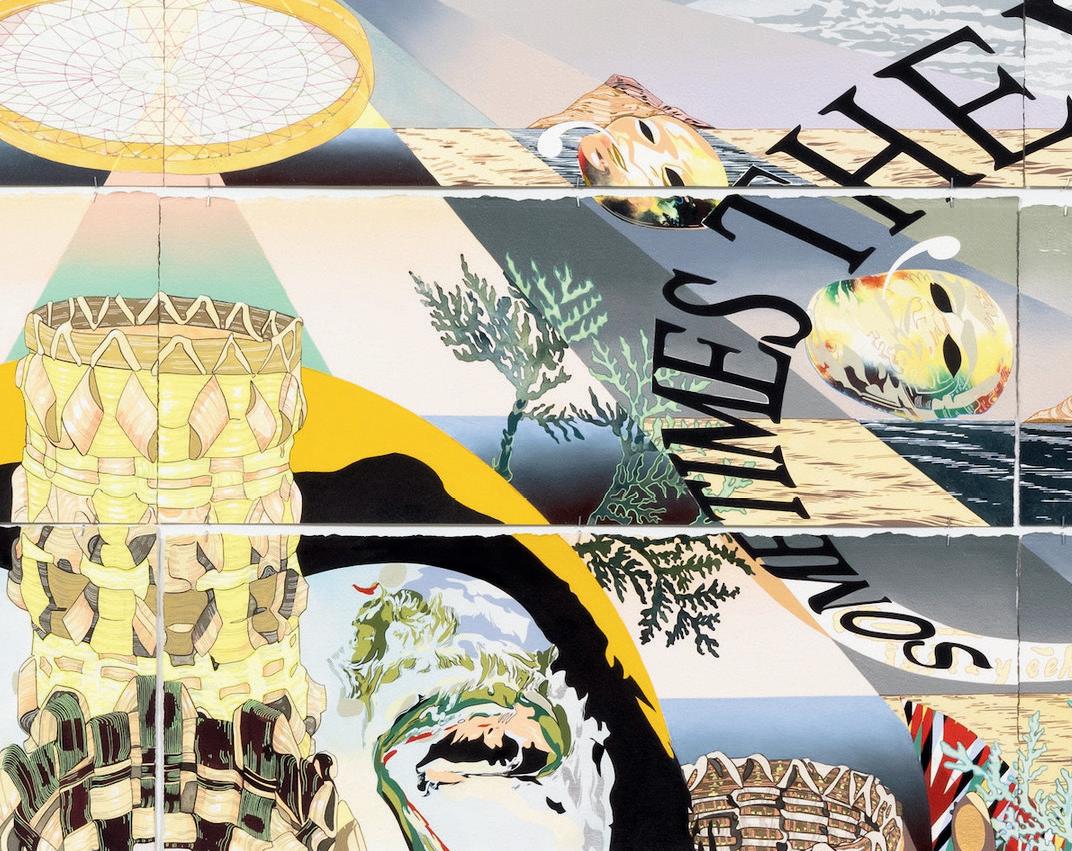

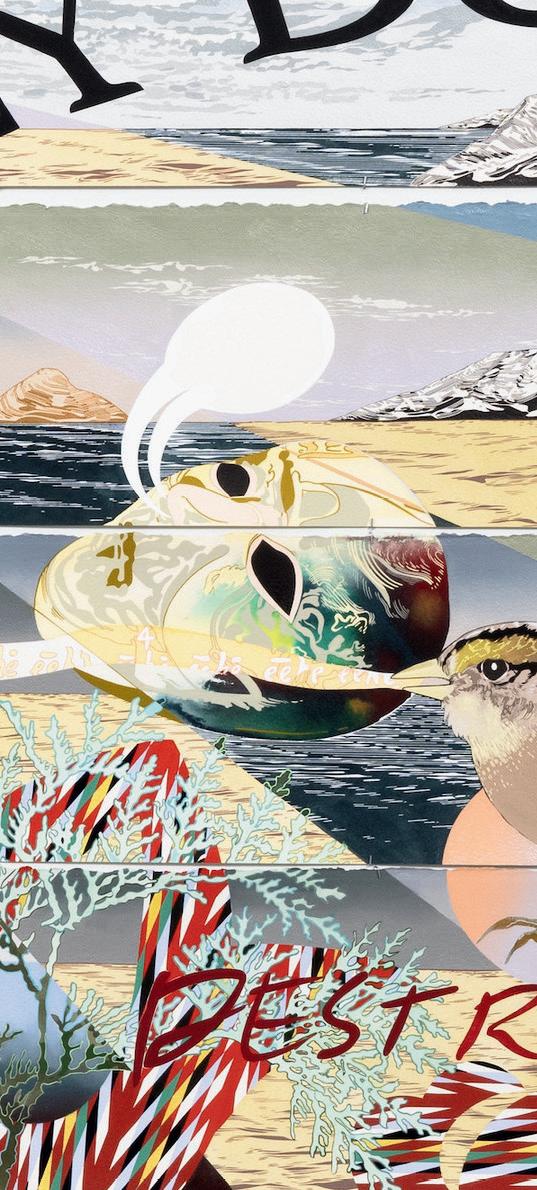
Across America , a survey of Ethiopian food across the U.S., and probably knows more about the subject than any other nonEthiopian. As the tipster who alerted me to Uptown’s terrific Oromo Michuu Restaurant, he often knows more about Chicago’s East African restaurant doings than I do. v
m msula@chicagoreader.com
January 25 - July 13, 2025



Trump’s assault on higher ed
Donald Trump and his cronies are continuing their fascist assault on higher education. In recent weeks, the federal government has announced multiple probes into Chicago-area universities intended to stifle dissent and expel immigrants and other marginalized students.
The Department of Justice, under former Florida attorney general Pam Bondi, notified the mayors of Boston, Chicago, Los Angeles, and New York on March 13 that it was escalating retaliation against pro-Palestine demonstrations on college campuses. Justice department agents, under the guise of the Federal Task Force to Combat Anti-Semitism, plan to visit each city and meet with local leaders, students, law enforcement, and residents to determine “whether federal intervention is warranted,” according to a press release.
Northwestern, already under investigation by the U.S. Department of Education for a pro-Palestine encampment that cropped up at the school last April, appears to be copying Columbia’s strategy of appeasement in the face of Trump’s attacks. Northwestern has scrubbed mentions of “diversity, equity, and inclusion” from nearly all its webpages and assigned students a mandatory “anti-bias” training, according to WBEZ, that at one point equates criticism of Israel with comments made by the Ku Klux Klan’s David Duke. Separately, the education department on
March 14 announced civil rights investigations into more than 50 colleges for their supposed antiwhite admissions practices. Most of the schools, including the University of Chicago, are under fire for their partnerships with the PhD Project, a nonprofit that recruits students from underrepresented backgrounds into graduate business degree programs.
On March 12, the City Council voted to approve $3 million to settle four separate lawsuits related to police misconduct. In recent years, alderpeople have spent hundreds of millions of taxpayer dollars to resolve allegations of wrongdoing by the Chicago Police Department (CPD).
The most expensive settlement, $1.5 million, stems from a fatal car crash in February 2020. The family of Ezell Ricky Island sued the city after he was thrown from the back seat of a car and killed when he was hit during a chase by police in an unmarked car.
A second settlement, for $1 million, will be paid to the family of Mignonne Robinson, who was struck and killed in February 2020 by a car fleeing the CPD.
Alders also approved $400,000 for Eyraechel Meiang. In 2020, a Chicago cop drove through a red light and hit Meiang with his cruiser. WGN reports the officer driving the vehicle, Charles Gavin, is no longer on the
owned by First Trinity Community Church, according to a petition calling on the building owner to stop the eviction. The church voted in 2023 to close the Orphanage and sell the property. But groups, including Midwest Books to Prisoners, Commodore Comunitario, a free store, and a pop-up community clinic, have continued to operate. They’re now hoping to pressure the new owner, identified as Howard Mui, to keep the space open.
PETITION: DEFEND THE ORPHANAGE, DROP THE EVICTION openpetition.org/!txmgl
The Orphanage has been open for more than two decades and has hosted hundreds of events, from punk shows to film screenings to skill-shares. “If we lose The Orphanage, we not only lose our one of a kind space, we also lose a piece of Chicago organizing history,” the petition reads.
city’s payroll.
A fourth payment, for $280,000, settles a lawsuit from Miracle Boyd, whose tooth was knocked out by CPD officer Nicholas Jovanovich during a fraught protest at the since removed Christopher Columbus statue in Grant Park. With the settlement in Boyd’s case, the city has spent nearly $8.7 million on misconduct lawsuits stemming from 2020’s protests against police violence, according to WTTW.
In 2024, Chicago spent at least $107 million to settle police misconduct lawsuits, WTTW reported, far exceeding the $82 million officials set aside last year for CPD litigation.
Supporters of the Orphanage, a longtime Bridgeport community space and DIY venue, are fighting to save the building from demolition.
Midwest Books to Prisoners, an organization that mails books to incarcerated people across the country, said in an Instagram post on March 16 that the venue is “under imminent threat of eviction.” The group has operated from the Orphanage since the 2010s, but they—and Comedor Comunitario, which serves weekly meals to recent migrants—are looking for a new space in case the owner follows through with plans to demolish the property.
The community center was previously
The Chicago Transit Authority (CTA) is moving forward with plans to install artificial intelligence (AI)-powered cameras aboard buses as part of a pilot to automatically ticket drivers for parking in bike and bus lanes. On March 12, the Chicago Transit Board approved a contract with Hayden AI to deploy the company’s automated bus lane enforcement (ABLE) system on six buses. The system uses onboard cameras with “computer vision” to gather photos, video, license plate information, and more from cars illegally parked or standing in bus or bike lanes. The cost for the first six buses is $315,852, according to a CTA press release, though the contract allows the agency to purchase up to 94 additional cameras.
The city launched the pilot project, called Safe Streets, in November through the Chicago Department of Transportation. The two-year test run is limited to violations within the downtown business district. According to the CTA, the city issued more than 11,000 warnings and nearly 1,400 violations through the end of February. (Drivers are first given a warning; subsequent violations result in fines.) —SHAWN MULCAHY v
Make It Make Sense is a weekly column about what’s happening and why it matters.
m smulcahy@chicagoreader.com
Helping artists with intellectual and developmental disabilities expand their practice
By KERRY CARDOZA
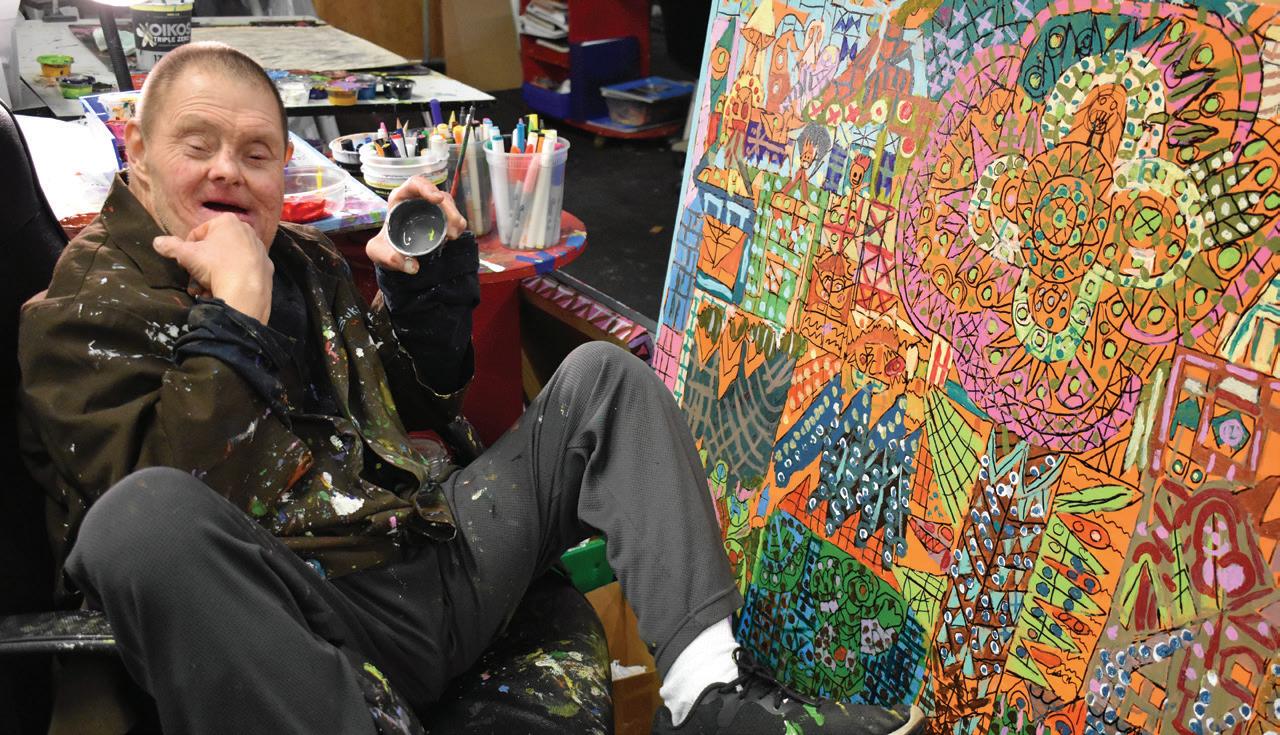
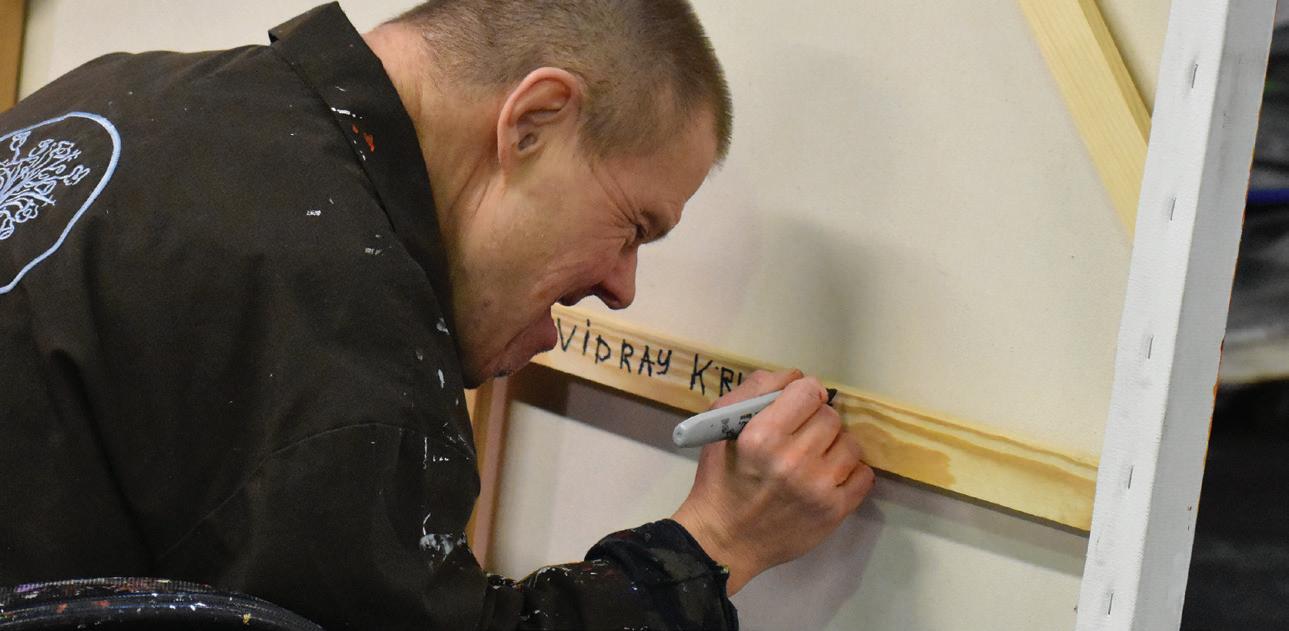

An artist in paint-splattered black clothes puts the finishing touches on a busy, vibrant acrylic scene on an oversize canvas. Nearby another artist—a face mask tucked beneath her chin—leans over a comic-like illustration, carefully coloring in the black outlined drawing with green marker. At another group of tables, an artist is cutting up pieces of cardboard for use in a sculpture while a colleague to his right finishes up a pristine marker illustration featuring saturated blocks of green, yellow, orange, and gray. Other artists mill about the studio; some are wrapping up pieces or preserving the day’s work on their storage shelves.
It’s a typical Monday afternoon at the West Town location of Arts of Life (AoL), a progressive art studio founded 25 years ago. The bustling space exemplifies Arts of Life’s simple yet visionary mission: to provide artists with intellectual and developmental disabilities “a collective space to expand their practice and strengthen their leadership.” Here, artists have the autonomy to make the work they want to make, to develop their artistic voices and creative practices alongside their peers, and to further their careers through a number of professional opportunities. All decisions are made collectively, and the program is open to all applicants, whether or not they have previous artmaking experience.
“A lot of what we’re trying to do is to help the artists just have confidence in their own ideas,” said Tim Ortiz, AoL’s program director. “They’re not taught that in other places. And people in this population—they don’t learn to spend time on things that are their own. That’s what’s di erent here. . . . A lot of what we do is just encourage people to try. We try to notice what their interests are creatively and help them to take those things further.”
Founded in 2000, AoL is a beacon of joy in the largely underfunded, and at times abusive, landscape of disability services in Illinois—a state that consistently receives low marks for its efforts to serve people with disabilities. AoL is the first, and still the only, state-licensed community day program in Illinois with a focus on artistic career opportunities for adults with intellectual and developmental disabilities. The organization is celebrating its 25th anniversary through a yearlong series of programming, which kicked o February 22 with a party and a book launch for 2wenty-5ive, a beautifully designed hardcover that tells the history of AoL and highlights the practices of 25 of its artists.
As Nik Heusman, a longtime AoL artist, says about the importance of the organization in 2wenty-5ive: “I can come here and let my hair down and just go to town on art. I want to get my art out there into the world. I want people to see me as a person instead as a person with a disability. I want them to see that a person who has vision problems can accomplish anything in the world.”

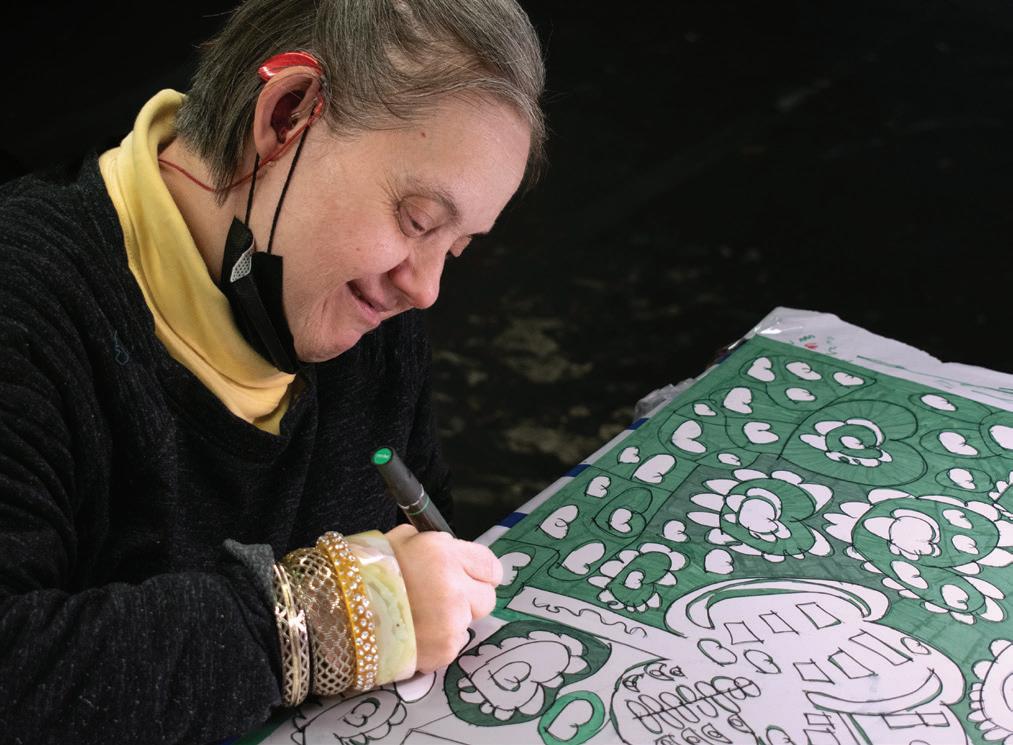
Arts of Life’s collaborative, artistcentric model dates back to its very beginning. In the late 90s, cofounder and executive director Denise Fisher was working in residential services for adults with developmental disabilities in Chicago’s north suburbs. Through that work, Fisher became friends with her neighbor Veronica “Ronnie” Cuculich, one of the residents and a lifelong maker. Cuculich and other residents had found relief working on art projects at home. When the agency Fisher was working for was slated to be absorbed by a bigger one, it felt like the perfect time to pitch a new project: a day program devoted to making art. “I went and talked to families that I knew in the organization, and found other people that were interested,” Fisher said.
They began working on the project in 1999 and, in 2000, opened the first location, on West Grand. (It was founded by Cuculich, Fisher, and a colleague along with nine additional artists; Cuculich died in 2010.) “In the early
R“ What they said”
3/28-5/9: by appointment Mon–Fri, 10 AM–3 PM, circlecontemporary@artsoflife. org, Circle Contemporary, 2010 W. Carroll, artsoflife.org/event/what-they-said
R“Arts of Life: 25th Anniversary Retrospective”
8/ 11-9/30: open daily 10 AM– 5 PM, Design Museum of Chicago, 72 E. Randolph, designchicago.org/arts-of-life-25thanniversary, free
RA rts of Life annual benefit auction
10/3 Epiphany Center for the Arts, 210 S. Ashland, more info at artsoflife. org/25th
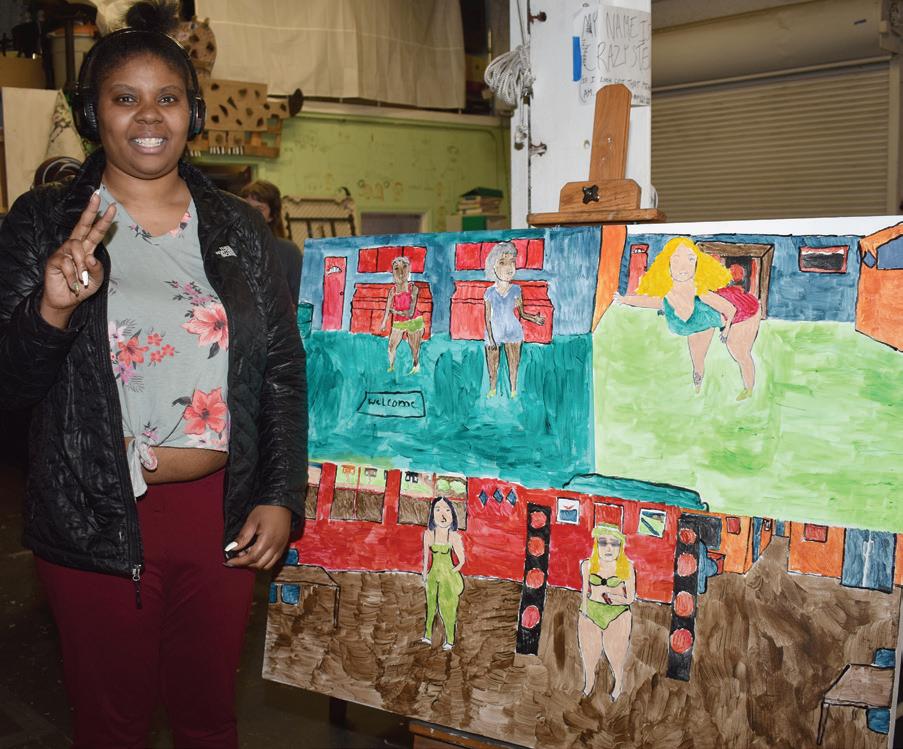

Founded in 2000, Arts of Life is a beacon of joy in the largely underfunded, and at times abusive, landscape of disability services in Illinois.
days, we were just kind of putting it together,” Fisher said. “We were small enough that I would meet with all the artists weekly and kind of just ask open-ended questions about what they wanted.”
This is how AoL’s four core values—inspiring artistic expression, building community, promoting self-respect, and developing independence—were formed. After a year, the sta looked at the data from those conversations and realized these were the things people were consistently bringing to their attention.
“A lot of the people early on had institutional backgrounds,” Fisher said. The artists often didn’t feel like their peers were that helpful “because they had come from institutional settings where really the staff had all the power.” So in the early years, the organization worked to undo those dynamics, getting artists to collaborate.
“Once that was set, we started to realize that what we were talking about more often was integrating the broader arts community, that our artists were in the kind of ‘outsider’ label that’s inappropriate and really dated,” Fisher said. (The term “outsider artist” typically refers to someone with no formal art training and little to no influence from the mainstream art world, but it has fallen out of use in recent years as a needless and outdated categorization.) The organization reenvisioned its mission statement to build in leadership and development in the art sector. From serving ten artists in one studio space, AoL has grown to serve over 60 artists across three studios (in West Town, Woodlawn, and Glenview), alongside integrated community classes at Evanston Art Center and the Art Center Highland Park and an in-home support program. (Approximately 150 artists have
worked at AoL since its inception.) In 2017, the organization launched the Artist Enterprise Program, a professional development arc that allows artists to opt in to the vocational tracks of maker, curator, educator, or career, and also works to expand professional opportunities to exhibit and sell work. While artists at AoL do pay a fee—most pay through a Medicaid waiver program though some pay out of pocket—they also receive a monthly stipend based on their attendance and 60 percent of revenue from any works sold.
In the past several years, AoL has begun bringing artwork to art fairs around the world, from EXPO Chicago to New York’s Outsider Art Fair to Art Fair Tokyo. Around seven exhibitions per year are held in AoL’s Circle Contemporary gallery, housed inside its West Town location. Featuring both AoL artists and artists from the greater art world, the exhibitions are put together by guest curators and artists from the organization’s curatorial committee. (The next big event for AoL’s anniversary programming is a group art exhibition, called “What they said,” opening Friday, March 28, at AoL’s Circle Contemporary gallery and cocurated by Nick Cave and Bob Faust.)
2019 Circle Contemporary show called “All Well and Good” with her and fellow AoL artist Tim Stone. The title stems from a conversation Ruschman had about the show with Pasowicz, where she asked him (a fervent admirer of bright colors, or “my wheelhouse,” as he describes it): “Well, color is all well and good, but what about a gray show? With a disco ball in the middle?” Though that ultimately wasn’t the exhibition Ruschman put together, he was struck by Pasowicz’s energy and talent.
“I just am really drawn to—and this is deeply embedded in her work, as well as her personality—that she is capable of holding all of this like candy-coated joy, Hello Kitty sunshine-like stu alongside something that’s darker, something that’s a bit more mysteri-
“I can come here and let my hair down and just go to town on art.”
ous,” Ruschman said. This shows up in Pasowicz’s gorgeous, time-intensive colored pencil drawings, made by making layers upon layers of marks. The result is often a subtle gradient of pastel colors, sometimes with a black floating orb in their midst.
AoL artists are often invited to show at other galleries or institutions, such as the 2023 Intuit Art Museum exhibition, “Hand Drawn Circle: Arts of Life studio past and present.” That same year, Ruschman gallery hosted a solo exhibition of work by AoL artist Susan Pasowicz, who has been a studio member since 2013. Eric Ruschman fi rst got to know Pasowicz when he was organizing a
Some of those marks are made by tracing a Slinky over and over again, an ingenious technique that Pasowicz told me was “just an idea.” “You could do it with other things, like a square. . . . Doesn’t really have to be a Slinky. Just an idea in my head that I made.” Ruschman has sold some of Pasowicz’s work to collectors and praises AoL for working to get her art seen outside of the city, a “necessary next step for Sue’s practice.”
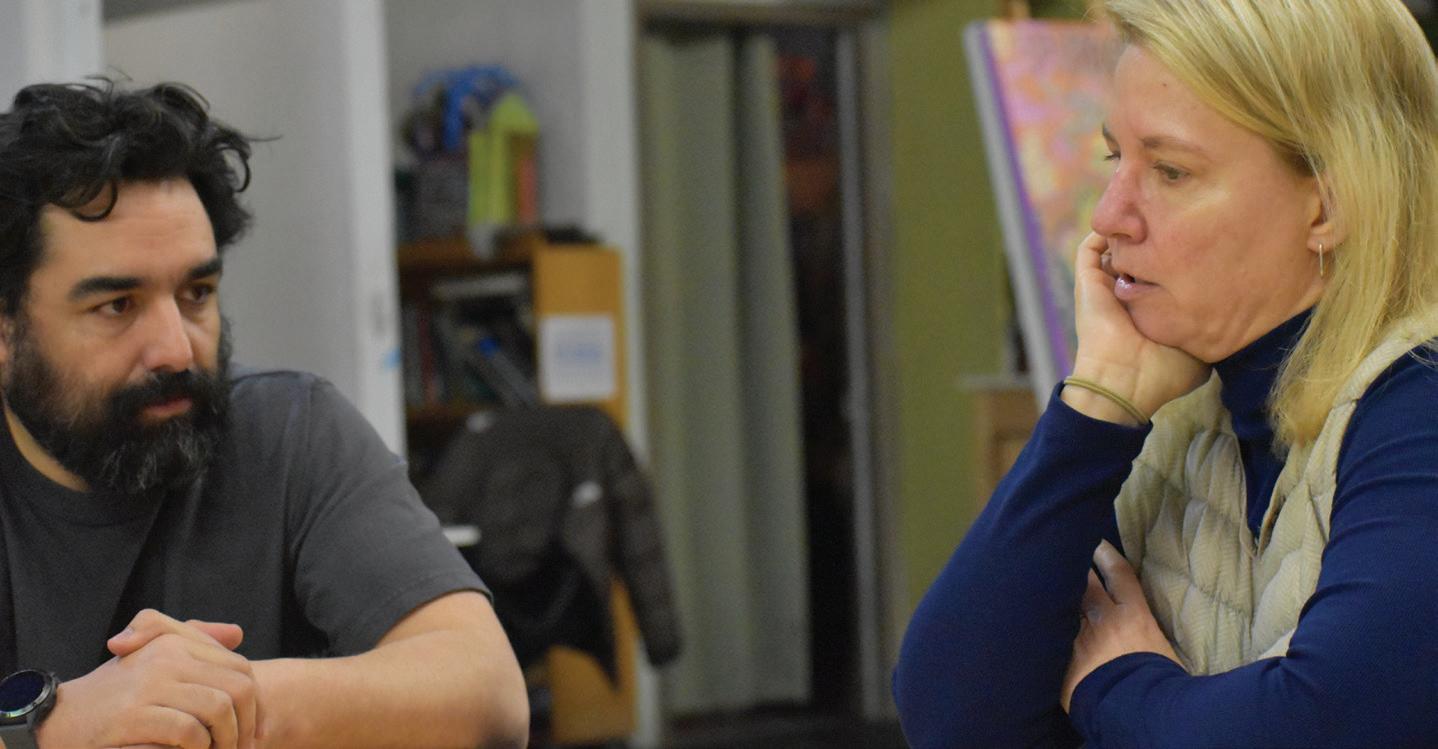
continued from p. 11
When I visited Arts of Life, it was the first appreciably nice day of late winter, and the weather made the mood feel extra buoyant. Many of the artists were eager to share their work with me. Rocco DiCaro, who joined AoL in 2023, showed me Emily! (and Jerry and Lucy): Emily’s Family Fun Tales, a book of hand-drawn comics that he laid out himself and self-published through Amazon. It features 15 stories about a little girl named Emily and her family and friends. “It’s kind of in the style of Peanuts,” DiCaro told me, adding that he’s at work on a second volume.
While we were chatting, his tablemate Stefan Harhaj chimed in to boast about DiCaro’s YouTube channel, which shows how he makes his comics. I was familiar with Harhaj’s work from 2wenty-5ive ; his drawings and paintings have a folk art aesthetic, often depicting the natural world or simple, repetitive abstractions. Now he mostly makes sculptures.
the top of the diorama-like piece, a sign reads, “Arts of Life come do your artwork here.” Her latest work was in honor of the organization’s recent trip to New York City, where they had a booth at Outsider Art Fair and a book launch party at Soho House. The sculpture had a background of apples, printed from the Internet, with a rectangular block mounted on a waterlike base featuring the Statue of Liberty. Overlaid over the water were the words: Arts of Life takes New York.
“A lot of what we’re trying to do is to help the artists just have confidence in their own ideas.”
Also working at their table was William Lilly, who works primarily in marker, so as to not mar his impeccable clothing. The charming artist—also known as “Shotgun Lilly” due to his preference for the front seat—is a devotee of metal; he implored me to check out the song “Carrie” by the band Europe, as well as the ballad “Truth” by Godsmack. Music inspires his artwork—many pieces feature the names of his favorite bands—as do tornadoes.
Tatiana Adams brought me around the studio to view her cardboard sculptures, including one featuring all the Arts of Life artists. At
Melissa Leandro creates an intricate, intimate textile world at Andrew Rafacz.
Viewing Melissa Leandro’s “Auto Alejaimento” is like stepping into a dissonant oasis. Her third solo exhibition at Andrew Rafacz, the show weaves detachment through layered textile landscapes. Pieces combine woven cloth, hand and machine stitching, yarn, embroidery, couching, and foil to create textured scenes of flowers, grasses, and waters. From a technical standpoint alone, the work is striking: using only textiles, Leandro conveys scribbling, dripping, glowing, and decomposing. Bright threads pour down from flowers’ centers and out the sides of gray leaves. Yarn delineates air trails, then falls before reaching the canvas’s end. It’s all so elaborately burnt out.
The room–garden is completed by two inverted, functional art benches that face the most colorful of the works—Let Me Stay Here (Déjame Quedarme Aquí) and See Me (Verme), leaving darker pieces such as the diptych Blemished (Manchada) / Rip to Pieces (Romper en Pedazos) looming on the periphery of the bench-sitter. And yet, sitting long enough to become acquainted with these bright landscapes reveals their unease:
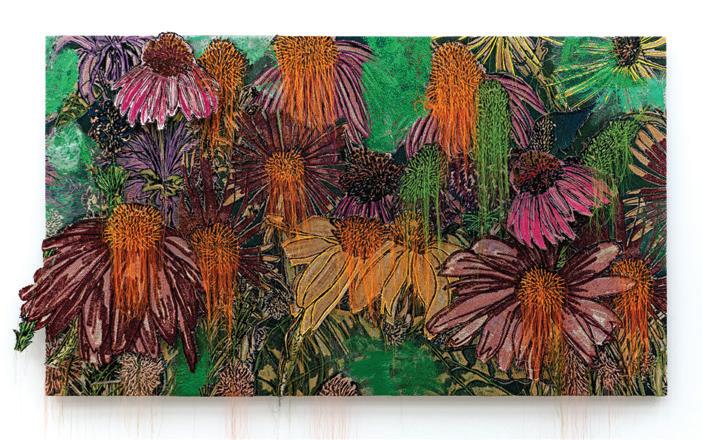
plants stuck in the second dimension while identical counterparts break through; broken floral pieces messily threading into one another; forms that reach beyond the canvas but do not make it far. Regardless of the color palette, there is no winning here.
Nonetheless, while immersive in its (titular) selfestrangement, the exhibition is not overstimulating. The space is still a warm and quiet respite, particularly during your typical Chicago winter-spring snowy-rainy day. It’s a welcome opportunity to sit and soak in Leandro’s intricate, intimate textile world. —SHIRA FRIEDMAN-PARKS “Auto Alejaimento” Through 4/12: Tue–Fri 10 AM–5 PM, Sat 11 AM–5 PM, Andrew Rafacz, 1749 W. Chicago, andrewrafacz.com/exhibitions/18489-2 v
What was clear after talking to these artists was that they take their practice seriously and that they value the time they spend at Arts of Life. “It’s a way to express yourself, and I like drawing, I like painting,” artist Alysha Kostelny said about coming to Arts of Life. Lilly told me he likes “the people and the art.” Adams used to draw before coming to AoL, but said, about her cardboard works, “This is better art.” In a written statement, North Shore studio artist Ariée Carter wrote, “I love being part of AoL because they are my third family.”
“When our artists define the nature of their work, including its success, they will have just as much to o er as any other person, and just as much chance of doing great things,” Ortiz writes in 2wenty-5ive , an apt summation of the organization’s overriding ethos. “This is validated in our studios every day.” v
m kcardoza@chicagoreader.com


When I debuted as my drag persona Vicious Mockery in the variety show Glamorama at My Buddy’s earlier this year, I was lucky to be on a bill of mostly other drag kings. Celebrated kings Switch the Boi Wonder and Bubba Boom made up the bill, as well as my drag brother Jest Kidding. Partially due to my brother and I debuting, my drag mother, Zenon TeaVee, wanted to bring together some of the best kings in the city for us to learn from. Of course, that wasn’t the only reason she booked them; she also knew they were great performers and would make for an awesome show. It was a wonderful experience being backstage with mostly kings.
I say I was lucky because, unfortunately, a show of mostly kings isn’t really the norm. But that is starting to change, thanks to several kings working to increase our visibility locally and internationally.
Drag kings are often token performers on a bill, something that gets real lonely, real fast. If we’re in a show at all (and we struggle to get booked compared to queens), we’re usually the only performers of our kind, and audiences don’t always know what to do with us. When it comes to drag, the general public thinks of RuPaul’s glitzy, pageant-ready queens strutting down the runway. They don’t usually think of masculinity, and that’s partially because, in 16 seasons, RuPaul’s Drag Race has never featured a drag king. To many viewers, drag means cis men dressed as women because that’s primarily what’s on television, though the show has showcased openly trans performers in recent years (but not without a fight from RuPaul).
It’s not all RuPaul’s fault drag kings aren’t booked as often as queens, though. There are a lot of factors that go into the pay disparity and lack of opportunities for drag kings. Every king I spoke to for this article had different ideas about why that is. Unfortunately, there isn’t a lot of research on the economics of drag (the one paper I did find on the subject likened drag to blackface, so I wasn’t inclined to believe the researcher understood our community), so you’ll have to take kings at our word that our bag is less full.
“I think there’s a disparity in booking fees in nightlife in general, but when it comes to kings, I just assume that most likely the payment is going to be less based on what people ask me to perform for,” says Po’Chop, drag king, performance artist, and cofounder of Black feminist art space House of the Lorde. “I think it’s also hard to gauge because there’s not a lot of transparency about the overall

learned to swallow over time.”
Switch, who has been a drag performer for 20 years and coproduces and cohosts the king-centric show Notes on Masculinity at the California Clipper, says sometimes show hosts fail to get crowds excited about kings.
“If you’re not gassing [kings] up on the mike, if you’re not telling audiences what to expect and getting them excited, like, ‘Get those dollars ready! This is gonna be a hot one!’ you’re not setting those kings up for success,” Switch says. “You’re basically just checking a box like, ‘Well, I put them on a stage. I did my part.’ That’s just not good producing.”
Chicago performance artists are creating community and advocating for more opportunities.
By CHARLI RENKEN
budget producers have and how it’s being broken up.”
Other drag kings I spoke to said they felt they were paid the same booking fee but that when it came to tips, queens definitely made more.
“I just had this experience recently at one of the bigger venues I’ve performed at. The lineup was mostly femme presenting, and when I
got onstage, people were like, ‘Huh?’” Chicago king Monsieur Bombastic says. “There was this one woman in a red dress who was just tossing away money [for the other performers], and when it came to me she literally flashed her cash at me and then tucked it away. I get that treatment quite a lot as the weirdo alternative drag king and it’s something I’ve
Making audiences more excited about drag kings is just one part of the puzzle of fixing the disparity between kings and queens. Greater visibility is needed to get more kings onstage and paid better.
“I still get people coming up to me being like, ‘Oh my god! You’re the first drag king I’ve ever seen!’ and it’s like, ‘Yeah, thanks . . . been doing it a while,’” SKIM, Vancouver drag king and creator of the original Book Drag Kings project, tells me. Experiences like that are part of why he created the photo and video project, which aims to bring more visibility to the drag king community.
The Book Drag Kings project started, as art often does, out of grief. SKIM had just performed at Burnaby Pride with prominent drag artist King Fisher. Not long after, Fisher passed away at the age of 25.
“I realized that we had only ever done that one performance together because kings just never get booked together,” SKIM says. “After he passed, I just felt such despair and loneliness, and I realized that in our community we weren’t really talking to each other.”
SKIM was moved to change that. He organized community social gatherings as well as skills workshops on subjects like contouring. Later, with the help of the Long Live Kings collective, Tinydog Studio and Gallery, photographers Ray McEachern and Dayna Finkelstein, and videographer Chris Reed of Queer Based Media, SKIM organized photo and video shoots, and the Book Drag Kings project was born.
Back in Chicago, SKIM’s collage of photos from the project came across Switch’s Instagram feed and inspired them to bring the project to our city. They immediately messaged SKIM to ask for permission and, once granted, started pulling the project together with Po’Chop, their collaborator and cohost of Notes on Masculinity. They decided that the photo shoot would take place at the California Clipper–hosted show, and kings across the
King-centric Shows in Chicago
Note: Not every show is kings-only, but each heavily features drag kings. This is also not an exhaustive list.
Notes on Masculinity
Second Tuesday of every other month at the California Clipper, hosted by Po’Chop and Switch the Boi Wonder
Brewz with the Boyz
Second Saturday of every month at Uptown Taproom, hosted by Annx
Hunks: A King Show
Periodically at the Newport Theater, hosted by Harley Go’Lightly and Harry Ola
Open Cabaret: Kings-Only Edition
Usually during the summer at the Newport Theater, this year’s host TBA
city were encouraged to show up to have their photo taken with a sign bearing the simple instruction: “Book Drag Kings.”
The Chicago project, which has now had two shoots at Notes on Masculinity, was photographed by Greg Inda, who is also the cabaret’s resident photographer. Normally, he takes photos of performers both on- and backstage, something Switch and Po’Chop organize because kings often struggle to get professional photos taken.
“I don’t know that it’s necessarily that photographers don’t want to photograph kings, but there’s definitely some kind of barrier there that kings don’t get asked to do photo shoots as much as queens do,” Inda says.
That’s just one part of what makes Notes on Masculinity, which next month celebrates its third anniversary, such a special show. Every detail Switch and Po’Chop put into the cabaret creates a space where kings and other artists exploring masculinity (the show features all kinds of performance, not just drag) can thrive.
“It’s amazing that kings are deciding not to wait to get booked but creating shows and spaces themselves,” Switch says. “That’s what Po and I have done with Notes—create a space we would want to perform in.”
Most of the kings I spoke to said that the number of bookings they received has gone up since being part of the project. Producers across the city are starting to take notice of the many kings here and put them in shows.
“I’ve actually had to turn down opportunities. I’m not able to take all the gigs that are o ered to me, and that’s a nice place to be in,” Bubba tells me. He’s been seriously busy lately, with a ton of bookings this month. He’s actually taking a break in April, going on vacation with his spouse, Ms. Je , to relax after a busy first few months of the year. “I think a lot of
producers woke up and were like, ‘Oh yeah, we need to start booking drag kings and we need to book more than one and do it consistently and not just as an all-kings show.’”
That doesn’t mean there isn’t still a long way to go for equality in drag. I still often see tokenism and lack of diversity at drag shows, and not just in terms of kings versus queens. It’s not uncommon to see a show with either all-white performers or a singular cast member of color. It’s also rare to see disability represented in drag shows, though there are plenty of disabled performers out there: Bubba, Marí Nero, Collin Advance, and myself come to mind. Some producers may think drag kings or other diverse performers don’t fit their “aesthetic,” but that feels like a cop-out to me.
“I wish producers knew or considered that drag kings come in a wide range of aesthetics. Whatever vibe they’re trying to curate, there’s absolutely a drag king to fit that. Not only is there one, there’s probably multiple,” Po’Chop says. “Just consider the audience’s experience and that audiences want to be challenged . . . they’ll ride discomfort, they want to be pushed or surprised by something that perhaps they didn’t consider. Drag kings help do that. Drag kings help start conversations and create a well-rounded evening.”
While RuPaul might not decide to book a king on Drag Race any time soon, there is a new drag competition show coming to airwaves this year that could help king visibility nationally. King of Drag—hosted by comedian Murray Hill, who performs as drag persona Busby Murray Gallagher and costarred in HBO’s Peabody Award–winning Somebody Somewhere—is set to debut on Revry sometime this spring.
The kings I spoke to ranged from excited to cautiously optimistic about the show. While most kings look forward to the visibility the show will bring, they are also concerned about how Hollywood might exploit their community for views, something not at all uncommon in reality television.
“I thought about applying but I decided to wait it out and see how the show treats people first,” Bubba says, especially considering his place as a fat and disabled performer.
“I can’t wait!” Switch says. “I hope it gets as much national attention as RuPaul’s show and that it’s curated a little di erently. . . . I know Murray and he’s really great. I also know a couple of the folks who are going to be judges too, and I think it’s going to be pretty cool.” v
m crenken@chicagoreader.com










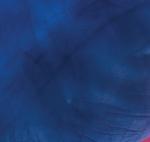

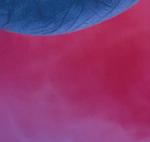
















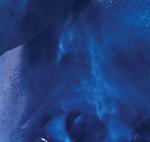














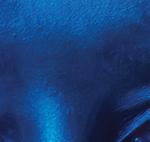



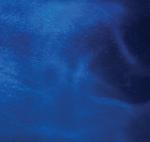



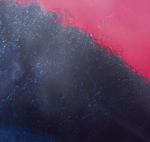

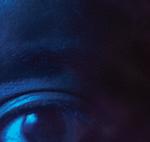



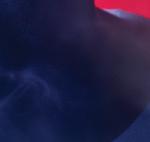































By KERRY REID
Editor’s Note: This essay originally ran February 25, 2025, as part of the Theatre Futures series published by American Theatre magazine and Theatre Communications Group (TCG). It is reprinted here with permission from TCG.
As I write this essay, the Chicago Reader, the venerable alt-weekly where I have been theater and dance editor for over five years (after freelancing for many more), is in a fight for its life. The reasons for our current predicament aren’t too di erent from the circumstances we’ve seen play out at so many nonprofit theaters in the post-COVID-lockdown era (the Reader became a nonprofit organization, the Reader Institute for Community Journalism, in 2022), including a shortfall in expected gifts from major donors and rising costs.
So forgive me if these notes on the impact of arts coverage seem raw and personal. They are straight from the center of a heart that’s breaking at the thought of losing the career I’ve loved at a paper that, ever since I began reading it regularly nearly 40 years ago, has defined for me what the role of a critic and arts journalist could be for the community, and that also introduced me to the most exciting theatrical experiences of my formative years and beyond. They are also from a brain that is exhausted from trying to figure out how to cover as much as possible as we (temporarily, I hope) cut down on the freelancers who have always been so vital to the breadth and depth and diversity of our work. Last year, the Reader published 311 theater reviews. None of that happens without the many freelancers who bring their special knowledge, passion, and grit to covering work from all over the Chicago area.
This workplace crisis is happening at the same time that independent media and grassroots artists (the ones we’ve covered at the Reader since its birth in 1971) are more needed than ever. I don’t know that art or scrappy independent journalism can actually save us from fascism, but I do know that we need both to tell the stories that will, at a minimum,
remind us that we’re not out of our minds to feel existential doom descending. (In terms of timing, Chicago’s Blank Theatre Company was right on the nose with their revival of Tony Kushner’s drama about the Weimar Republic, A Bright Room Called Day, in December.)
As Samuel Beckett once said, by way of explaining why there are so many great Irish poets, “When you are in the last ditch, there is nothing left but to sing.”
So here are some verses, if you will, to sing the song of the Reader and other alt-weeklies and the irreplaceable role they’ve played in fostering theater communities across the nation. I hope they won’t be a swan song.
As I wrote in an essay for our 50th anniversary, “If a show fell, er, opened in Chicago and a Reader critic didn’t cover it, did it actually happen?” Our archives are a repository that helps keep alive this most ephemeral of art forms. By covering as much as possible, without regard to whether or not a company was “the next big thing” (we’ve never been big on the star-maker/ star-breaker role of critics), we laid groundwork that, even if we don’t survive as a publication, should certainly serve as a blueprint for keeping the conversations among audiences, artists, and critics/journalists alive in whatever the times to come will look like.
The Reader freelancers are often practitioners as well as critics. The late Jack Helbig, who died suddenly in January (another reason for my raw heart, as I knew him for nearly 35 years), wrote librettos, including a collaboration with Urinetown composer Mark Hollmann. Many current Reader contributors, including Sheri Flanders and Wanjiku Kairu, perform sketch and improv around town. Our longtime, award-winning dance writer, Irene Hsiao, also creates dance. I think having that background gives their writing warmth and insight (not to mention an inside track on breaking stories).
Practitioners or not, the best Reader critics aren’t writing from the perspective of the “objective outsider” whose aim is to tell au-
diences what they should or should not see (boring!). They’re trying to help us all see how a piece comes together (or perhaps doesn’t) and where it fits in the cultural and civic landscape. Do that well, and audiences can make up their own damn minds about what’s worth their time and money.
The Reader has always covered the homegrown theatrical forms and events that helped define Chicago as a performance capital, whether by covering sketch and improv at iO, Second City, and Annoyance (Helbig was particularly good at it); “close-up” Chicago magic; the growth of the Chicago International Puppet Theater Festival; or the groundbreaking Destinos: Chicago International Latino Theater Festival. (We covered a dozen shows from the latter this past year—far more than any other outlet, per their publicist.)
I can only hope that we’ve helped audiences gain a deeper appreciation of the role the city has played in fostering work beyond the next Broadway-bound playwright or Oscar-nominated actor. Every city has something unique in its theatrical landscape that should be celebrated and contextualized for its own time and the times to come. We’re not all sitting around waiting for the touring Broadway hit (though there’s nothing wrong with that!). Local, local, local should be the mantra for any theater coverage that truly wants to reflect its community. And discovering that community means that neither audiences nor artists can rely solely on the four-star review from the daily paper to define the value of the work being created.
in the last 15 or so years, where, as Dr. Jen Benoit-Bryan wrote for the Theatre Futures series, they are recognizing a need to “meet audiences where they are.”
Something I’ve dipped my toe into is the idea that theater coverage doesn’t need to come from theater journalists. I recognize that so many shows reflect issues that can only benefit from reporters with subject-matter expertise writing about them. Dilpreet Raju, who specializes in writing on health, environment, and underserved communities, has written features for the Reader on theater by incarcerated and formerly incarcerated people, and also covered plays on climate change, medical racism, and harm reduction via Narcan. Just as theaters bring in community activists and specialists in various subjects for both rehearsals and postshow panels, so too should

arts coverage tap into the knowledge and insights of journalists who cover the issues that define our times.
As former Reader theater editor (and George Jean Nathan prizewinner) Albert Williams noted in a 2002 address to the American Theatre Critics Association, later reprinted in the Reader: “We don’t set up any artificial distinction between the ‘readers’ and the ‘artists,’ because we recognize that many of our readers are artists.” At the Reader, we trust our audiences, even if they hate what we write. (Believe me, I hear about it when they do.) I think that dovetails with what I’ve seen happening in theaters across the country
I don’t know what will happen with the Reader (or our country) in the days to come. I do know that we need storytellers who aren’t afraid to be messy, raw, urgent, and immediate. We don’t need gatekeepers right now. We need people who will join together to crash the gates that maintain false systems of hierarchy, whether in media or theater. I hope I’m around to share in that from my side of the aisle. Even if not, I hope that what the Reader has done over the past 50-plus years will still be a beacon for what comes next. v
m kreid@chicagoreader.com





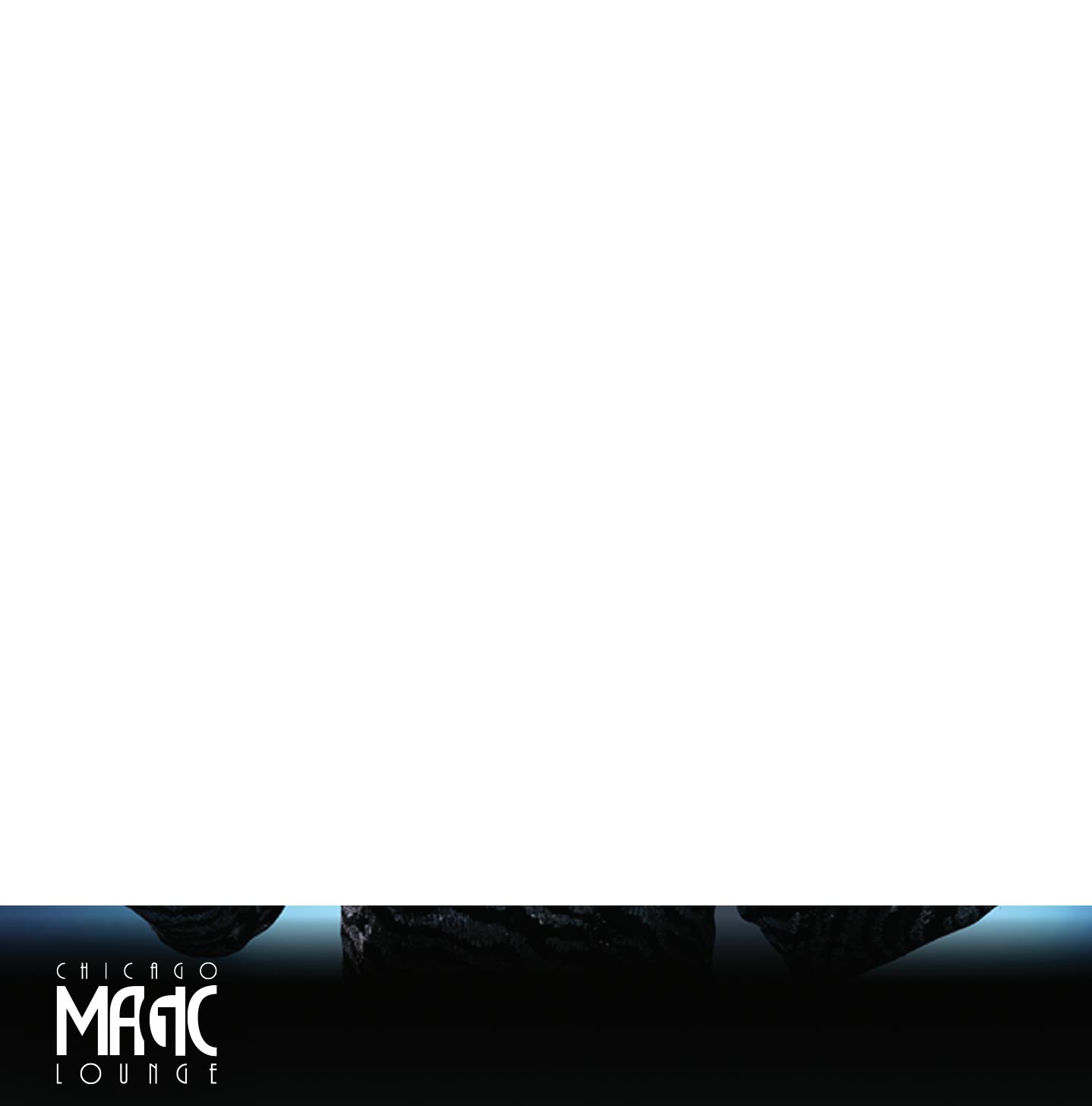

By KERRY REID
As we adjust to daylight saving time and deal with the fire hose of news and anxiety pointed at us every day, it can be hard to get the energy to get up and about sometimes. (Or maybe that’s just me.) But warmer weather also brings more reasons to break out of the gray Chicago doldrums. And if you have a hankering to enjoy live performances surrounded by community, the upcoming months are blooming with possibilities. Here are just a few of our suggestions for the best in theater, dance, comedy, and opera.
COMEDY AND VARIETY
Helluva Cabaret
If you think you’re living in hell, then maybe a visit to Helluva Cabaret will either fan the flames or soothe you. The brainchild of Reader social media maven Charli Renken (known as Vicious Mockery in their drag persona), this parodic drag and variety show draws on the animated musical universe created by Vivienne Medrano’s Helluva Boss and Hazbin Hotel , in which the underworld provides opportunities for both assassination and redemption. Fri 4/11, 9:30 PM, Newport Theater, 956 W. Newport, 773-2703440, newporttheater.com, $25-$35, 18+
W. Kamau Bell
The producer and host of CNN’s United Shades of America and creator of Showtime’s We Need to Talk About Cosby drops truth bombs regularly with his blog Who’s With Me?, which also provides the name for his current stand-up tour. As an activist, writer, podcaster, and performer, Bell, as he describes himself, “cares too much and sleeps too little,” but he’s bringing his message of meaningful resistance to the Den for two nights. Longtime Bell friend and collaborator

Dwayne Kennedy opens. 4/25-4/26, Fri–Sat 7:15 and 9:30 PM, Den Theatre, 1331 N. Milwaukee, 773-697-3830, thedentheatre.com, $28-$60
Material Conditions: Two works on autonomy & reproductive justice
Two artists collaborate on a split bill of movement and multimedia performances looking at liberation and reproductive health and justice. In Praise Music Sonogram, Houston-based visual and performing artist Julia Barbosa Landois uses spoken word, video, and experimental sound to “tell a story of motherhood, miscarriage, and abortion access across national and state borders,” contrasting European health care with the crisis in reproductive health unleashed in the U.S. with the overturning of Roe v. Wade. Chicago artist KIKI King’s ABORT is a choreographic work that addresses physical liberation as embodied in club culture, while also paying tribute to the many contributions of Black women to rock music. Thu 3/27–Sat 3/29 7 PM, Links Hall, 3111 N. Western, 773-2810824, linkshall.org, $16-$42 sliding scale
With the rising attacks on science and education, it seems timely for Evanston Dance Ensemble to celebrate the spirit of exploration
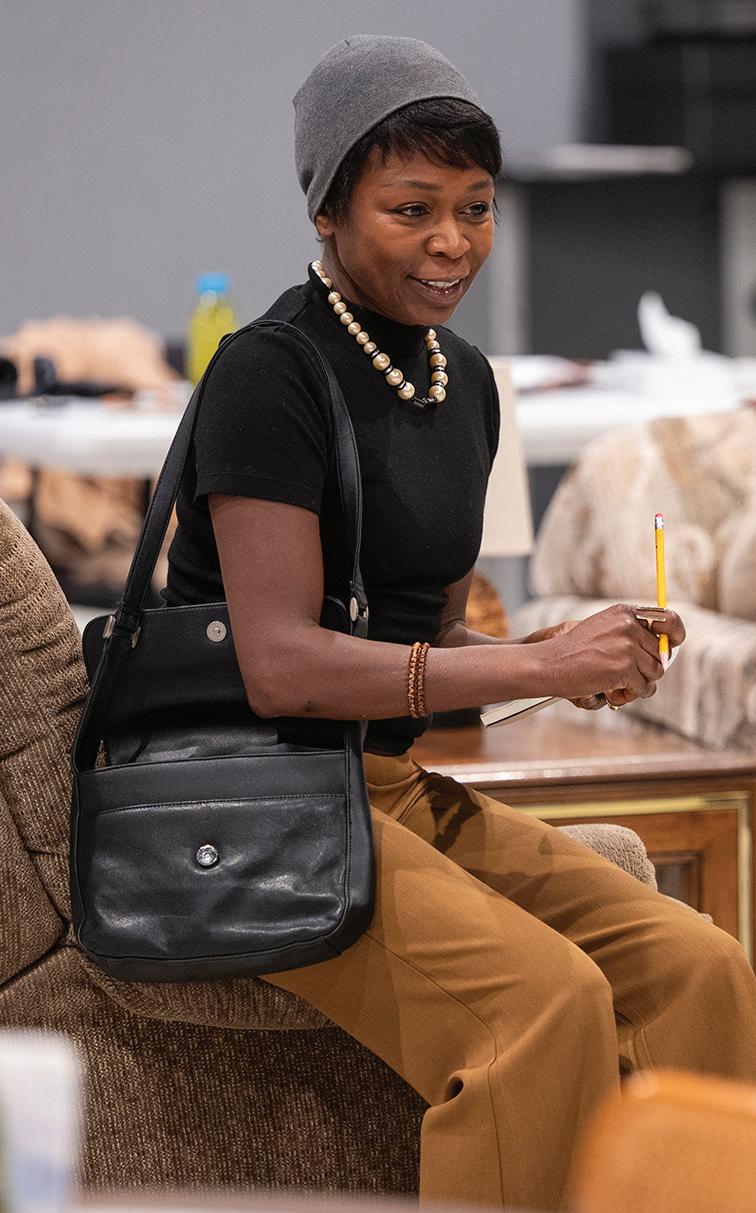
and discovery. In Breakthrough!, seven di erent choreographers created world premieres that all focus in some way on scientific themes, including the Fibonacci sequence and Leonardo da Vinci’s flying machine. Company artistic director Enid Smith created two new pieces—one set to Beethoven’s Moonlight Sonata and exploring eclipses, and another exploring extreme weather events and how communities rebuild in the aftermath of disasters. The finale, created by Ryan Galloway, is a musical theater dance number set to Oingo Boingo’s “Weird Science.” 4/3-4/6, Thu–Fri 7:30 PM, Sat 10 AM (relaxed performance “for all ages and abilities”), Sun 1 and 4 PM, Josephine Louis Theater, Northwestern University, 20 Arts Circle Dr., Evanston, 847-491-7282, evanstondanceensemble.org, $28 adults, $18 for children and seniors (4/5 show $12 per person or $30 for a family of three or more)
Soaring: Life, Light, and Legacy Giordano Dance Chicago celebrates 40 years of the leadership of Nan Giordano (daughter of the late founder Gus Giordano) and also pays tribute to her son, Keenan Giordano Casey, who died suddenly in October 2024 at age 29. Nan created Soaring about her son in collaboration with Cesar G. Salinas and the company dancers. The evening also includes the world premieres of Giordano and Sali-
nas’s 333 , a solo for company member Erina Ueda, and resident choreographer Al Blackstone’s Sana , alongside repertory favorites Taal (also by Nan Giordano), Red & Black (by Ray Leeper), and Pyrokinesis (by Christopher Huggins). 4/4-4/5, Fri 7:30 PM, Sat 6 PM, Harris Theater, 205 E. Randolph, 312-334-7777, harristheaterchicago.org, $36-$106
Haymarket Opera Company launches its 15th season with the Chicago premiere of Alessandro Stradella’s 1673 oratorio (libretto by Lelio Orsini), based on the biblical story of Queen Esther and her foiling of her husband’s plans to kill the Jews in Persia. Soprano Kimberly McCord sings the title role and bass-baritone Christian Pursell is Haman (the villain whose name inspires noisemakers during Purim services, though Haymarket will probably use their usual array of period instrumentation here). Fri 3/28, 7:30 PM (preconcert lecture 6:45 PM), Gannon Concert Hall, Holtschneider Performance Center at DePaul University, 2330 N. Halsted, 773-325-5200, haymarketopera.org, $55-$95 ($7 students)
Splash Hatch on the E Going Down In Kia Corthron’s drama, a 15-year-old pregnant



MAR 23
girl in Harlem balances impending motherhood with research into environmental injustice in her community. When a tragedy happens, she confronts her fears and plans for the future. Definition Theatre presents the Chicago premiere, directed by local legend Cheryl Lynn Bruce. The south-side company also recently announced they’ve received a $500,000 grant from the Paul M. Angell Family Foundation in support of their planned new home in Woodlawn. Through 4/13, Definition Theatre, 1160 E. 55th St., definitiontheatre.org, $25-$35
Titanique
Broadway in Chicago and Porchlight Music Theatre team up for the Chicago premiere of the o -Broadway hit jukebox musical parody of James Cameron’s 1997 romantic shipwreck epic, featuring the songs of Céline Dion and book by Tye Blue, Marla Mindelle, and Constantine Rousouli. Dion hijacks a museum tour about the Titanic , claiming to have actually survived the 1912 disaster, and then launches into her own loopy version of the events around Jack, Rose, and the other fictional and
real characters from the film. The partially improvised show (directed by Blue) draws upon other pop cultural references—we’ll have to see how the material changes for a Chicago audience. (I’d personally love to see someone from the 1915 SS Eastland disaster show up to remind everyone that the Titanic doesn’t have a monopoly on maritime tragedies.) 3/25-5/18, Broadway Playhouse, 175 E. Chestnut, broadwayinchicago.com, $45-$100
Tense family reunions have provided the backdrop for many great shows at Steppenwolf over the years, including Tracy Letts’s 2007 August: Osage County and Branden Jacobs-Jenkins’s 2024 Purpose (now running on Broadway). Now they’re presenting the Chicago premiere of Suzan-Lori Parks’s 2010 play, directed by Steve H. Broadnax III, in which Grace, who tries to see the good in everyone, is caught between her husband, Vet (a domineering border patrol agent), and her stepson, Buddy, who carries a grenade and a chip on his shoulder about his father. Zainab Jah, Jerome Preston Bates, and

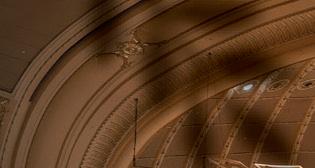

Namir Smallwood star. 3/27-5/18, Steppenwolf Theatre, 1650 N. Halsted, 312-335-1650, steppenwolf.org, $20-$102
Prayer for the French Republic
Northlight Theatre and Theater Wit coproduce the local premiere of Joshua Harmon’s 2022 drama about a Jewish American student in 2016 who tries to reconnect with her family’s French roots by visiting a distant cousin. In the first act, the rise of radical right-winger Marine Le Pen and an anti-Semitic attack lead the French family to consider a move to Israel. This mirrors the story of the cousins’ great-grandparents in 1944 Paris, awaiting news of what happened to their missing family. Theater Wit artistic director Jeremy Wechsler directs a cast that includes longtime Chicago favorites Janet Ulrich Brooks, Rae Gray, Lawrence Grimm, Kathy Scambiatterra, and others. 4/10-5/11, North Shore Center for the Performing Arts, 9501 Skokie Blvd., Skokie, 847-673-6300, northlight.org, $35-$91 v
m kreid@chicagoreader.com


Jimmy López: Inner Dialogues
MAR 27-29
Bruch & Schumann Rhenish
MAR 30
Julia Fischer & Jan Lisiecki
APR 3-5
Canellakis Conducts Rachmaninov
APR 4
Hiromi’s Sonicwonder
Brandee Younger Trio




APR 10-13
CSO x The Joffrey Ballet
APR 12
Boleros de Noche featuring Tres Souls & Trío Remembranza
APR 15
Ukulele Orchestra of Great Britain: 40th Anniversary Tour






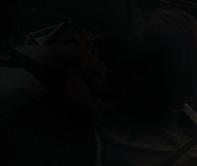
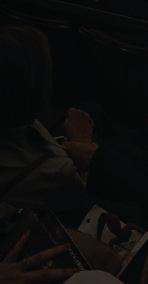
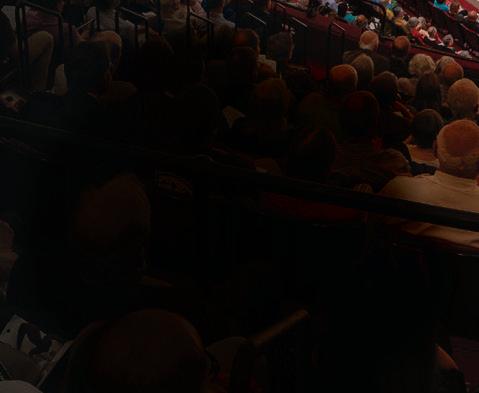















































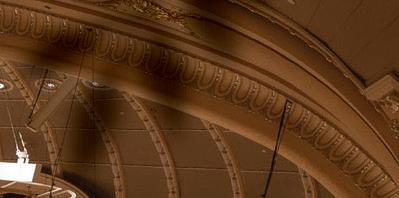








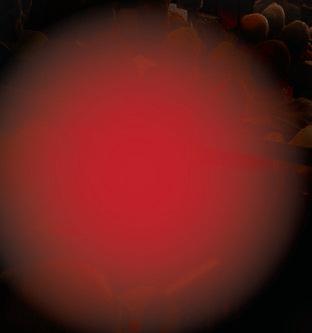



















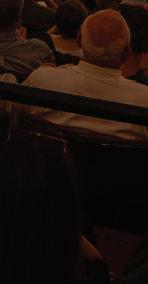
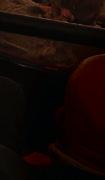

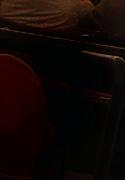
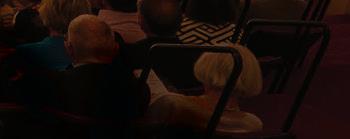
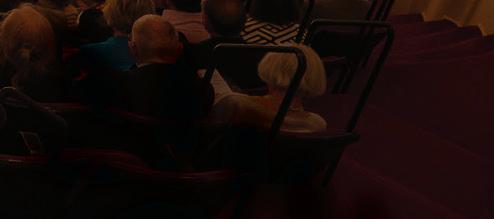


Dystopia with cupcakes
Funny, Like an Abortion struggles to find the right tone.
There is something inherently freeing about performing a dark comedy play about abortion in a church hall in the middle of a hostile government takeover. Lingering in our minds is the omnipresent realization that we are entering the dystopian reality in which the play takes place—but at least the characters have cupcakes! They may not be able to say the word “abortion” or legally access birth control, but they have cupcakes (and each other).
These cupcakes (particularly the frosting in several scenes) are a source of comfort for Monroe (Bianca Thompson) and Jade (Saniafaith) throughout the show, especially a er Monroe surprises Jade by throwing an abortion party. The trouble is, in Rachel Bublitz’s Funny, Like an Abortion, everything is frosting. We’re missing the actual cupcake.
Bublitz’s play, directed by Eileen Tull for Chicago Danztheatre Ensemble and Fat Theater Project, oscillates wildly between dead serious reproductive rights conversations to off-the-wall banter between these two friends. Tonally, this play struggles to find a place to land, which becomes a problem when it doesn’t find a satisfactory way to bring the story to a close. A series of fourth-wall breaks turns the show into the trope of an a er-school special. I was entirely unsurprised when one of those wall breaks turned into the actors reading note cards of reproductive rights factoids to the audience. As important as these conversations are, a compelling script is even more so to get the point across. —AMANDA FINN FUNNY, LIKE AN ABORTION Through 3/30: Fri–Sun 7:30 PM; Chicago Danztheatre Ensemble, 1650 W. Foster, danztheatre.org, pay what you can ($30 suggested donation)
RPerro party
A bilingual musical Go Dog Go! delights at Chicago Children’s Theatre.
What beats a Spanish-English children’s matinee about a bunch of dogs? One with clowning, bubbles, and accordion music, for starters. In the world premiere of Go Dog Go! Ve Perro ¡Ve!, six dogs of varying size, skill, and temperament deliver a universe that enchants children, leaving them slack-jawed and in stitches. Kids point, clap, and exclaim, but mostly sit in rapt attention as the dogs strut across the stage, creating an hour of pure bilingual fun.
The play was originally adapted by Steven Dietz and Allison Gregory in 2003 from the beloved 1961 children’s book by P.D. Eastman. Chicago Children’s Theatre reached out to Dietz and Gregory to rework it as a bilingual musical, directed by Dietz, with Spanish translations by Ana Maria Campoy.
Dietz’s production is cleverly staged with vibrant costumes, playful props, and compelling music composed by Michael Koerner—especially the interactive accordion playing of music director Rob Witmer, who also appears as a dog. The action features familiar cutout characters from the book and a cast full of dogs with silly antics. (Many adults will probably recall the colorful book’s lessons on color, position, size, and polite interactions, like the recurring question, “Do you like my hat?”) Chicago clown Jean Carlos Claudio as MC Dog
balances the energy with his parental guidance and playful spirit, while Shawn Pfautsch (Yellow Dog), Maria Clara Ospina (Blue Dog), Jalbelly Guzmán (Green Dog), and Tony Carter (Red Dog) bring the chaos. Melanie Brezill (Hattie) dazzles with increasingly wild hats and catchy jazz riffs.
Watching clown dogs navigate streets in dog cars or sort out sandwiches is a revelation and a precious moment away from stress. It’s a chance to sit with your child, laugh together, and revel in simple joys and manageable conflicts. Dogs roller-skating? Trees turning blue? Hasta la fiesta de la perrera! —KIMZYN CAMPBELL GO DOG GO! VE PERRO ¡VE! Through 5/18: Sat–Sun 9:30 and 11:30 AM; Sat 4/19 11:30 AM and 2 PM; no shows 9:30 AM Sun 4/20 and 5/4; sensory-friendly performances Sat 4/12 and 5/3 9:30 AM, audio description and touch tour Sat 4/19 2 PM (tickets must be purchased two weeks earlier), ASL and open captions Sat 5/10 11:30 AM; Chicago Children’s Theatre, 100 S. Racine, 312-374-8835, chicagochildrenstheatre.org, $42.25, recommended for all ages
Teatro La Plaza’s Hamlet goes beyond disability narratives with its cast of actors with Down syndrome.
This year’s unofficial mini-festival of nontraditional takes on Hamlet continues at Chicago Shakespeare, which brought us Eddie Izzard’s one-woman version a year ago. (We’ve also seen Robert Lepage and Guillaume Côté’s dance version, Teatro Tariakuri’s El Piélago de las Calamidades, and Goodman’s Fat Ham.)
The short run of Teatro La Plaza’s Hamlet through Sunday at Chicago Shakes’s upstairs studio marks the U.S. premiere for this Peruvian company. (The show is copresented by the Chicago Latino Theater Alliance.) And it should not be missed if you can snag a ticket.
The cast features adults with Down syndrome who draw on their own anecdotes and experiences to reimagine Shakespeare’s story of vengeance, grief, and doubt. The result is a compelling and fresh 95-minute collage of scenes reflecting on the isolation and misunderstanding they face in their lives.
Writer-director Chela De Ferrari’s eight-member ensemble refracts the existential profundity of the brooding Dane’s “to be or not to be” in personal terms. In particular, the love of Ophelia and Hamlet feels quite poignant as it reflects the barriers to romantic relationships people with Down syndrome face from parents and other forces in society who tell them, “We only want what is best for you” (and also not so secretly want to make sure no more people like them exist).
Olivier’s masterful film performance also shows up. But this cast isn’t leaning on anyone else to make the story their own, and the exhilarating dance party that ends the show reveals the power of choosing to be yourself in the face of limitations and prejudices. —KERRY REID
HAMLET Through 3/23: Wed 1 and 7:30 PM, Thu–Fri 7:30 PM, Sat 2:30 and 7:30 PM, Sun 2:30 PM; Chicago Shakespeare Theater, 800 E. Grand, 312595-5600, chicagoshakes.com, $35-$40, in Spanish with English titles
RLife lessons from animals
Lifeline’s Leaf instructs without preachiness.
Crow is growing up, which means she has to start attending Wildwood Community Council meetings. Though she’s clever and empathetic, it’s hard to speak up sometimes when you doubt yourself. But when a strange creature appears in the woods, gathering leaves and taking over an abandoned cave, the other animals, including Fox, Squirrel, and Hare, wonder if they should take aggressive action against it. A er all, they don’t know anything about it, and it’s acting in a suspicious way. Also, their own resources are growing scarce as floods encroach upon the woods.
Sandra Dieckmann’s 2017 children’s book, Leaf, adapted for Lifeline by Amanda Link (Nathaniel Niemi directs) works at multiple levels without ever becoming preachy. It’s about overcoming fear to speak up for what’s right. It’s about becoming aware of how climate change endangers others. And it’s about seeing strang-
moment of anxiety as she struggles to find her voice, which makes her growth into an advocate even more compelling. Jake Busse’s Squirrel and Ariya Hawkins’s Fox provide cunning and witty support, and Alan Donahue’s set and Diane Fairchild’s lighting design capture the look of Dieckmann’s book with colorful and imaginative flourishes. “A story can change everything,” Crow tells us early on, and at least in the case of this delightful and timely family show, that’s absolutely true. —KERRY REID LEAF Through 4/20: Fri 7 PM, Sat–Sun 11 AM and 1 PM; touch tour and audio description Sat 3/22 1 PM (touch tour at noon), open captions Sun 3/23 1 PM, sensory-friendly performance Sat 3/29 1 PM; Lifeline Theatre, 6912 N. Glenwood, 773-761-4477, lifelinetheatre.com, $20, recommended for ages 4-11
RThe Pillowman gets a local
Concrete Content fuses Martin McDonagh’s authoritarian tale with Chicago’s history of police violence.
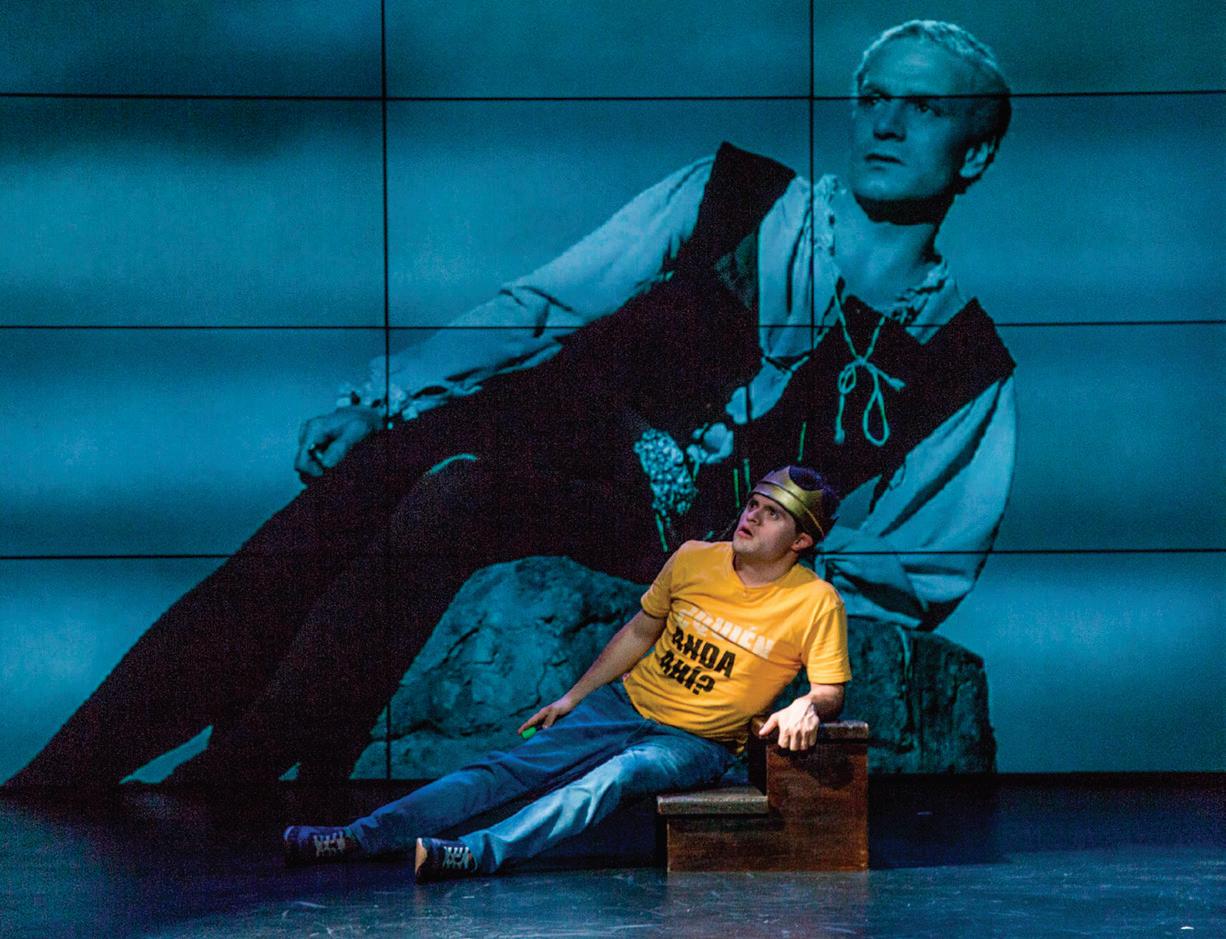
ers as fellow living beings first, instead of threats to your own way of life.
The actors, all of whom have impressive credits both on- and offstage in areas including sports, dance, and activism, take turns playing the multiple roles in Shakespeare’s original. At one point, Ian McKellen appears via video to answer seven questions from Jaime Cruz about how to play Hamlet, and a snippet of Laurence
Leaf, you see, is a young polar bear who floated down to the north woods when the ice floe he was on broke away from his family. He’s gathering the leaves because he hopes to make wings to fly home. As embodied in Caitlin McLeod’s breathtaking puppet (voiced and handled by Bradley Halverson), he wins our hearts. But so does every other character in this sure-handed and sweet tale. Shea Lee’s Crow makes us feel every little
Watch out, Chicago, there’s a giant pillowman out there somewhere! Let’s just say director Ricardo Gamboa, a longtime activist and artist, has brought him to life in Chicago with Concrete Content’s rendition of Martin McDonagh’s The Pillowman. The show draws strong parallels between the play’s themes and the city’s history of police violence. Gamboa went deep with their research, interviewing two local brothers tortured into false confessions by Chicago police (and wrongly imprisoned for decades), and embedding McDonagh’s original story (first produced in 2003) about child murder in a totalitarian state in the local context of the deeply entrenched institutionalized racism many in the U.S. experience today. The cast features Omari Ferrell as Katurian, delivering a truly visceral performance, and Tyran Freeman as his brother, Michal, whose devotion reveals a tragic, disturbing backstory. With gritty, brilliant acting by Sean James William Parris as Tupolski (who thinks he’s the good cop) and Roy Gonzalez as Ariel, the interrogating officers add hair-raising realism to the narrative. EG Canzano’s set and Amina Gilbert’s lighting design reflect Chicago’s no-nonsense and graffitied aesthetic (graffiti art by Chris Silva, Roman Caballero, and Evan Phillips), while surprising interludes with animation and puppets by Agnotti Cowie, Jordan Paine, and Rocio “Chio” Cabrera enhance the storytelling. Set against Chicago’s backdrop of systemic oppression, The Pillowman becomes a powerful critique of current societal woes, all while exploring the story’s nuances of fear, flaws, and (mercifully) humor. The show program, a zine-like resource, includes interviews and a director’s note, offering context and a call to action. This production is a must-see for its emotional depth and social relevance—a moving gut punch of a show. —KIMZYN CAMPBELL THE PILLOWMAN Through 4/12: Fri–Sat 7 PM; AfriCaribe Cultural Center, 2547 W. Division, tickettailor.com/events/thepillowman/1549791, sliding scale donation $10-$60
The School for Scandal remains fresh and funny in Idle Muse’s production.
Richard Brinsley Sheridan’s 18th-century comedies of manners, with their stiletto-sharp portraits of backbiting socialites and moneygrubbing scoundrels, still resonate today. Idle Muse Theatre Company’s revival of 1777’s The School for Scandal, adapted and directed by Evan Jackson, adds some contemporary flair with reworked versions of hits by David Bowie and Queen, but while they make for fun interludes to listen to during scene changes, you don’t really need to do much to update this material, which feels like a Real Housewives spin-off for the Georgian era.
As someone who hadn’t read the play in a while, it did take me a few minutes to sort out the various intrigues and backstories as delivered in the first scene by Elise Soeder’s catty and aptly named Lady Sneerwell. It’s folly to try to synopsize the dizzying story, but it basically boils down to which of the two brothers will win the hand of the virtuous Maria (Cat Evans)—posturing hypocrite Joseph Surface (Eric Duhon), or Charles (Brian Healy), who’s an unapologetic party animal. Along the way, we meet Lady Teazle (a delicious Caty Gordon), the newly arrived much younger wife to Maria’s guardian, Sir Peter (Erik Schnitger), who aspires to join Lady Sneerwell’s band of Mean Girls and Boys. The unexpected arrival of Joseph and Charles’s wealthy uncle Sir Oliver (Ross Compton), who has been pursuing his fortunes in the North American colonies, unspools an increasingly complicated series of assignations.
The cast commits to the caricatures without becoming too big for the small space. There’s a particularly delightful interlude where they assume the postures of Sir Oliver’s ancestors, posing behind empty picture frames to embody all the musty forebears one sees hanging in manor houses in every film about British aristocracy. Some moments perhaps milk the comedy a beat or two longer than necessary, but even then, the eye-candy costumes and wigs by Victoria Jablonski give you plenty to look at. —KERRY REID THE SCHOOL FOR SCANDAL Through 4/12: Thu–Sat 8 PM, Sun 3 PM; also Wed 4/9 8 PM; the Edge Off Broadway, 1133 W. Catalpa, 773-340-9438, idlemuse.org, $30 ($20 students/seniors)
Tell Me on a Sunday is a showcase for Dani Pike.
If you find Andrew Lloyd Webber’s musicals overstuffed and bombastic, you might be surprised by Tell Me on a Sunday. This one-woman piece, first produced in 1979, lasts only 75 minutes and has minimum staging requirements, which stands in contrast to the crashing-chandelier aesthetic and nearly three-hour runtime of The Phantom of the Opera It’s a terrific choice for an intimate venue like Theo’s Howard Street Theatre. Particularly if you have Dani Pike on hand to play Emma, the bruised romantic whose ups and downs in love form the basis for the story.
Perhaps ironically, the story was originally conceived by Webber’s onetime collaborator Tim Rice, but allegedly Webber, disapproving of Rice’s extramarital affair with musical theater star Elaine Paige, turned to lyricist Don Black (who wrote some of the songs for the James Bond franchise). Emma’s affair with a married man is one of four anatomized in the 75-minute piece. So sure, it’s a
fair cop to point out that her story seems to be all about her affairs (which also include an older movie producer who whisks her off on a fool’s errand to Hollywood and a younger man she meets back in New York). On the other hand, given that she’s struggling to land a green card, it’s not as if a glittering career in the States is central to her life. And for lots of twentysomething people, not just young women, romance is still a major factor in life decisions, for good or ill.
Directed with a sure and sensitive hand by Keely Vasquez, this piece feels very much like an artifact of the 1980s, expressed in Pike’s denim skirt and off-theshoulder Flashdance tops. (The note-perfect period costumes are by Marquecia Jordan.) Eleanor Kahn’s set, with its pink tones and stacked platforms like the tier of a cake, also has a clever but functional MTV-meetsBarbie appeal.
But the show’s weight is on Pike’s shoulders, and boy howdy, does she ever deliver. There aren’t a lot of insta-classics in the score (though the title number feels like something that the late Kirsty MacColl could have come up with, and that’s no small compliment, and “Come Back With the Same Look in Your Eyes” feels like something Burt Bacharach might have written, which is a great instance of “steal from the best”). Music director Evelyn Ryan and her four musicians modulate the volume well for the small space, and Pike knows how to make nearly every moment count in this charming and touching, if slight, story of one woman’s struggles to find herself—in and out of love. —KERRY REID TELL ME ON A SUNDAY Through 4/20: Thu–Sat 7:30 PM, Sun 6 PM; Howard Street Theatre, 721 Howard, 773-939-4101, theo-u.com, $45-$60
Invictus’s take on one of Shakespeare’s odder works runs out of steam.
Among Shakespeare’s fans, “Exit, pursued by a bear,” is one of those lines that delights. Yet, unlike “to be, or not to be,” it isn’t spoken—it’s a stage direction. It’s likely one of the only things most people know of The Winter’s Tale. A bear shows up and chases someone off the stage, which is honestly my favorite Shakespearean death. One of the Bard’s final works, it’s also one that, like Pericles and Cymbeline, isn’t done very o en. With two diametrically opposed acts, it is also definitely one of his more experimental plays.
The Winter’s Tale is a tragicomedy of King Leontes (Michael Stejskal), who suddenly believes his pregnant wife Hermione (Andrea Uppling) had an affair with his friend King Polixenes (Raúl Alonso). From there, the story devolves into tragic chaos throughout act one, only to be met with a jarring 16-year time skip and genre hop to comedy in act two. Invictus Theatre’s ensemble, directed by Charles Askenaizer, does their utmost to make sense of this content whiplash, and melodramatics made too melodramatic at times, but those nearly three hours feel mighty long by the end.
The respite for weary winter travelers comes in this show’s charming use of music throughout (original score by Petter Wahlbäck), which is performed by several of the multifaceted actors, as well as in its trio of rustic bringers of joy—Chuck Munro, Kyle Quinlivan, and Sam Nachison. The standout is definitely Nachison as Autolycus, the con man who could give Harold Hill a run for his money. —AMANDA FINN THE WINTER’S TALE Through 4/20: Mon and Fri 7 PM, Sat 1 and 7 PM, Sun 1 PM; Windy City Playhouse, 3014 W. Irving Park, invictustheatreco.com, $25-$38 v
“DENNIS WATKINS IS Chicago’s premiere resident magician”
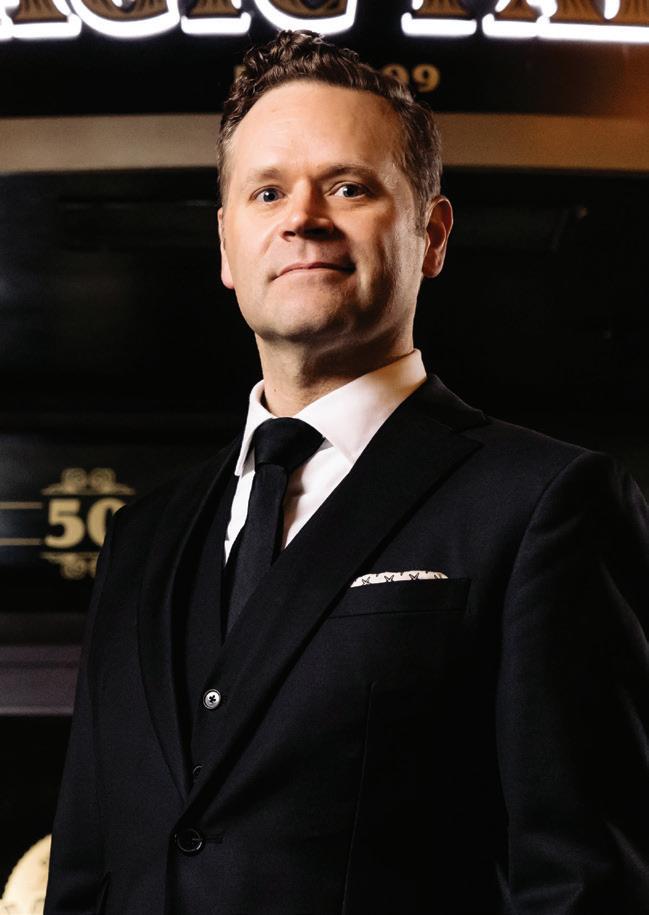
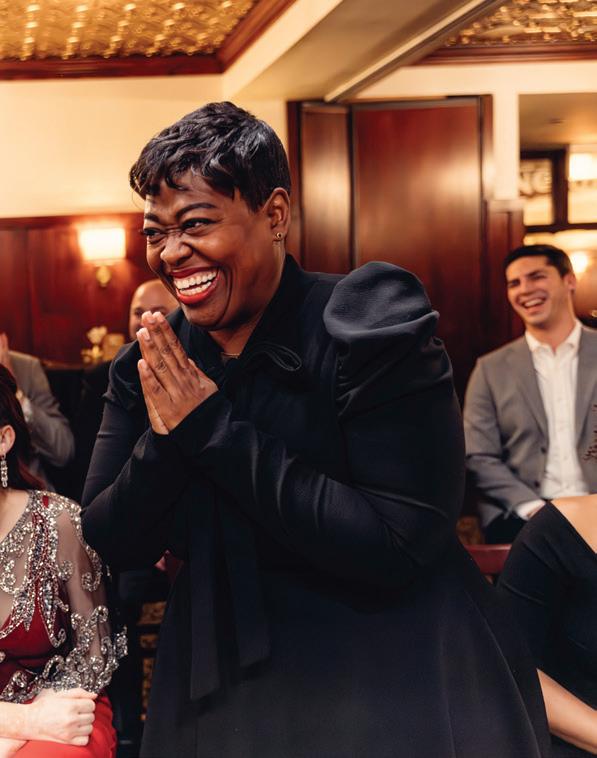
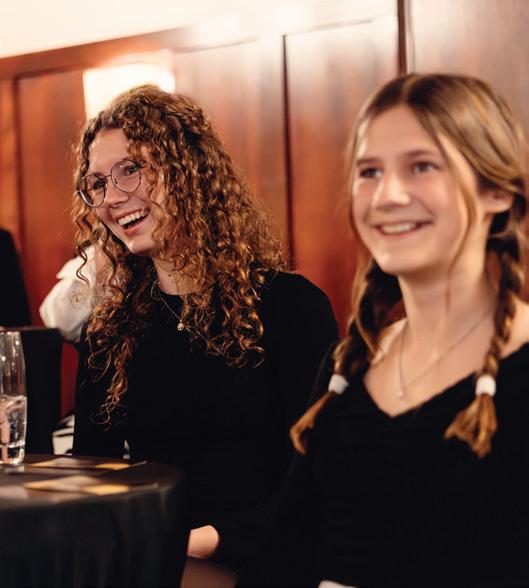

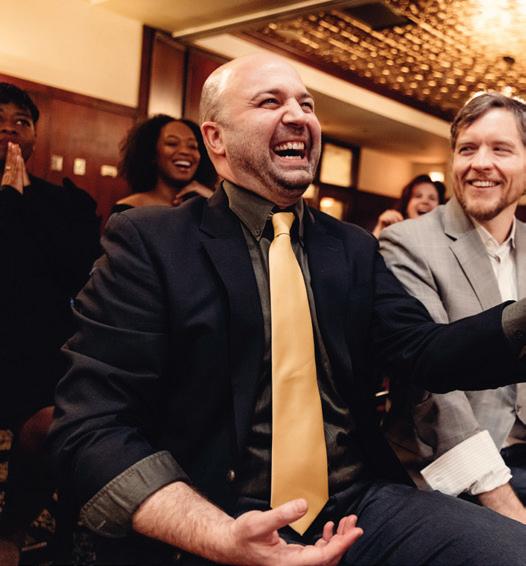
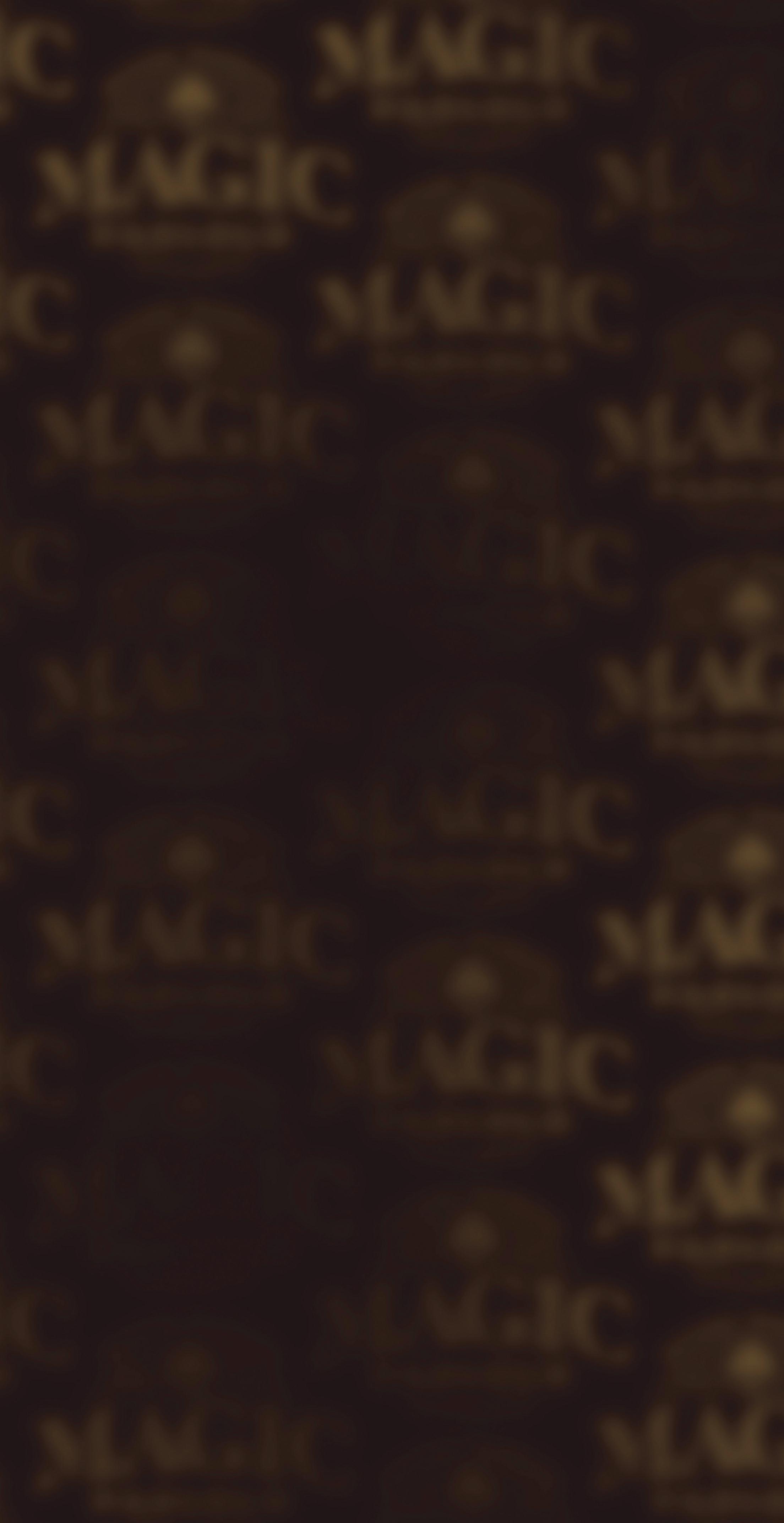

RCHICAGO PALESTINE FILM FESTIVAL
Sat 4/ 12–Sat 4/26, Gene Siskel Film Center, 164 N. State, $13 general admission, $ 8 students and youth, $ 6 Film Center members, $ 5 SAIC students and faculty, and staff of the Art Institute, palestinefilmfest.com

Amid Israel’s continued genocide of Palestinian people and the arrest of Palestinian student activist Mahmoud Khalil by ICE, find knowledge and hope through film.
By KAT SACHS
On March 8, Mahmoud Khalil, a Columbia University graduate student of Palestinian descent, was arrested by Immigration and Customs Enforcement agents and taken, as we now know, to a detention center in Louisiana. A lawful permanent resident, Khalil nevertheless faces deportation for what the Department of Homeland Security posted on X (formerly Twitter) were “activities aligned to Hamas, a designated terrorist organization.”
It’d be impossible to write about the Chicago Palestine Film Festival, now in its 24th year, and not reckon with the current moment. (As of publication, Israel has again launched aerial attacks across the Gaza strip, killing more than 400 Palestinians.) Taking place between April 12–26 at the Gene Siskel Film Center, the
festival’s lineup spans the past and the present in such a way that they seem sadly indistinguishable, though awareness and education around both is crucial to what hopefully could be a peaceful future.
Especially prescient in the festival’s slate considering Khalil’s arrest is Jan Haaken and Jennifer Ruth’s documentary The Palestine Exception (2024), screening Saturday, April 19, at 1 PM, preceded like all the feature screenings by a few short films and followed by a Q&A. It’s a film about the ways in which criticism of Israel is still verboten on many college campuses, spaces where free speech and political activism are often promulgated as ideological tenets. At just over an hour, it’s an impressively concise overview of what began after October 7, 2023, when a new
McCarthyism emerged in response to robust protests on college campuses across the United States.
“Even though we can bash [the] countries of China and Russia, Saudi Arabia, not being accused of being anti-Buddhist or antiOrthodox, anti-Muslim,” says Theodore Khoury, a professor of management and strategy at Portland State University (one among 60 academic institutions recently warned by the U.S. Department of Education that they could face repercussions for “failing to protect Jewish students on campus”), “you have this exception of anything you say in favor of Palestine is construed as being anti-Semitic,” getting at the reason for the title of Haaken and Ruth’s film.
One definition of exception has it as being “a
person or thing that is excluded from a general statement or does not follow a rule.” There’s the Palestine exception as mentioned previously, and also the use of it in Spaces of Exception (2023), the end result of a yearslong multimedia project by filmmakers Matt Peterson and Malek Rasamny. Their documentary examines two such spaces, Native reservations and Palestinian refugee camps, several of which they visit in the film. It’s a natural comparison, the struggle of these two Indigenous groups (as an activist talking point, it’s raised also in The Palestine Exception ). “An important link in the project is how territory frames the ideas of sovereignty in both struggles,” the filmmakers said in an interview on the blog for PM Press (with whom they published the book The Mohawk Warrior Society: A Handbook on Sovereignty and Survival). “For most of the indigenous nations located territorially inside the borders of the United States, a land base is an essential component of their articulation of sovereignty—being politically, socially, economically, and spiritually outside the American system of governance—and the reservation is often the official articulation or potential starting point of such a landbase. . . . The Palestinian camps, on the other hand, are the spatial embodiment of a form of sovereignty rooted in refugeehood. It is refugeehood itself that is the threat, because it upends the sanctity of the State of Israel by

Thursday, April 10 / 7:30 PM
Friday, April 11 / 7:30 PM —
Saturday, April 12 / 2:00 PM





by


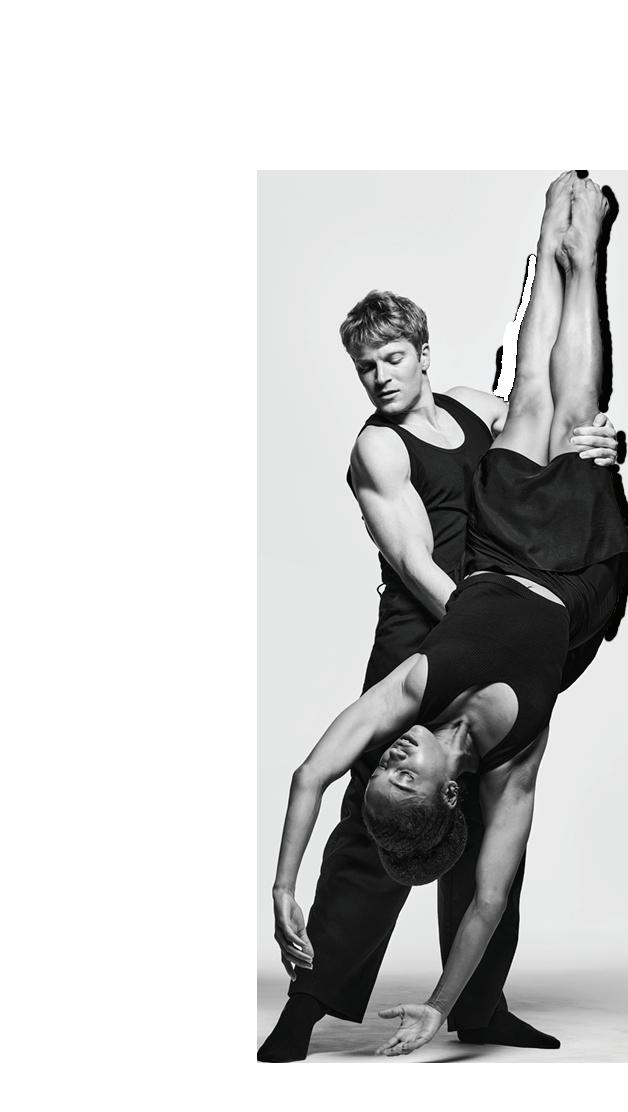
continued from p. 22
calling attention to the ethnic cleansing that made that state possible in the first place.”
Many of the documentaries I watched that are playing in the festival, including The Palestine Exception, provide accessible overviews of the ongoing conflict; my favorite is Revolution Until Victory AKA We are the Palestinian People (1972), screening Thursday, April 17, at 6:15 PM, made by Pacific Newsreel, described as a breakaway faction of the Newsreel, a radical New York City filmmaking collective. A mix of archival footage and on-the-ground reportage, the film covers the founding of Zionism, the impact of British imperialism, the proclamation of the Jewish state, the Nakba in 1948, and the establishment of the Palestinian liberation movement, among other key points in this ongoing contention. It resounds now as it must have then as being an especially radical document of a neglected history; it’s also symbolic as a consequential token of resistance from a bygone era, spurring hope that such momentum can be maintained.
The opening-night film screening on Saturday, April 12, Carol Mansour and Muna Khalidi’s A State of Passion (2024), is sold out. I hope it might find its way back to the big screen here in Chicago, as it’s an achingly beautiful portrait of British Palestinian surgeon Dr. Ghassan Abu-Sittah, who’s been providing medical aid during conflicts in Palestine since the First Intifada in 1987 and has emerged during the recent war as a face of both resilience and revolution. At the start of the most recent war, he worked tirelessly for 43 days, not just tending to victims but also making the world aware of the atrocities being committed against the Palestinian people. (He later went on to provide evidence to the international criminal court in the Hague.) Some images and footage within the film are the definition of “hard to watch,” but perhaps necessary to understanding the direness for those being attacked. Conflicts abroad can sometimes feel abstract—shocking as the numbers may be, they are just that, symbols rather than flesh (absolutely a privilege for those of us not experiencing the terror)—and this helps to realize the recondite. Also interesting are the insights into Abu-Sittah’s homelife as a plastic surgeon with his wife and three kids back in London.
Where the above-mentioned documentaries provide clarity in their straightforwardness, Kamal Aljafari’s A Fidai Film (2024) is more experimental, giving new meaning and gravitas to the concept of found footage. With
footage culled from a Palestine Liberation Organization archive that was stolen by the Israel Defense Forces during the First Lebanon War in 1982 and inspired by the writings of Palestinian writer and politician Ghassan Kanafani, Aljafari makes slight “interventions,” as he calls them, in the way of additive swaths of color and motifs, such as flames being appended to certain sequences. In an interview with Filmmaker magazine, Aljafari noted that “[t]he dangerous thing about using already-existing material is that it has its own narrative, its own gaze and power. What I do is basically turn the image against itself. And so, the interventions were a necessary thing to do,” explaining his own appropriation of already appropriated material, a new intimacy born of creative distancing.
Other documentaries playing include Leonardo Antonio Avezzano’s The Promise (2022), about a man, who, after his Palestinian father dies, fulfills his promise to him to scale Mount Everest, and Areeb Zuaiter’s documentary Yalla Parkour (2024), in which the filmmaker returns to Gaza to seek out a group of men she saw practicing parkour in a video on the Internet, the sport becoming an expression of freedom. They screen on Sunday, April 13, at 4 PM and Saturday, April 19, at 6 PM, respectively. There are also two programs of short films, Solidarity & Promise on Sunday, April 13, at 1 PM and Chicago to Palestine on Wednesday, April 16, at 6 PM.
There’s one narrative film, Danish Palestinian filmmaker Mahdi Fleifel’s To a Land Unknown (2024), described as a loose adaptation of Ghassan Kanafani’s 1962 novella Men in the Sun —the same writer who inspired A Fidai Film—and an extension of Fleifel’s 2012 documentary A World Not Ours , which ends with its subjects in Greece, where To a Land Unknown picks up. The protagonists, refugee cousins who went to Athens from a Palestinian refugee camp in Lebanon, carry out petty crimes in order to save for fake passports so that they can get to Germany; one of the cousins blows their money on his drug addiction, resulting in them undertaking a risky heist in which they must pose as smugglers. It was the only Palestinian film to be screened across all sections of last year’s Cannes Film Festival.
The closing night film on Saturday, April 26 at 7 PM, Mohammad Bakri’s Janin, Jenin (2024), spans the past and the present more literally, as it’s the Palestinian actor and filmmaker’s follow-up to his 2002 documentary Jenin, Jenin , about the Battle of Jenin that took place during the Second Intifada.


The film was initially banned in Israel, and though that was eventually overturned by the Supreme Court of Israel, it was later banned again after an Israeli soldier featured therein sued for defamation. Janin, Jenin covers this controversy and then revisits, in light of the latest war, the subjects 20-plus years later, older but no less resolved in their unwavering
desire for liberation. This film reminds us that it’s not necessarily about past or present, but the continuum of catastrophe (the meaning of the word nakba) that befalls the Palestinian people and the resilience they exude in spite of it. v
m letters@chicagoreader.com
SHED THE SALT SHED THE SALT SHED THE SALT SHED THE SALT SHED THE SALT SHED SALT SHED THE SALT SHED THE SALT SHED THE SALT SHED THE SALT SHED THE SALT
THE SALT SHED THE SALT SHED THE SALT SHED THE SALT SHED THE SALT SHED
SHED THE SALT SHED THE SALT SHED THE SALT SHED THE SALT SHED THE SALT SHED
SALT SHED THE SALT SHED THE SALT SHED THE SALT SHED THE SALT SHED THE SALT THE SALT SHED THE SALT SHED THE SALT SHED THE SALT SHED THE SALT SHED SHED THE SALT SHED THE SALT SHED THE SALT SHED THE SALT SHED THE SALT SHED
SALT SHED THE SALT SHED THE SALT SHED THE SALT SHED THE SALT SHED THE SALT
THE SALT SHED THE SALT SHED THE SALT SHED THE SALT SHED THE SALT SHED
SHED THE SALT SHED THE SALT SHED THE SALT SHED THE SALT SHED THE SALT SHED
SALT SHED THE SALT SHED THE SALT SHED THE SALT SHED THE SALT SHED THE SALT
THE SALT SHED THE SALT SHED THE SALT SHED THE SALT SHED THE SALT SHED
SHED THE SALT SHED THE SALT SHED THE SALT SHED THE SALT SHED THE SALT SHED
SALT SHED THE SALT SHED THE SALT SHED THE SALT SHED THE SALT SHED THE SALT
THE SALT SHED THE SALT SHED THE SALT SHED THE SALT SHED THE SALT SHED
SHED THE SALT SHED THE SALT SHED THE SALT SHED THE SALT SHED THE SALT SHED
SALT SHED THE SALT SHED THE SALT SHED THE SALT SHED THE SALT SHED THE SALT
THE SALT SHED THE SALT SHED THE SALT SHED THE SALT SHED THE SALT SHED
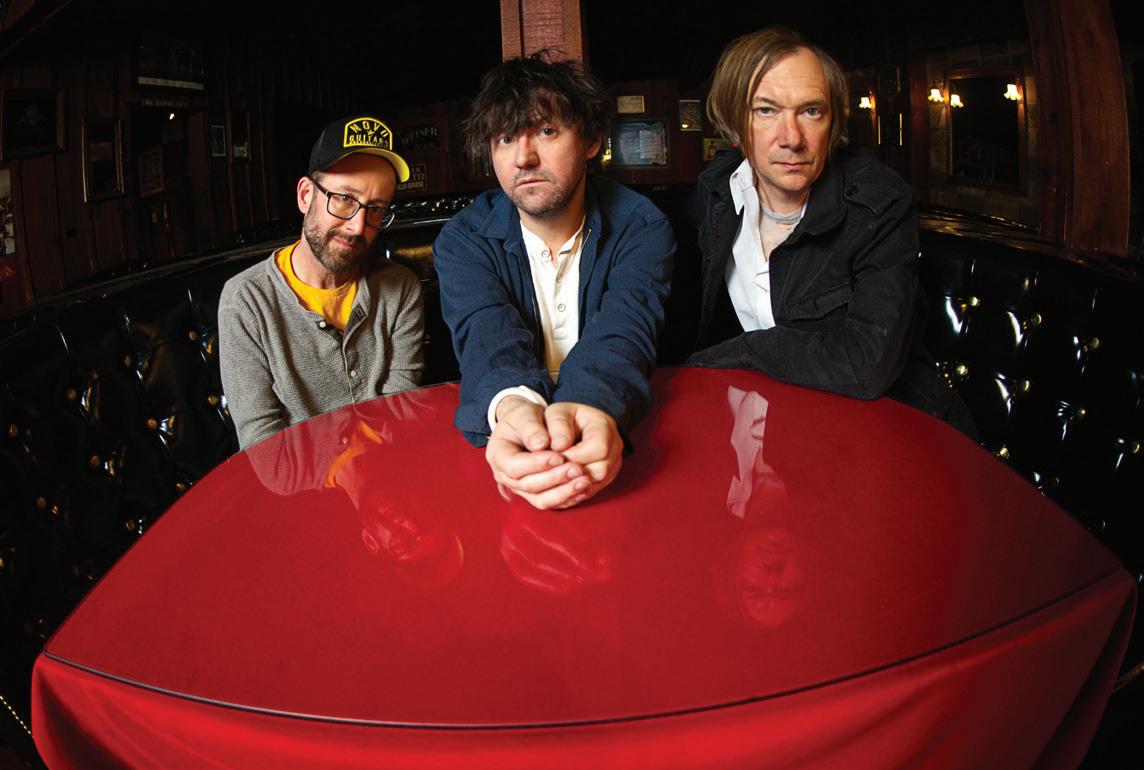
MAR 23 GLORILLA
THE SHED WITH REAL BOSTON RICHEY AND QUEEN KEY
MAR 24 IGGY POP
MAR 25 REFUSED
THE SHED
THE SHED WITH QUICKSAND
MAR 26 & 27 FKA TWIGS
MAR 28 BEN B Ö HMER
APR 1 SNOW PATROL
THE SHED
THE SHED
THE SHED
SALT SHED THE SALT SHED THE SALT SHED THE SALT SHED THE SALT SHED THE SALT THE SALT SHED THE SALT SHED THE SALT SHED THE SALT SHED THE SALT SHED
APR 4 DJ DIESEL AKA SHAQ
THE SHED WITH RIOT TEN, HE$H AND CELO
SHED THE SALT SHED THE SALT SHED THE SALT SHED THE SALT SHED THE SALT SHED
SALT SHED THE SALT SHED THE SALT SHED THE SALT SHED THE SALT SHED THE SALT
THE SALT SHED THE SALT SHED THE SALT SHED THE SALT SHED THE SALT SHED SHED THE SALT SHED THE SALT SHED THE SALT SHED THE SALT SHED THE SALT SHED SALT SHED THE SALT SHED THE SALT SHED THE SALT SHED THE SALT SHED THE SALT THE SALT SHED THE SALT SHED THE
ON SALE NOW
Get showtimes and see reviews of everything playing this week at chicagoreader.com/movies
Plenty of films have tried to trace the downfall of the Italian mafia in America. It’s a familiar story—family ties fray, Cosa Nostra loses its code, and eventually, the cracks run so deep that the family collapses under the weight of its greed and ego, leaving the door wide open for the Feds. From The Godfather (1972) to The Sopranos, we’ve about seen it all. But 82-year-old director Barry Levinson attempts to zero in on something more intimate: the slow betrayal between two lifelong friends, where greed rips apart the mob from the inside out.
Robert De Niro pulls double duty as Frank Costello, the boss of bosses who narrates the story, and Vito Genovese, another high-profile mobster—and Costello’s childhood best friend. Costello is portrayed as a steady hand, a respected man in New York City who keeps the peace a er Lucky Luciano is locked up. But when Vito returns from hiding out on murder charges, he wants more—especially permission to run a heroin operation. Frank sees drugs as the mob’s downfall, but Vito is too hungry for power to care. Their friendship fractures, tensions boil over, and it all leads to a botched hit on Frank, ordered by Vito himself.
The fumbled assassination could be considered a turning point for the mob, a representation of the internal distrust that unraveled everything the Italian American mafia built. Tethered to a tragic story of two friends, the film seems poised to deliver a poignant take. However, The Alto Knights plays more like a dry History Channel special than a pulse-pounding mob movie. This is largely because of the narration, where De Niro’s Costello recalls the downfall with an off-key somberness—a far cry from the reflective storytelling of Ray Liotta in Goodfellas (1990). This is compounded by the stiff dialogue between the two De Niros. Vito feels like he was written for De Niro’s longtime screenmate, Joe Pesci, but instead comes across as De Niro playing Pesci playing Vito.
Though clearly aimed at mob movie fans, The Alto Knights ends up recycling too many of the same familiar stories. To its credit, one of its successes is its portrayal of the Apalachin meeting, the event that signaled public recognition of organized crime across the United States. The sequence becomes one of the film’s most gripping moments, as 60-plus mob bosses lose their nerve while the police storm the convention. Yet, it underscores a larger issue in The Alto Knights: It feels like Levinson is trying to do what the later generations of the mafia sought—to claim his own slice of the pie, just a little too late. —MAXWELL RABB R, 120 min. Wide release in theaters
Michael Fassbender’s character in Steven Soderbergh’s latest is what I imagine legendary British spy writer John le Carré’s most famous character,
George Smiley—a mild-mannered, long-suffering spy with a persistently unfaithful wife—could be if he weren’t such a cuck. Fassbender’s George (the irony is not lost on me) Woodhouse, seemingly staid yet devastatingly handsome, is tasked with discovering who among his British intelligence colleagues—which includes his wife, Kathryn (Cate Blanchett)—is the agent who leaked a powerful, top-secret so ware. Fearful that it’s Kathryn, and committed still to protecting her at all costs, he applies his preternatural skill for uncovering deception to find out what’s going on. This is Soderbergh’s most recent collaboration with screenwriter David Koepp, who together have created nimble thrillers (2022’s Kimi, 2024’s Presence) that would have made Edgar G. Ulmer proud in their cinematic economy. (The people demand more 90-minute movies!) As a happily married couple— even despite the “black bag” secrecy demanded by their profession—Fassbender and Blanchett are equals in every sense of the word. (Perhaps this is the key to their onscreen characters’ marital bliss?) Tom Burke, Marisa Abela, Regé-Jean Page, and Naomie Harris play the four other colleague-suspects; Soderbergh handles ensemble casts well, forming a constellation rather than centering any single person as a lodestar. Pierce Brosnan appears as the group’s boss. In all, Woodhouse’s respect for and devotion to his wife is much sexier than any James Bond film. —KAT SACHS R, 93 min. Wide release in theaters
Sports lend themselves to a certain level of existentialist thought because, much like life, they might inherently be pointless. I write that with appreciation— finding reason where there is none is one of the best things about being human. I thought of this throughout Carson Lund’s feature debut, which documents just about as well as anything I’ve ever seen what it means to care about something that might ultimately be futile, significant only because of the import assigned to it by people striving for light in a dark world.
Cowritten by Lund, Michael Basta, and Nate Fisher—and influenced by Tsai Ming-liang’s Goodbye, Dragon Inn (2003), which is set during the final screening of an old movie palace—the film centers on the final game at Soldiers Field, a quaint baseball stadium in a small New England town in the 1990s. Two local teams are playing for the final time, their beloved field set to be paved over for a neighborhood school. The game, which goes into long overtime, composes the duration, and not much of note takes place; rather, the significance is the film and the field’s looming cessation, a er which the fate of the men’s connection hangs in the air, much
like the titular low-speed pitch. (Former Boston Red Sox player Bill “Spaceman” Lee, known for his personal version of the pitch, the “Leephus,” makes a cameo.)
“Why do they care so much?” asks the young daughter of one of the players, as she watches the game, bored out of her mind. That very question is the whole point itself, but less so why and just the fact that they do it at all. There’s long been overlap between baseball and film, so it’s appropriate that noted documentary filmmaker Frederick Wiseman makes a voice cameo as a sports radio announcer. —KAT SACHS 98 min. Music Box Theatre
A man beaten down by the corporate world feels no physical pain. When the girl he is crushing on is kidnapped by bank robbers, he assumes the role of a lovestruck vigilante, using his unassuming “power” to hunt them down. This premise is plucked straight out of the imagination of a middle school boy.
The painless protagonist is Nathan Caine (Jack Quaid), our pseudosuperhero in Novocaine. His pseudosuperpower is the result of a rare genetic disorder, congenital insensitivity to pain, which makes him invulnerable to any pain stimulus. This doesn’t mean he can’t get hurt; his apartment is decorated with safeguards, from tennis balls on the corners of tables to a marker on his shower knob to prevent him from unknowingly stepping out with third-degree burns. This paranoia— instilled, in part, by his worried parents—has caused Nathan to be an introvert.
Nathan keeps a day job as a low-level bank executive. There, he’s starry-eyed for one of the bank clerks, Sherry (Amber Midthunder). The flirtation is evident from the beginning, with Sherry sneaking up behind
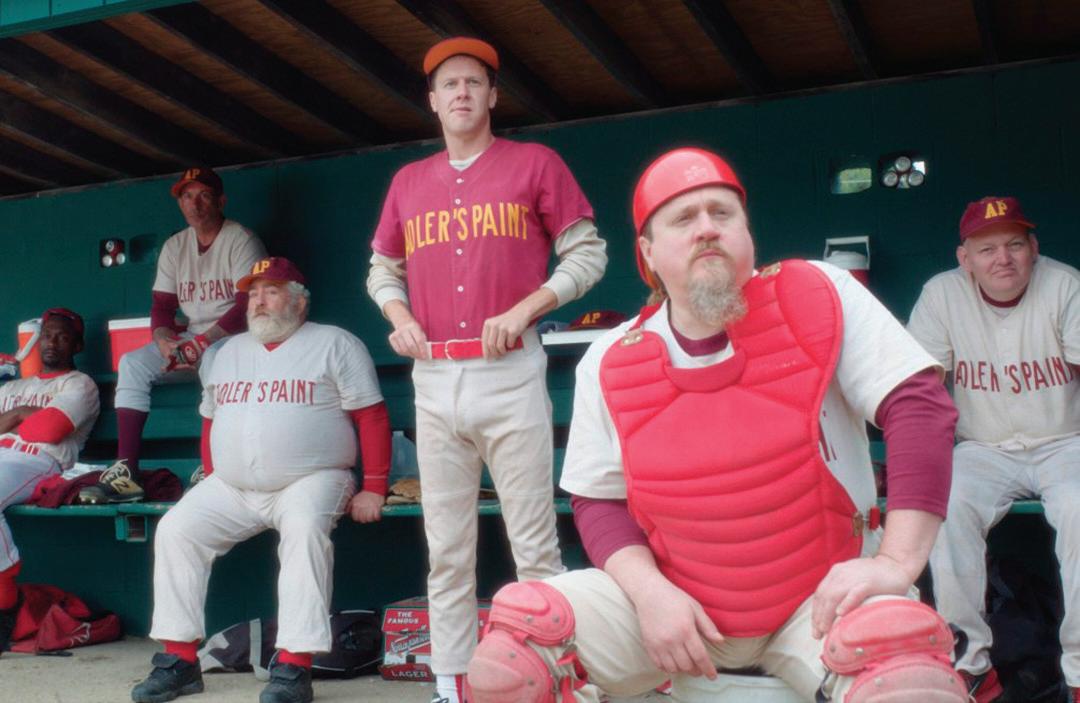
Nathan as he pours hot coffee all over his hand (no harm done). As he’s caring for his burns, she asks him out for lunch, and next thing you know, they’re sitting over cherry pie (which Nathan’s never tried in fear of biting off his tongue). She pushes him to try it, and he does so with ecstasy. She is doing something Nathan has never experienced: making him vulnerable.
But he leans in. They go out to a bar, and some old bullies tease him about his old nickname: Novocaine. Sherry tricks one bully into drinking extra-extra-hot sauce, and they leave. The film clumsily tries to build emotional connection between the two, and a er a skimmed-over night together, Nathan is head over heels. It all unravels when Sherry is kidnapped during a bank robbery by a trio of Santa Clauses the next morning. Nathan—feeling the adrenaline of love at first sight—decides he will do anything to get her back. What follows is a cornucopia of violence as Nathan gracelessly pursues the kidnappers. It’s enough to make the most seasoned gore-movie-watchers uneasy, making Nathan into a ragdoll for about an hour and a half. It’s a repetitive bloodbath without the adrenaline of some action marathons like John Wick. Instead of wondering how much more Nathan Caine can endure, I’m le wondering how much more Novocaine I can stomach. —MAXWELL RABB R, 110 min. Wide release in theaters
It’s perhaps ironic that, at the beginning of the film, the allure and comfort of the past coincides with its traumatic impact for the protagonist of Zambian-Welsh writer-director Rungano Nyoni’s sophomore feature. Shula (Susan Chardy), dressed in an iconic throwback look—Missy Elliot’s voluminous black jumpsuit and metallic headpiece from her 1997 music video for “The Rain (Supa Dupa Fly)”—is on the way home from a fancy dress party when, on the side of the road, she finds her Uncle Fred’s dead body. Her reaction is impassive; her more expressive cousin, Nsansa (Elizabeth Chisela), then inexplicably shows up, and the tense familial dynamic begins to unfold as we learn of the uncle’s sexual molestation of Shula, Nsansa, and other female family members. Set in the Zambian suburbs, the film also deals with the tension between modernity, as represented by Shula (who drives a nice car and seems to have a white-collar job), and tradition, manifesting here in the context of long-standing familial trauma. Much like Nyoni’s debut feature I Am Not a Witch (2017), there’s a quiet conviction to the proceedings, letting the hypocrisy and resultant upheaval speak for themselves, with a bit of humor to highlight and temper the dark absurdity; there’s an assuredness to Nyoni’s filmmaking that’s yielded an impressive consistency. A recurring motif of rooms being unceremoniously flooded with water calls to mind the films of Tsai Ming-liang, suggesting a similar hypnotizing quality even as the films’ stories are rooted in real life. Its title is inspired by a children’s show that Shula and her peers are shown to have watched, which shows us viewers that guinea fowls are a symbol of protection as animals that alert others to danger. The seemingly metaphorical title takes on a more literal meaning as the film progresses, further differentiating the sometimes misguided whimsy of tradition and the concrete actions of those brave enough to seek change. —KAT SACHS PG-13, 99 min. Gene Siskel Film Center v
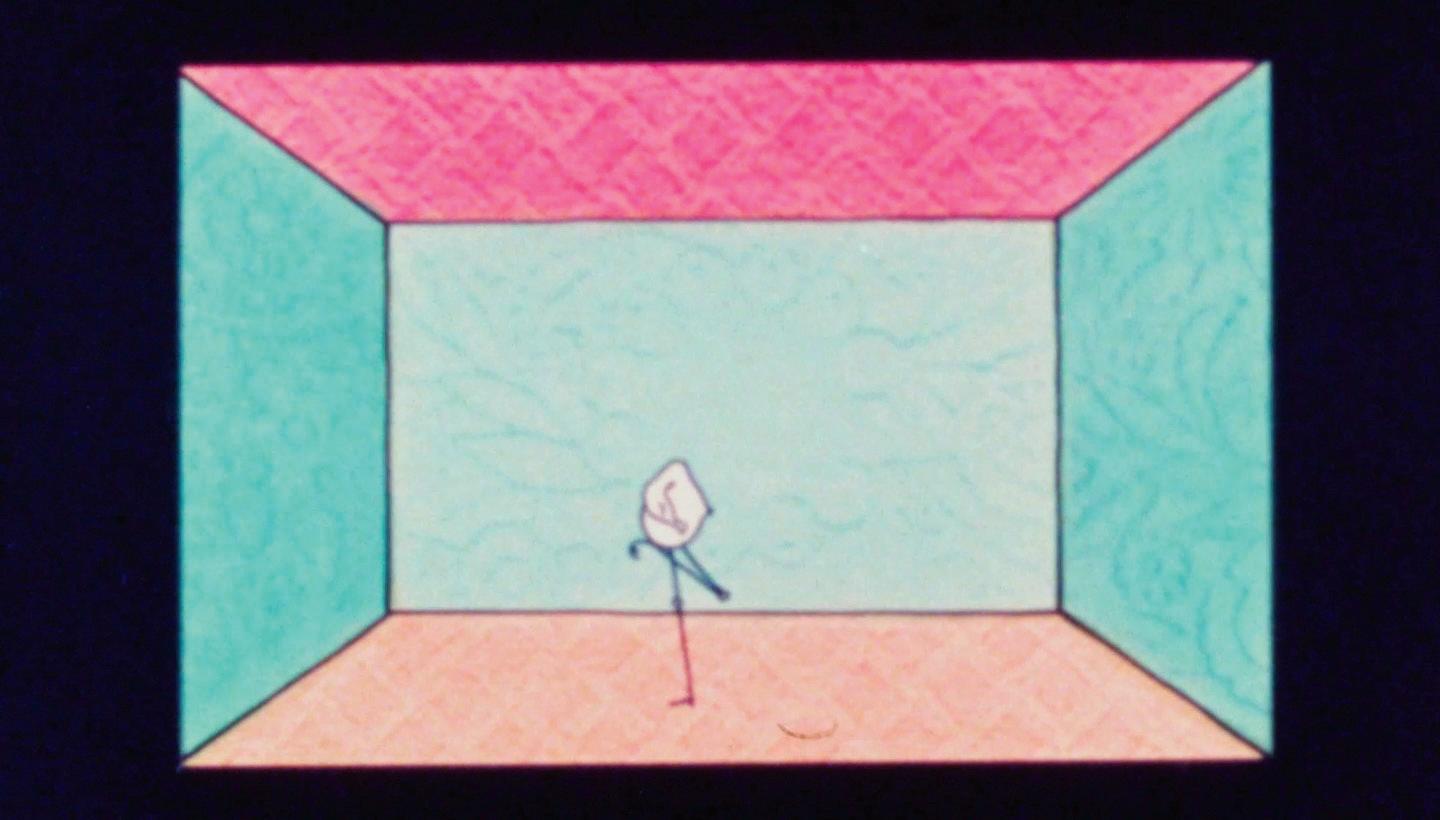




Unsurprisingly, experimental animation is my favorite kind. The potential is limitless— truly, anything is possible in this realm. Thus the highlight of my moviegoing week was the third program in the Picture Restart series at Chicago Filmmakers, aptly titled Animated Breakdowns. The aptness has to do with the “breakdown” part, as the six short animated films (all from the Picture Start collection) confront viewers with seemingly simple craftsmanship that nevertheless draws—hee-hee—attention to their construction and the myriad ways that meaning can be a ected.
To some extent, I imagine the art of animation must be pretty isolating, the literal cel becoming a figurative one; ironically, limitations can yield that limitless innovation, and the confined space of a metaphorical canvas becomes a sacred space. Karen Kiser, onetime animator for Gumby and longtime Pixar animator, seemed to consider this in Solitaire’s Sanctuary (1987), wherein a line-drawn bird begins constructing a box, outside the boundaries of which exists the horror of others. It’s inside the box, alone, that the bird can become the fully realized figure it’s meant to be.
The other two films I liked inspired the whole program, as curator Ben Creech noted during his introduction. Carter Burwell’s Help, I’m Being Crushed to Death By a Black Rectangle (1978) is delightfully tongue-in-cheek. (Burwell’s name may be recognizable—he’s a film composer who’s worked with the Coen brothers, Todd Haynes, and many others.) My favorite bit is when the core gag of a woman on train tracks being crushed by a black box is transposed to a di erent time and place: last year, in Marienbad, a reference of course to Alain Resnais’s Last Year at Marienbad (1961). This is a more obvious metatextual reference, but really, most of the films are a reference unto themselves,
A still from Solitaire’s Sanctuary (1987) CHICAGO FILMMAKERS

giving a peek behind the curtain, so to speak.
Osamu Tezuka’s Broken Down Film (1985) makes
Lfun of its own perception, replicating projection errors and deterioration of its source material to confuse viewers. All of these were super fun to watch with an audience, who also appreciated the visual puns. The kids in the audience especially seemed to enjoy it. Their laughter provided a nice soundtrack.
Speaking of which, on Monday, I went to see Oscar Micheaux’s 1920 silent film The Symbol of the Unconquered—or at least what still exists of it—at the Music Box Theatre, presented by the Chicago Film Society and with live musical accompaniment by the Alvin Cobb Jr. Trio. It’s always gratifying to see a Micheaux film projected, but just as big a draw was the music; I’ve seen the band accompany silent films a few times now, and it’s always a cinematically and musically illuminating experience.
Otherwise, I’ve been watching a lot of films for review, including Carson Lund’s Eephus and Steven Soderbergh’s Black Bag , both of which I reviewed for the paper this week (see p. 26). I’ve also previewed several films from the Chicago Palestine Film Festival (see p. 22); I’ve been a ected and inspired by these films most of all, though in general I’m feeling a bit inert, not really excited about anything in particular. Very unanimated, if you will. It happens—the only way to get over it is to get through it and keep watching.
To that end, I’m still working to catch up on my resolution to see on average one film per day in theaters. More on that at the end of the month!
Until next time, moviegoers. —KAT SACHS v
The Moviegoer is the diary of a local film bu , collecting the best of what Chicago’s independent and underground film scene has to o er.


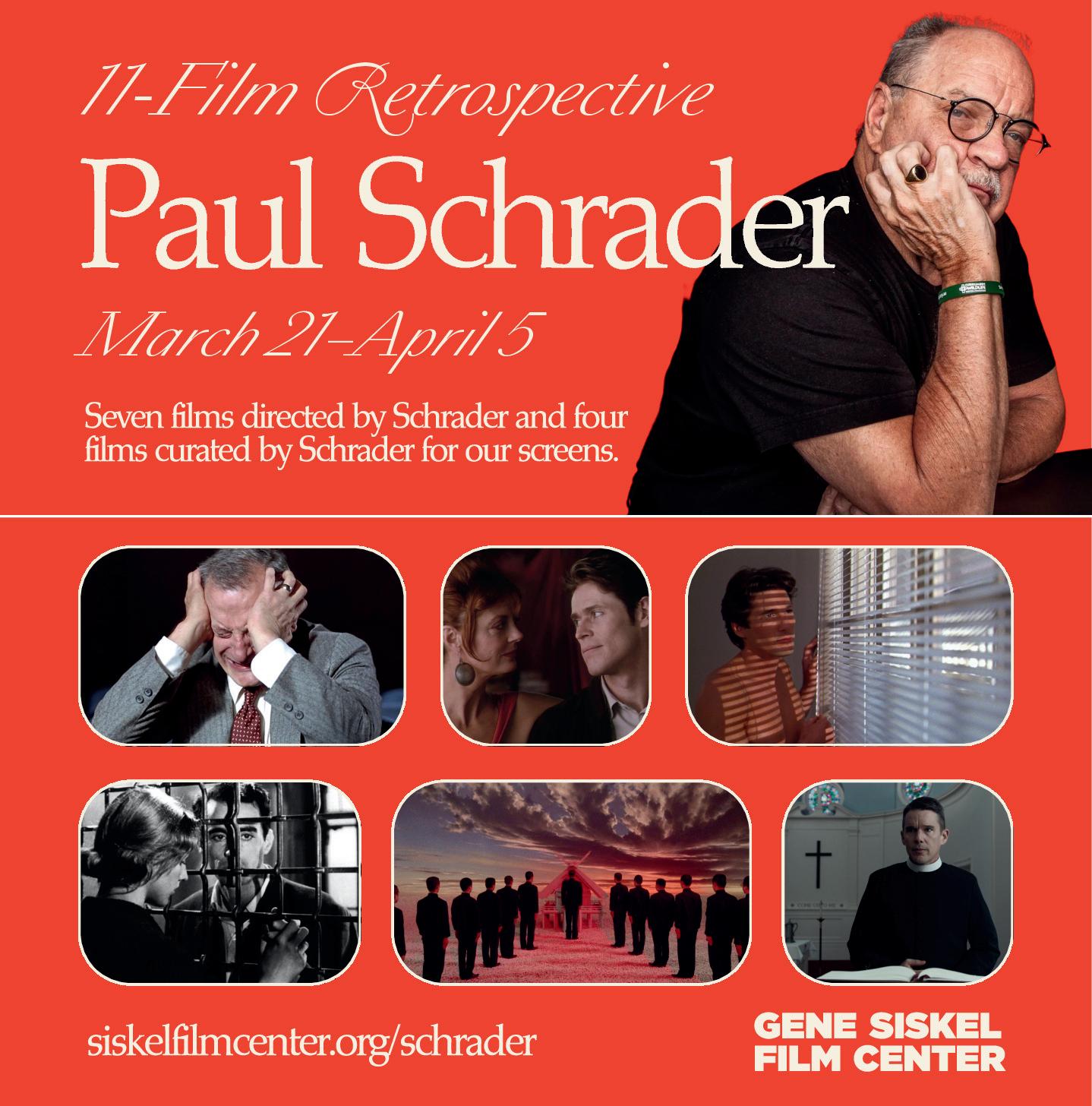
He sang in the Soul Stirrers with Sam Cooke, duetted with Fontella Bass, and collaborated with Swamp Dogg, but he always fell short of stardom.
By STEVE KRAKOW
Since 2005 Plastic Crimewave (aka Steve Krakow) has used the Secret History of Chicago Music to shine a light on worthy artists with Chicago ties who’ve been forgotten, underrated, or never noticed in the first place.
Occasionally the Secret History of Chicago Music is a tale of two cities. Soul singer Bobby McClure worked mostly out of Chicago and Saint Louis, but he didn’t get the recognition he should have in either place. He recorded for some of the greatest soul labels of all time (including Hi Records and the Chess/Checker family), helped jump-start the careers of future stars such as Fontella Bass, and sang with Sam Cooke, one of the founding fathers of R&B.
I know only one true-blue fan of McClure’s work: my old roommate Benjamin Pirani, who helped found the Windy City Soul Club and now lives in New York. He’s a soul music expert and has a few releases of his own as an R&B singer on the Cherries and Colemine labels. “McClure could do a bit of everything,” Pirani says, “like that hard shouting style that comes from the south but also that very Chicago sweet soul sound.” But McClure isn’t even mentioned in Robert Pruter’s 1991 book Chicago Soul , widely considered the bible of the genre. Needless to say, he doesn’t deserve to be that obscure.
Bobby McClure was born in Chicago on April 21, 1942, but his family moved with him to Saint Louis when he was an infant. By age nine he was singing in church, where the best soul artists started, and in the 1950s, his clear tenor voice set him apart from the pack. McClure soon graduated to performing in gospel
groups, and while still a teenager, he sang with the venerable Soul Stirrers, then led by Cooke. Alas, he doesn’t appear on any of the group’s recordings.
Like Cooke, McClure would move into secular music in the late 1950s, trying his hand at doowop in Bobby & the Vocals and singing R&B in a band led by saxophonist and drummer Oliver
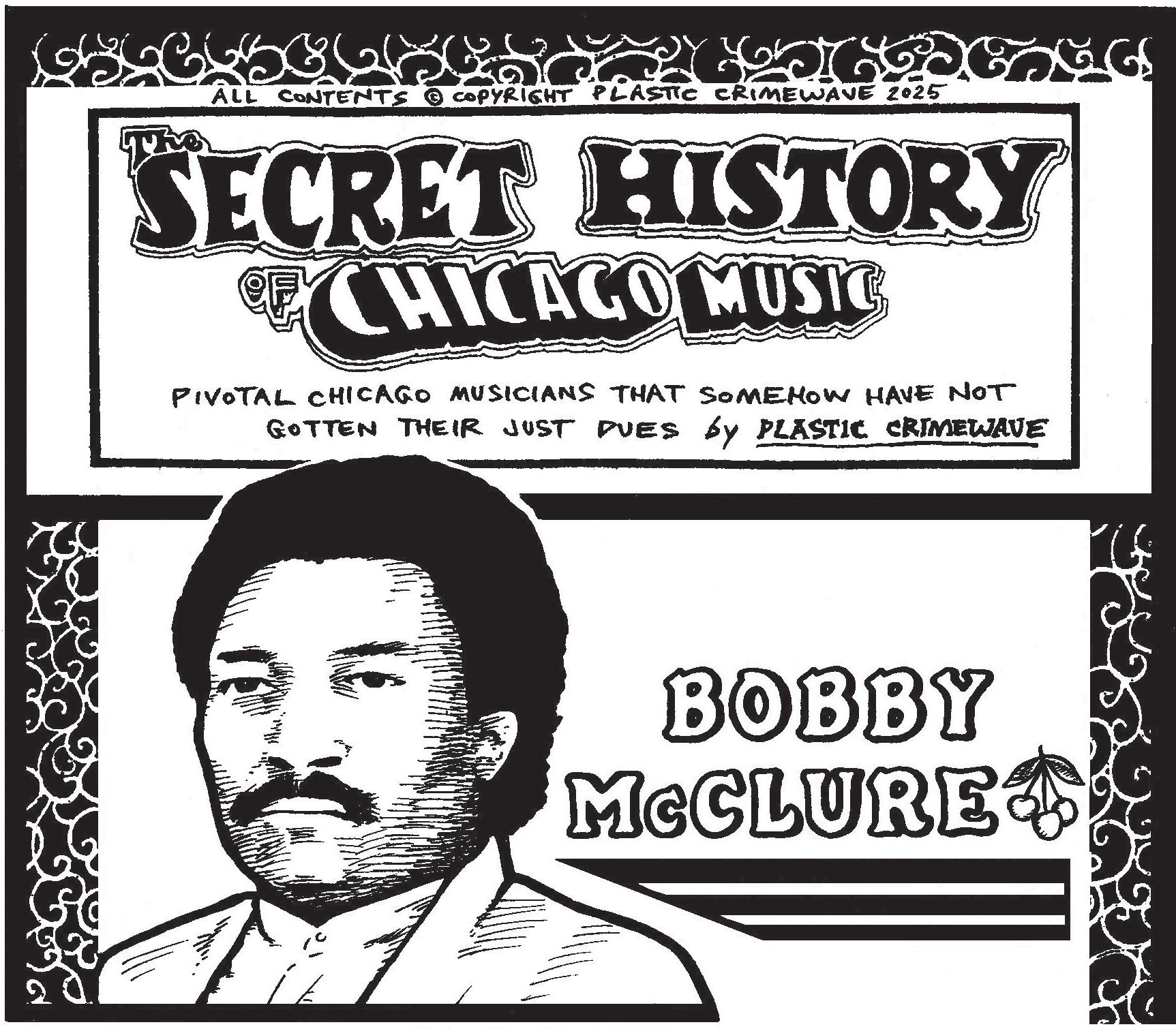
Sain. At around that time, Sain became musical director for blues singer and guitarist Little Milton, in whose group Fontella Bass played keyboards and sang—a connection that would soon prove significant for McClure.
I’ll admit I’m not sure which of McClure’s gigs happened where—the Soul Stirrers were based in Chicago when he was involved, for instance, and lots of artists traveled between Saint Louis and Chicago to work. Bass and McClure ended up the two lead singers in Sain’s soul revue after Sain parted ways with Little Milton, and at some point in the mid60s they moved separately to the Windy City. Bass would marry trumpeter Lester Bowie, who came to Chicago from Saint Louis in 1966 and joined the group that would evolve into the Art Ensemble of Chicago.
McClure and Bass continued to collaborate, and in 1965 they released a duet for Checker: the snappy “Don’t Mess Up a Good Thing,” written and produced by Sain, which hit num-
ber five on the Billboard R&B chart and number 33 on the Hot 100. The tune would prove to be McClure’s most commercially successful— and it was later recorded by Booker T. & the MG’s, Gregg Allman, Ry Cooder, and the duo of Loretta Lynn and Conway Twitty. Later in ’65, McClure and Bass followed up with the sassy and classy “Don’t Jump” b/w “You’ll Miss Me (When I’m Gone),” but it didn’t do as well. Their duo dissolved shortly thereafter, because Bass’s solo career took o : Her next session, which included saxophonist Gene Barge, backing vocalist Minnie Riperton, and future members of Earth, Wind & Fire, would produce the timeless smash “Rescue Me.” McClure also made his own solo debut in 1965, working with Chess Records imprint Checker on the funky, bluesy “I’ll Be True to You,” cowritten by Sain. This dance-floor groover is now a beloved classic with the Northern Soul set, a music fandom that arose in the UK in the late 60s and still exists today.
McClure followed it with two more Checker singles: “You Got Me Baby” b/w “Peak of Love” in 1966 and “Baby, You Don’t Love Me” b/w “Don’t Get Your Signals Crossed” in 1967. Both could’ve been dance-floor sensations, but only “Peak of Love” did well, reaching number 16 on the R&B chart.
In the early 70s, McClure made a couple singles for the smaller Cedric label, run by songwriter and producer James Vanleer. Cedric was also home to greats such as Jackie Ross and Don Gardner, and Vanleer’s next operation, Sedgrick Records, added Bobby Rush. McClure’s 1970 track “Love’s Comming [sic] Down on Me” slaps with crackling energy, and its B-side, the smooth, horn-led “Never Let You Get Away,” reappeared in 1971 as the A-side to “Have a Little Mercy,” making for a perfectly sweet single of out-of-time Chicago soul.
McClure then returned to Saint Louis, where in ’75 he released the smoky “I Got a
Good Women [sic]” b/w “Begging You Baby” through the local Vanessa label, run by his old collaborator Oliver Sain. That same year, his gooey, string-soaked track “You Bring Out the Love in Me” shared a split 45 on Island Records with “Daybreak” by disco-tinged group Survival Kit. McClure’s radio-friendly tune has been sampled in “Bring Out the Love” by Dj Quads in 2017 and “Revolving” by Yung Bae in 2020.
Next McClure signed with Memphis’s legendary Hi Records, at the time still home to Al Green but on the downslope of the string of huge successes Green had with the label. McClure debuted on Hi with the 1976 single “Doing It Rite on Time” b/w “She’s Miss Wonderful,” and I have no clue why its slamming, disco- adjacent funk didn’t rocket up the charts. It was the first of several excellent singles he released through the label, including 1977’s clavinet-fueled “I Ain’t Gonna Turn You Loose” and 1978’s pleading “To Get What You Got.” All of McClure’s output for Hi was produced by future electro-dance pioneer Don “O’Mar” Boddie, usually working with label head and studio wizard Willie Mitchell.
After this point, I get even less confident about what McClure was doing where. He worked in an Illinois penitentiary as a corrections o cer and started his own label, called B-Mac, in Saint Louis in the early 80s. McClure
S.D.E.G. imprint run by famed funky bluesman Swamp Dogg. (In 1994, Shanachie reissued it as Younger Man Blues.) Swamp Dogg produced the album and wrote nine of its ten songs, and it has a drum-forward, high-gloss
put out the first of several B-Mac singles in 1981, the two-part “You’ve Got the Makings,” a sleek and tuneful bit of boogie soul written and coproduced by Boddie. Working with Los Angeles label Edge Records, in 1986 McClure released “You Never Miss Your Water” b/w “It Feels So Good (to Be Back Home),” which could’ve competed with Luther Vandross, Kool & the Gang, New Edition, or any other soul on the charts at the time.
In 1988, McClure released The Cherry LP on Japanese label P-Vine. It also came out in the States, with accompanying singles, on the



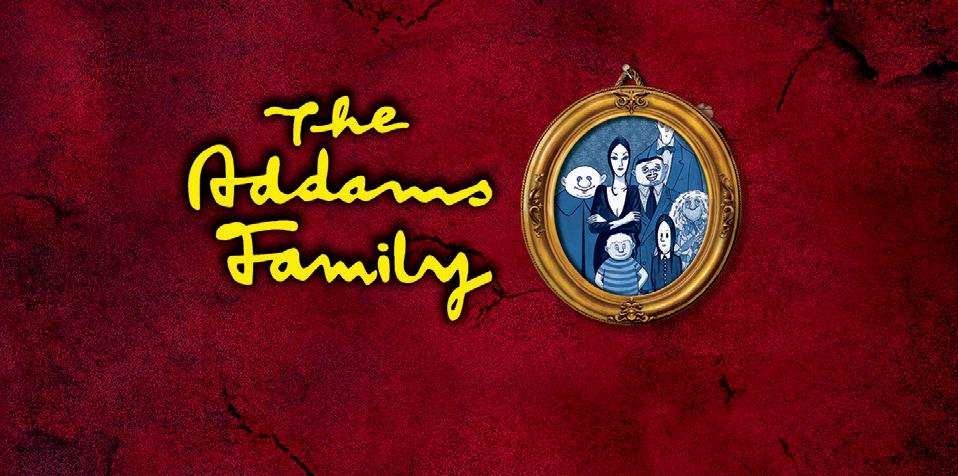
80s sound. Grittier tracks such as “Today You Started Leaving Him (and Loving Me)” and “Younger Man Blues” sit nicely beside doowop-style throwbacks “Cherry Pie” and “Do Do Do Doop (Please Come Back).”
McClure remains a Northern Soul favorite, but it’d be great to see him get the respect in Chicago that he sees overseas. “McClure seemed like he was looking for the place to be,” says Pirani. “But he sold records here, evidenced by the proverbial crates of easily had, quality titles I’d find in Chicago in the day.” If an esteemed local label released a McClure box set, that would definitely help. Numero Group, you listening? v
The radio version of the Secret History of Chicago Music airs on Outside the Loop on WGN Radio 720 AM, Saturdays at 5 AM with host Mike Stephen. Past shows are archived at outsidetheloopradio.com/tag/secrethistory-of-chicago-music.

McClure had moved to Los Angeles by the time of his death, which came much too early: He passed away at age 50 on November 13, 1992, from complications of a stroke following a brain aneurysm. His music is still out there, though, on compilations such as Peak of Love (released by P-Vine in 1991), Hi Records Presents Bobby McClure & Willie Clayton (from 1992), and Chess Northern Soul (curated by Mojo magazine in 2005).


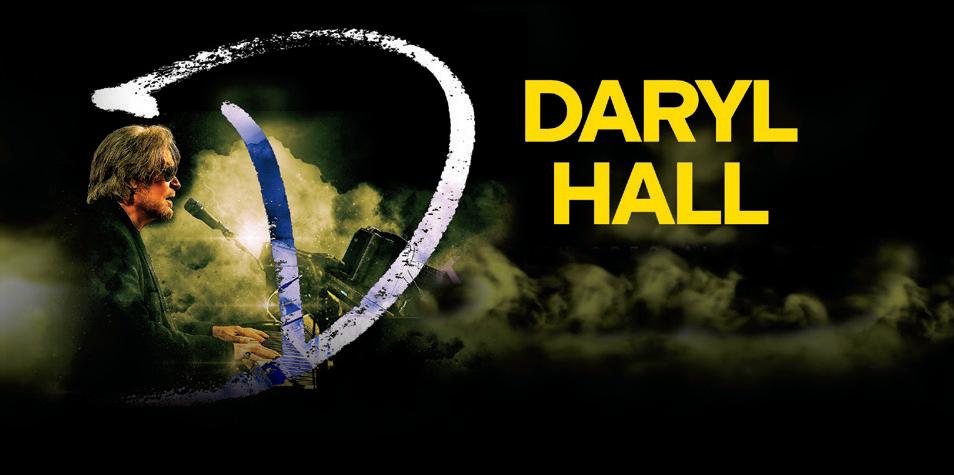


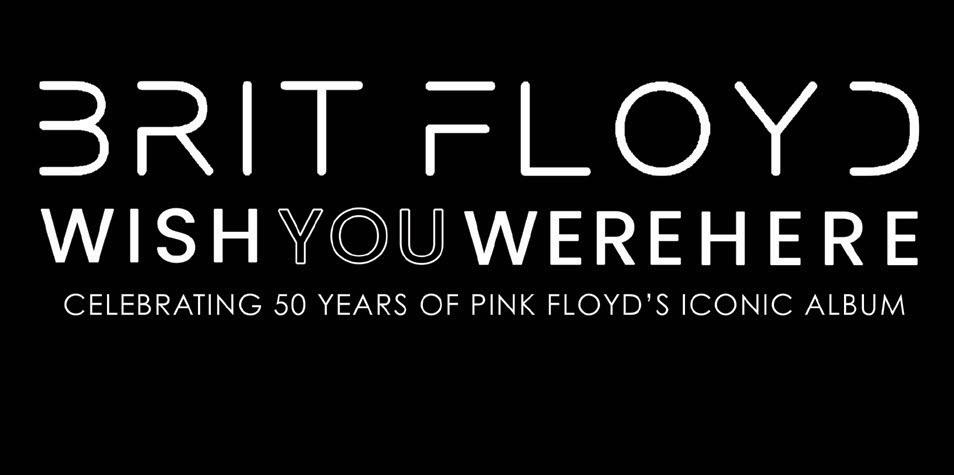



their life as they make their music—their way
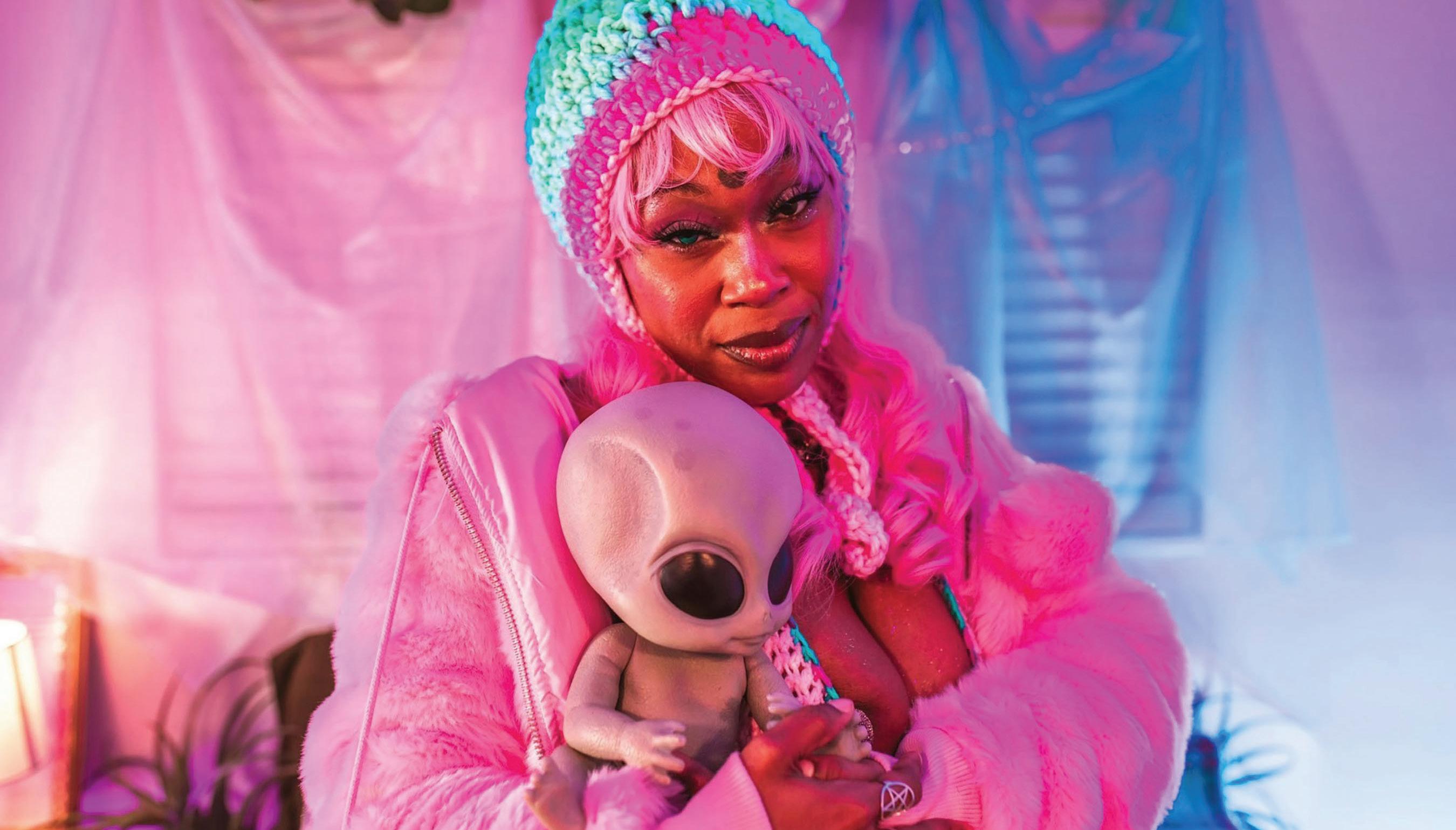
BBYMUTHA, ERIC DONTÈ, NOUGHTIE DEE Fri 3/21, 9 PM, Sleeping Village, 3734 W. Belmont, $25, $20 in advance. 21+
BRITTNEE MOORE, WHO MAKES MUSIC AS BBYMUTHA, is a Chattanooga Soundcloud rapper who can wield a bar like a broadsword. In the early 2010s, they started to gain attention through collaborations with Philly DJ and producer LSDXOXO, most notably appearing on “Black Widow” from his 2014 mixtape, Whorecore. Moore put out ten EPs and mixtapes over the next few years, and in August 2020 they finally dropped their first full-length—a 25-track behemoth called Muthaland littered with 90s-style rap skits and cameos from the likes of Baby Tate and Zelooperz. Soon after the release, they announced on Twitter: “After this album I’m never doing this shit again ever. Fuck this shit. Its way too stressful for no fucking reason.” Luckily, Moore came back to their musical grind, and last April they dropped their second record, Sleep Paralysis
While Moore has been erroneously compared to all kinds of female rappers, they’re a nonbinary femme on a freak vibe all their own. They’ve got a black crescent moon tattooed on their forehead, and they crochet their own club gear. They’re also the mother of two sets of twins. Their stage name is the reclamation of an insult: On social
media, the woman their boyfriend at the time was also seeing referred to Moore as “the baby mama.” That boyfriend had once forced Moore to get an abortion and then thrown a barbecue, which Moore saw as a celebration of the termination of the pregnancy. Adopting the moniker BbyMutha has allowed them to face the pain of that experience while honoring the strength required to be a single mom—though the name also nods to being something of an emotional child with adult responsibilities. Through their music, they can make art of their multitudes.
As a low-income parent pursuing music, Moore gets a lot of shit, especially on social media. “Everybody thinks I’m supposed to be doing something else,” they told Dazed in 2017. “They’re all like, ‘You need to get a real job,’ and it’s just like, ‘This is my job!’ I live in a small town, so a good ‘real job’ is working at the Amazon warehouse.” If those are your choices, why not pursue your dreams and present a new possibility of motherhood? Should artistic ambition be reserved for childless people with more resources or for people raising kids with a spouse? Moore boldly declares “fuck no.” —MICCO CAPORALE
BbyMutha See Pick of the Week at le . Eric Dontè and Noughtie Dee open. 9 PM, Sleeping Village, 3734 W. Belmont, $25, $20 in advance. 21+
Flesh of Fruit Sharon Udoh & Cristal Sabbagh open. 8:30 PM, Constellation, 3111 N. Western, $20. 18+
Flesh of Fruit make experiential experimental compositions. The duo of local sound artists Allen Moore and Hunter Diamond have been creating sounds together for the past five years. Diamond, a multi-instrumentalist who centers his work on the saxophone, plays in improvisational settings and more traditionally structured ensembles, including jazz quartet Black Diamond (which he leads with saxophonist Artie Black) and Ethiopian-inspired psychedelic funk group Radio Outernational. He also collaborates with artists working in various disciplines across the city’s diverse creative landscape, including dancer Irene Hsiao (also a Reader contributor) and performance poet and author Marvin Tate. Moore is an accomplished visual artist as well as a musician. He uses graphite in many of his paintings and sculptures, and he eventually began casting records out of the mineral by hand. Those platters create a ghostly sound under a turntable needle, which provides the foundation for the soundart compositions on Flesh of Fruit’s brand-new selftitled debut album.
Much of Moore’s work explores signifiers of the Black experience. His recent sound- and visual-art exhibition at Elastic, “Sunday Mourning” (which closed at the end of February), was an investigation of Black death and Black grief. Flesh of Fruit continues this thematic exploration of Black identity through sounds that evoke the Black diaspora. A blast of Diamond’s saxophone on “Frontiersmen” sounds like a train-station announcement, while Moore’s records shuffle in with the clicking of heels; the platform fills up with percussive and spectral sounds, and the train takes off toward unknown destinations. This passage brings to mind the hardships of the Great Migration, as each pop and crackle of the record feels like a bump on the southern roads leading north and west. Flesh of Fruit uses woodwinds and graphite to conjure Afrofuturistic visions that aspire to a better world.
SATURDAY22
Ibelisse Guardia Ferragutti & Frank Rosaly Jeremiah Chiu opens; Fanita Banana DJs. 9 PM, Sleeping Village, 3734 W. Belmont, $20. 21+
On their 2024 debut album, Mestizx , multidisciplinary artist Ibelisse Guardia Ferragutti and longtime improvising musician Frank Rosaly explore disparate experiences of Latinx identity to confront the lasting impacts of colonialism. Together, the married couple create a shared language of simmering, kaleidoscopic grooves and incantatory vocals that moves them toward a sense of gravity and wholeness. “It’s not related to how deeply Recommended
—SALEM COLLO-JULIN

I am Puerto Rican or how deeply Ibelisse is Bolivian or Brazilian,” Rosaly explains in a short album promotion documentary produced by International Anthem, which released the album in partnership with Nonesuch. “We are connected to the land itself, to the ancestry that lives inside of us in our DNA, that was given for and took life in this music.”
In creating the material for Mestizx, the couple worked through their individual journeys of fractured identity. Ferragutti, a self-described neomestiza and spiritual activist, was born into a very musical family in Bolivia and raised in Brazil, where she studied classical piano. She moved to the Netherlands at 19 to learn improvisational dance and music. Rosaly is Puerto Rican but grew up in Arizona before moving to Chicago, where he embedded himself as a drummer in the local improvised-music and free-jazz scene. (He’s the founder of experimental electroacoustic label Molk Records.) In 2016, he moved to Amsterdam to be with Ferragutti a er a
chance encounter at a show, and they’ve lived there together ever since.
Ferragutti and Rosaly are each shaped by and alienated from their heritages in different ways, but they find common ground in feeling split between multiple cultures and not fully understanding what’s “theirs.” On Mestizx, they employ a diverse array of instruments—Ferragutti contributes mostly vocals and keyboards, Rosaly mostly percussion and electronics, and upwards of half a dozen guests add piano, cornet, bass, flute, harmonica, and much more. They combine the intuitive give-and-take of jazz with elements of cumbia, bomba, art-rock, and more into a singular voice. It’s audio magic born from reveling in the paradox of their experiences. “Soy el problema y soy la respuesta,” Ferragutti sings on the title track. It means: “I am the problem and I am the answer.” For this performance, the duo will be joined by keyboardist Ben Boye and three guests from the album: Matt Lux (bass), Ben
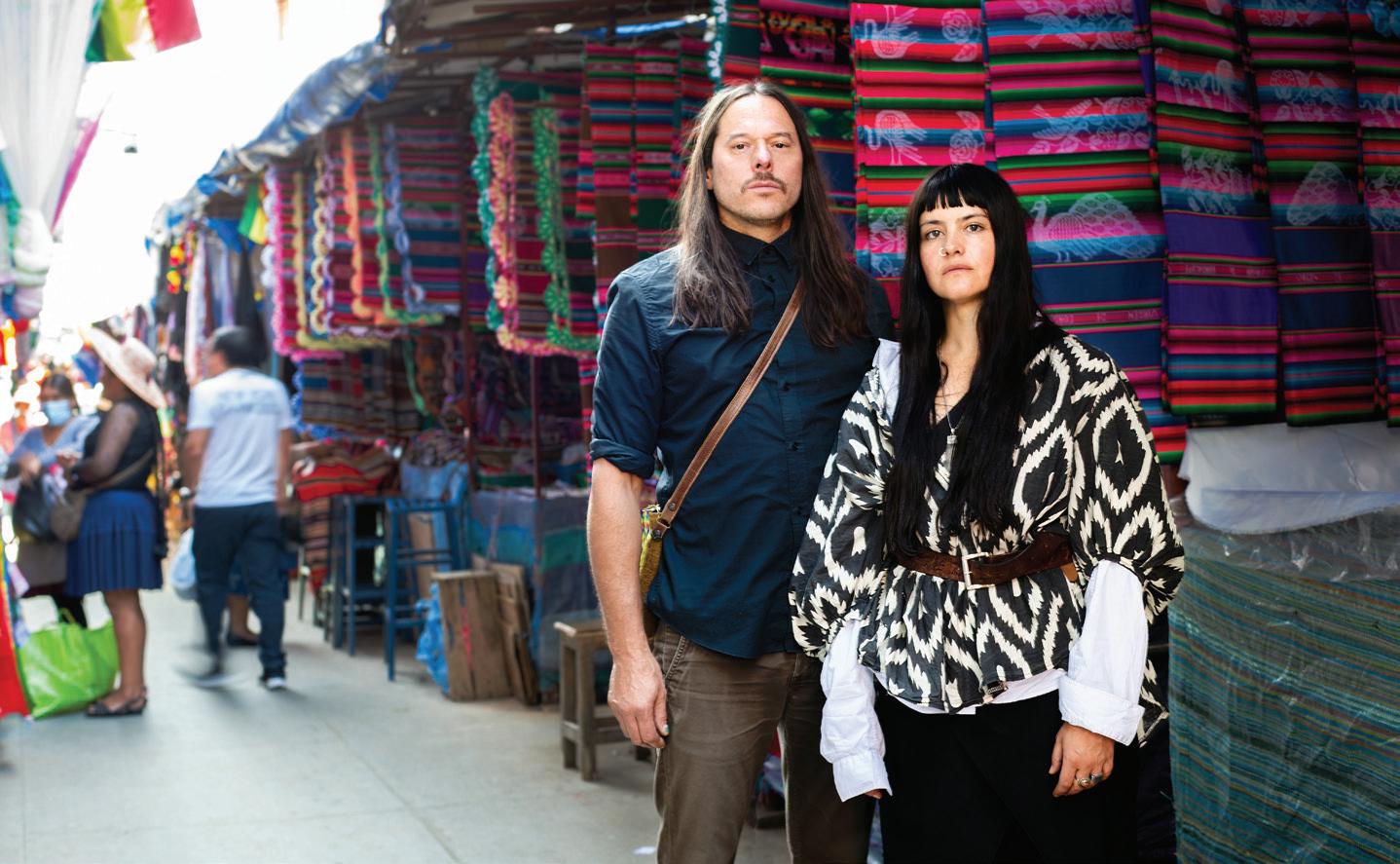
LaMar Gay (cornet, vocals), and Rob Frye (woodwinds). —MICCO CAPORALE
Quest Master Fief, Mors Vitaque, and Sorrowmoon open. 9 PM, Empty Bottle, 1035 N. Western, $15. 21+
Step into the pixelated mists of Quest Master. Australian dungeon-synth artist Lord Gordith (better known among punks as Gordo Blackers of Steröid) launched Quest Master onto the scene in 2017 with a double cassette titled Lost Songs of Distant Realms, which uses Yamaha and Casio keyboards to evoke nostalgia for 90s RPGs and their epic journeys and battles in eight-bit worlds populated by knights and dragons. The release became a sensation among chiptune appreciators and fantasy enthusiasts, and in 2019 it was reissued on CD and vinyl by Out of Season—one of the first American labels to concentrate on dungeon synth.
Quest Master’s sound has since matured past this imaginative but faithful homage to early questbased home video games: The lush, complicated soundscapes on 2023’s Sword & Circuitry (Out of Season) have a chintzy, emotive quality that recalls the ambience of Twin Peaks while maintaining a distinct energy and narrative propulsion. Despite flourishes of 80s synth-pop and wriggling earworms from The X-Files soundtrack, these ethereal, vibrant, densely layered songs are unmistakably modern.
At a cultural moment when it’s easier than ever to find a Dungeons & Dragons or Magic: The Gathering game in Chicago (the Empty Bottle, where Quest Master stops on this tour, has hosted a few of both), dungeon synth has found a warm welcome in the city’s rich electronic-music and noise scene. At this show, Quest Master will cap a bill full of artists on the cutting edge of the fantasy sound: Salt Lake City’s Fief (also on Out of Season) bring a folkloric quality to their music, locals Mors Vitaque veer toward the lugubrious and romantic, and Fort Wayne’s Sorrowmoon skew more sinister. The latter two have released music through Great Lakes Dungeon Synth, a regional collective and label that in October threw the first midwest festival for dungeon-synth lovers, the Great Lakes Dungeon Siege, in Fort Wayne. —MICCO CAPORALE
TUESDAY25
Refused Quicksand and Racetraitor open. 7:30 PM, Salt Shed, 1357 N. Elston, $55–$187.50. 17+
Refused formed in Umeå, Sweden, in 1991 and spent the better part of a decade making ferocious, politically charged punk and hardcore. Though notoriously resolute in their le ist values, their aesthetic approach became increasingly fluid—they experimented with jazz, electronic music, metal, and more. When Refused played off the title of Ornette Coleman’s seminal 1959 avant-garde jazz album, The Shape of Jazz to Come, for their third record, 1998’s The Shape of Punk to Come, they were making a sincere artistic statement and delivering a tongue-incheek middle finger to purists and haters. “We did [it], in many ways, as a protest against what we felt was the conservative idea of what punk and hard-

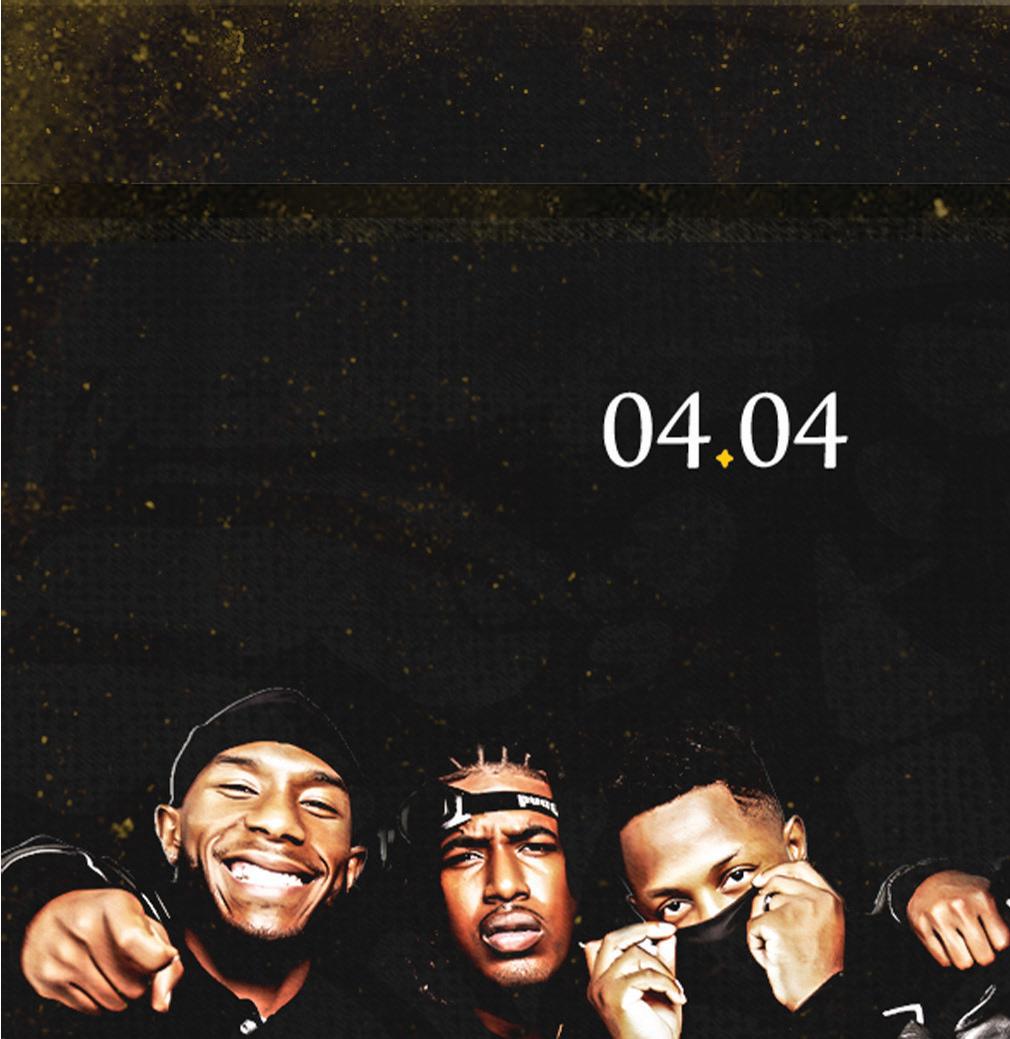
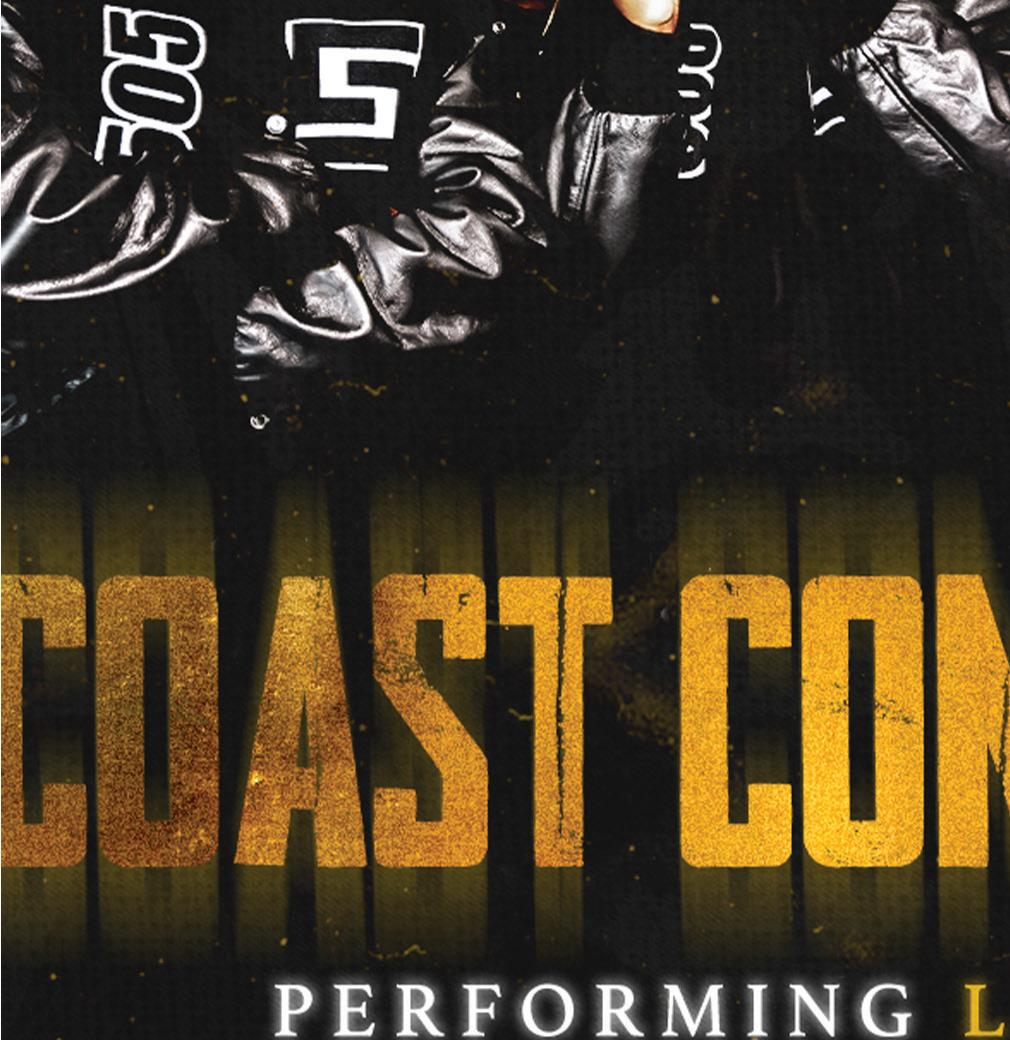
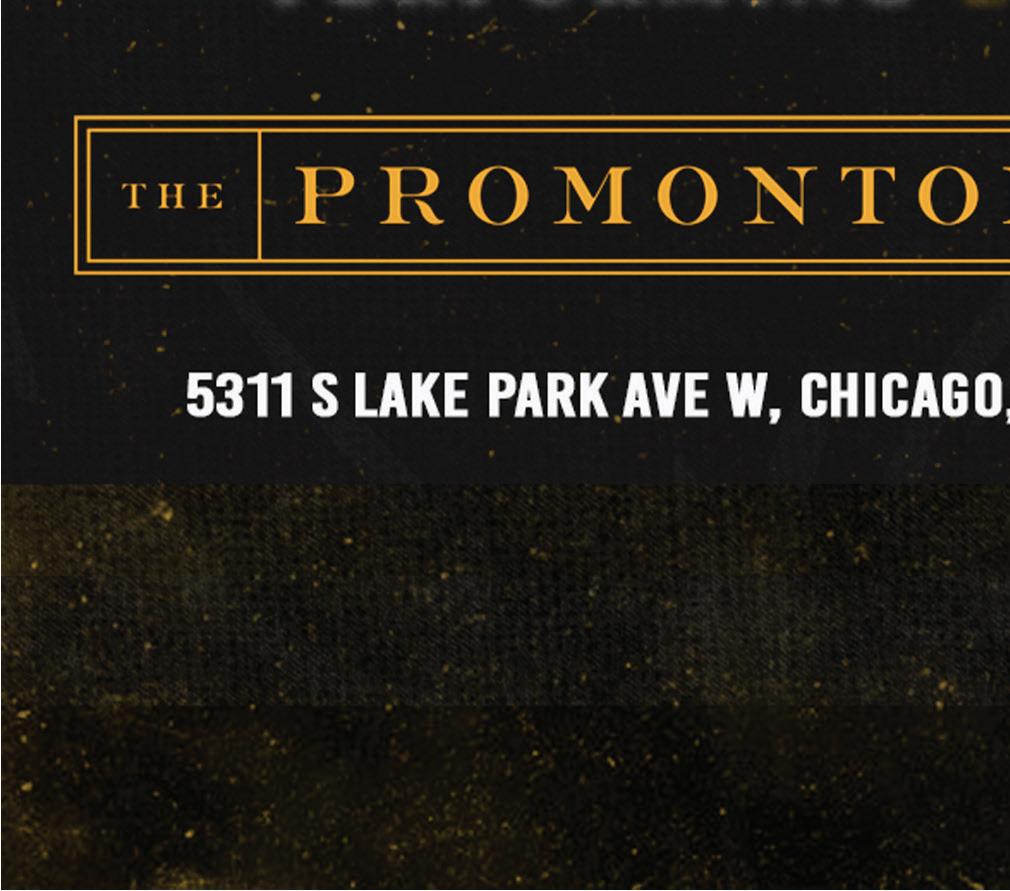

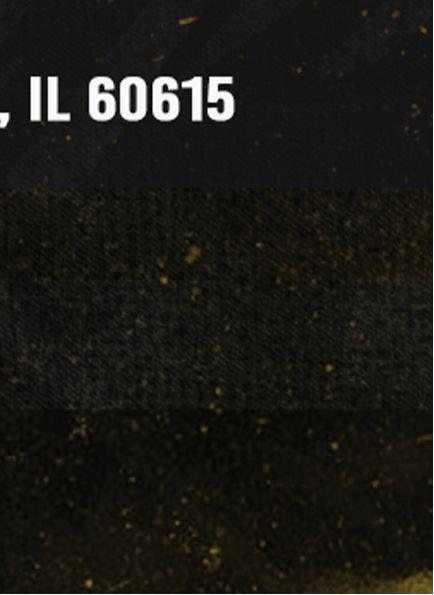
Find

continued from p. 31
core should be,” front man Dennis Lyxzén said in a 2020 oral history for Alternative Press. “[The title] was kind of a piss-take—it could have been called Fuck You.”
By the time the record arrived, though, relationships between the bandmates had frayed, and midway through a frustrating and tumultuous U.S. tour, Refused broke up in Atlanta (though they played one more show, truncated by the police, in Harrisonburg, Virginia). They later posted an open letter on their label’s website titled “Refused Are Fucking Dead,” bemoaning the capitalist commodification of art and culture and vowing to never play together again. But in their absence, the shape of punk did change, and so did the band. When Refused announced their reunion in 2012, some fans felt the band had betrayed their own values (writing for Indy Weekly in 2015, Gary Suarez described it as “self-imposed hypocrisy”), while others welcomed it as a posthardcore second coming—but starting conversations was part of the point. “Nowadays I’m not so confident that music will change the world, but
it could definitely change our world, the world that you’re a part of,” Lyxzén told Rolling Stone in 2013. The world of which Refused were a part had evolved tremendously by the time of their return, due in part to their influence on new generations of bands. The Shape of Punk to Come proved particularly ahead of its time, and its track “New Noise” has appeared in a slew of films and TV shows, including The Bear. (Ironically, Refused were all vegans when they wrote the song that’s now “go time” music in a show about a Chicago Italian beef stand.) After their reunion, Refused released two more albums of righteous battle-ready music, 2015’s Freedom and 2019’s War Music, and last year they announced what was to be their final festival performance in Sweden. But the day before, Lyxzén suffered a massive heart attack. As he recovered, the band made plans for a proper farewell tour, which includes this Salt Shed show. Refused have always been a galvanizing force onstage, and they can be counted on to rise to this ugly political moment—as can openers Quicksand and Racetraitor, their comrades in hardcore’s good fight. —JAMIE LUDWIG v

Architectural Designer sought by Cordogan Clark & Associates in Chicago, IL to assist w/ all phases of design including preparation & development of plans. $59,634/yr. Reqs Bachelors in Architecture or rltd field or equiv. Mst hv perm auth to wrk in US. Snd rsm & cvr lttr to 716 N Wells St, Chicago, IL 60654
Associate Director, Data Operations - Patient Services, AbbVie US LLC, Mettawa, Illinois. Design & implement strategies for acquiring patient data from diverse sources, including enrollment, engagement, market access, & patient support programs.
Define business rules & data quality standards for patient services data integration in collaboration with data stewards & IT teams. Monitor & manage data pipelines to ensure accurate & efficient ingestion, cleansing, & transformation of data. Oversee integration of patient data from multiple enrollment, engagement, & access management systems into the central data platform. Deliver consistent & trustworthy patient data to internal stakeholders across patient services functions, including patient access programs, treatment adherence programs, field operations, & regulatory reporting. Develop & implement data access governance policies & procedures, including data quality rules & cleansing procedures. Analyze patient data to identify trends & insights, collaborate with patient services teams to develop data-driven interventions, track and report key performance indicators (KPIs) for patient services programs, & effectively collaborate with data owners, business system owners, platform owners, data operations teams, & other key stakeholders across the organization.
Must possess a Bachelor’s degree in Information Systems, Computer Science, Business Administration or related field, & 5 years of experience in data management & operations. Of experience required, must have 5 years’ experience in each of the following: (i) managing patient & patient services data sources within pharma; (ii) applying strong analytical & data visualization skills to provide insights to business stakeholders; (iii) utilizing data integration tools & techniques to move data seamlessly between patient intake & engagement systems; (iv) applying data governance frameworks including data quality management to ensure data accuracy & consistency to establish data ownership, access, & security protocols; (v)
coding in SQL for querying & manipulating data in relational databases; (vi) managing data pipelines on cloud platforms including one of: AWS, Azure, or GCP for data storage & management; (vii) managing data compliant with data privacy & security regulations related to PII; & (viii) working within a matrixed organization, managing at least 3 data analysts/engineers, to identify & synthesize business stakeholders needs & interpret & translate to technical solutions. Experience may be gained concurrently. Apply online at https:// careers.abbvie.com/en & reference REF36868F. Salary Range: $190,000 - $253,500 per year.
Data Scientist I , AbbVie Inc., North Chicago, IL. Apply a scientific approach to utility usage & financial strategies through the study of data & model projections. Interface with site engineering, finance, & management ensuring optimal planning is in place for plant utilities. Analyze usage data for monthly business & compliance KPI reporting. Ensure billing & invoicing for utility usage are accurate & timely. Work closely with Maintenance & Reliability Engineering to model failures modes, trends, & manpower utilization to aid in optimizing plant maintenance strategies. Must possess a Bachelor’s degree in Data Analytics, Mathematics, Finance, Engineering, Science, or closely related field and 2 years of experience collecting data in a utility and/or industrial environment in order to identify financial / efficiency opportunities. Of experience required, must have 2 years in each of the following: (i) using data analysis tools & languages; (ii) applying statistical methods in order to complete data analysis; (iii) cleaning, transforming, & preparing data for analysis which includes handling missing data, outliers, & ensuring data quality; (iv) creating data visualization to effectively communicate findings to engineering &/or management; & (v) studying maintenance & equipment reliability data, & identifying trends & recommendations for improvements. Of experience required, must have 1 year building models to project utility volumes for future financial periods. Experience may be gained concurrently. Apply online at https:// careers.abbvie.com/en & reference REF36860H. Salary Range: $113,357.16 - $153,000.00 per year.
IT Project Manager (Park Ridge, IL) to lead & organize all activities pertaining to projects. Master’s in Project Mgmt or Bus Admin, or rltd
plus 12 mos exp in IT Project Mgmt or rltd. Certifications in PRINCE2 or PMP Certification. Exp must incl working w/ Visio, Atlassian JIRA, SQL, Microsoft Teams & UML. Salary $104,021/yr. Send resumes to Peterson Technology Partners, Inc., 1030 W. Higgins Rd, Ste 230, Park Ridge, IL 60068, Attn: N. Shah. (Ref: ITPMY). No Calls. Manager, Statistics (Medical Affairs & Health Technology Assessment Statistics), AbbVie Inc., North Chicago, Illinois. Provide expertise for planning, design, analysis & reporting of clinical trials or real-world studies. Independently develop concepts, protocols, statistical analysis plans, statistical programing plans & clinical study reports for medical affairs studies, & market access analysis plans for health technology assessment submissions. Identify scientifically appropriate data collection instruments. Identify & report data issues or violations of study assumptions. Provide programming specifications for derived variables & analysis datasets. Partner with Data Science in preparing for database lock. Independently perform statistical analyses as per the analysis plan. Collaborate with Statistical Programming to ensure the delivery of high-quality outputs according to agreed-upon timelines. Identify & anticipate issues arising in the study design, conduct & propose scientifically sound approaches. Evaluate appropriateness of available software for planned analyses & assess needs for potential development of novel statistical methodology. Must possess a MS in Statistics, Biostatistics, or a highly related field, & 6 years of work experience performing statistical data analyses. Of the work experience required, must have 6 years: (i) performing data analyses & simulations which support post market medical studies in the medical environment or in the pharmaceutical industry; (ii) conducting scientific research in RWE study designs, inferential statistics, causal inference, or real-world analytics; (iii) identifying data or analytical issues, & assisting with providing solutions by either applying own skills & knowledge or seeking help from others, & (iv) using SAS &/or R statistical software. Alternatively, would accept PhD in Statistics, Biostatistics, or a highly related field, & 2 years of work experience performing statistical data analyses. Of the work experience required, must have 2 years of experience
with (i) through (iv). Work experience may be gained concurrently. Any suitable combination of education, training & experience would be acceptable. Salary Range: $138,772.77 - $197,000.00 per year. Apply online at https:// careers.abbvie.com/en & reference REF36869A
Performance Analyst sought by PlanPILOT, LLC in Chicago, IL to lead day-to-day investment reporting processes of the org. & maintain responsibility for investment oversight duties to clients. Reqs: Bachelor’s in Finance, Econ, or rltd field. Must possess course work, internship, or work exp w/ Wealth Mgmt: reviewing portfolios based on clients’ risk tolerances, time horizon, & preferences; review asset classes/ categories, review investment benchmarks, & work w/recordkeepers such as Fidelity; & etc. Telecommuting permitted w/in commutable distance to office. Apply at: https:// planpilot.com/careers/
Aquatic Group is seeking a Quantitative Researcher in Chicago, IL. Create and improve proprietary trading models and strategies. Must live within normal commuting distance of worksite. May work remotely up to 10 days per year. Please go to https:// aquatic.com/#careers to apply and get info on role and benefits.
Senior Project Accountant: Accurate record keeping; accounts payable/ receivable management. Payroll processing. Filing of payroll taxes, fringes, deductions: weekly Fed & State withholding, contributions. Budgeting and Forecasting. Bachelors in finance or accounting. 2 yrs exp as accountant or finance manager. $73,299 per yr. Paid time off; partial reimbursement for health ins; 401k; simple IRA, life & disability. Res: Altounian Construction, Inc. (Attn C. Brolley) 919 Sherwood Dr, Lake Bluff IL 60044 Res: Altounian Construction, Inc. (Attn C. Brolley) 919 Sherwood Dr, Lake Bluff IL 60044
Senior Software Engineer (Chicago, IL). Duties: Build systems in a multicloud envrmt using AWS & GCP; create microservices w/in the JVM; create APIs & web svcs; perform containerorchestration using Docker & Kubernetes. Reqmts: Master’s in Comp Info Systems,
Comp Sci, or rltd field. In-depth knowl of: backend & front-end dvlpmt; CI/CD; Kubernetes; Serverless; JavaScript; TypeScript; Ruby on Rails; Node.js; Scala; React. Telecommuting from any location in the US is an option for this position. Salary $146,224 to $155,000/yr. PTO, medical/dental/vision, 401K, contact employer for additional benefit info. MUST follow these specific application instructions to be considered: Send CV & cover letter to mgrand@ project44.com or Marco Le Grand, project44, LLC, 222 W Merchandise Mart Plaza, Ste 1744, Chicago, IL 60654 w/in 30 days & ref Job #W2023-158.
The Dept of Neurology & Rehabilitation, at the Univ of IL Chicago, located in a large metropolitan area, is seeking full-time Assistant Professor of Clinical Neurology/Physician Surgeon to assist the department with the following responsibilities: Under direction & supervision, assist department provide full-time clinical patient care in the specialties of Neurology & Neurocritical Care to a diverse patient population, including the medically underserved, in both hospital & outpatient clinic settings. In addition to providing full-time clinical patient care, teach, train & advise medical students, residents & fellows in Neurology & Neurocritical Care; conduct medical science research; publish scientific research findings; & perform other Univ service & administrative duties as assigned. No travel is required for this position. This position minimally requires MD degree or foreign equivalent, 4 yrs of Neurology residency training, 2 yrs of Neurocritical Care fellowship training, a valid IL med license or eligibility for IL med license, & board certification or eligibility for certification in Neurology & Neurocritical Care medicine. For fullest consideration, please submit CV, cover letter, & 3 professional references by April 20, 2025 to David Katz, Dept of Neurology & Rehabilitation, 912 S Wood St, Chicago IL 60612 or via email to Davkatz@ uic.edu. UIC is an Equal Opportunity, Affirmative Action employer. Minorities, women, veterans, & individuals w/ disabilities are encouraged to apply. UIC may conduct background checks on all job candidates upon acceptance of a contingent offer letter. Background checks will be performed in compliance with the Fair Credit Reporting Act. As a qualifying federal contractor, the University of Illinois System uses E-Verify to verify employment eligibility. The Univ of Illinois System
requires candidates selected for hire to disclose any documented finding of sexual misconduct or sexual harassment & to authorize inquiries to current & former employers regarding findings of sexual misconduct or sexual harassment. For more information, visit https:// www.hr.uillinois.edu/ cms/One.aspx?portalId= 4292&pageId=1411899 David Katz davkatz@uic.edu
The Offc of the Vice Chancellor for Research of the Univ of Illinois Chicago, located in a large-size metropolitan area, is seeking full-time IT Technical Associate (Sr. Application Developer) to assist the department w/ the following responsibilities: Under direction and supervision, will be responsible for the design of public facing, mission critical, largescale applications to meet functional, performance, reliability, and availability requirements. This role performs complex software design activities and integrating multiple technologies. Lead the design and development teams in the proper application of system designs for current and future technologies. Provide technical architectural oversight and help facilitate continuous SDLC improvement for applications being developed by recommending the right combination of tools, architecture and process that will help custom application development team maximize quality, output while minimizing cost and time to deliver. Serve as the subject matter expert in application architecture, design, project management and system integration. Perform other duties as assigned. No travel is required for this position. This position minimally requires a Bachelor’s degree or foreign equivalent in Computer Science, Information Technology, or rltd field of study, & 5 yrs of professional IT Development experience, specifically in developing and/or modifying new and existing applications, including requirement analysis, design, code, test, debug, and implementation and maintenance. Also requires any experience with C#, .Net Entity Framework, .Net API, database programming in SQL, and Oracle and/or MySQL. For fullest consideration, please submit CV, cvr ltr, & 3 professional references by 4/20/2025 to the Search Coordinator, UIC/OVCR, 1737 W Polk St, M/C 672, Chicago, IL 60612 or via email to DBENTL2@ uic.edu. UIC is an Equal Opportunity, Affirmative Action employer.
Minorities, women, veterans, & individuals w/ disabilities are encouraged to apply. UIC may conduct background checks on all job candidates upon acceptance of a contingent offer letter. Background checks will be performed in compliance with the Fair Credit Reporting Act.
Commonwealth Edison seeks Business Analyst in Oakbrook Terrace, IL to perform gen. analysis & prep. reports to supp. bus. ops.; conduct modeling, forecasting, trending, variance analysis, bus. case dvlpmnt, & other gen. financial & op. analysis; monitor & coord. activities to supp. op. perf. mgmt. (e.g., safety, reliability, service level, productivity, etc.); research & provide stat.l financial & op. info.; track, maintain, anlyz & provide current info. on the operation’s bus. scorecard or key perf. indicators (KPIs); dvlp & org. perf. reports for both internal & external use; contribute to the dvlpmnt of short-term & long-range bus. planning; provide anlytcl & op. supp. to the bus. unit. Reqs U.S. or foreign equiv. bach.’s deg. in Bus., Mrktng Anlytcs, or a rel. field, + 2 yrs rel. exp. in bus. ops. analysis using Power BI, SharePoint, & PowerPoint, & constructing adv. Excel models for cost & trend analysis reports. Telecomm. 2 days/ wk from w/in normal commuting distance of Oakbrook Terrace, IL is permitted. Salary range from $69,035 to $97,200. Reply by email w/ resume to jobposting@ exeloncorp.com
CHESTNUT ORGANIZING AND CLEANING SERVICES: especially for people who need an organizing service because of depression, elderly, physical or mental challenges or other causes for your home’s clutter, disorganization, dysfunction, etc. We can organize for the downsizing of your current possessions to more easily move into a smaller home. With your help, we can help to organize your move. We can organize and clean for the deceased in lieu of having the bereaved needing to do the preparation to sell or rent the deceased’s home. We are absolutely not judgmental; we’ve seen and done “worse” than your job assignment. With your help, can we please help you? Chestnut Cleaning Service: 312-332-5575. www.ChestnutCleaning. com www. ChestnutCleaning.com


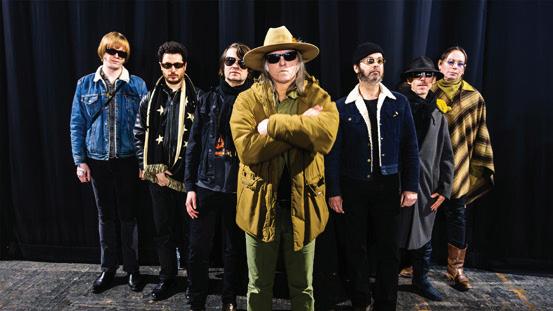

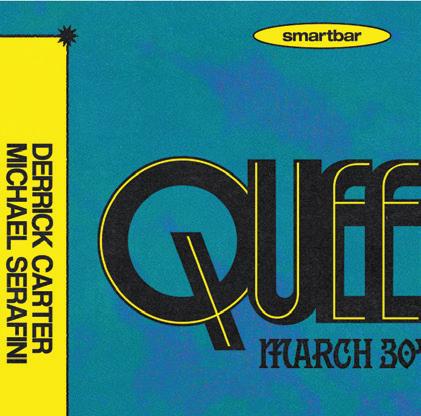


Sex toys might be the assist a married couple needs; plus, good news!
By DAN SAVAGE

I’ve been happily married to my wife for 15 years. I’m a 54-year-old man and she’s a 55-year-old woman. Sex together has never been our strongest suit but we’ve made the effort. She now finds sex too painful and no longer wants to have intercourse. I’m on the larger side, which may or may not be relevant. She’s still willing to do oral sex, which we do maybe once a month. I don’t want to go without intercourse for the rest of my life and have told her as much.
Recently in couples therapy, I proposed opening things up in a variety of ways. She refused it all, saying it would cause her shame and that she’s too afraid opening our relationship would lead to me falling for someone else.
I feel like we’re at a dead end but I love her, our life, and our teenage kid too much to leave her over this. I looked online for sex toys that would simulate vaginal intercourse and found a few, but I’m looking for something that we could use together, something that would get as close to the experience (for me) as possible. I assume you’ve gotten hundreds of variations on this question over the years and thought you might have a good suggestion. —NOT READY TO GO WITHOUT
a : If this is a problem your wife is interested in solving (pain during intercourse a er, presumably, menopause) she could talk to her doctor about low-dose vaginal estrogen, a safe and effective treatment for thinning vaginal tissues due to falling
estrogen levels. If your wife isn’t open to talking about this treatment with her doctor, NRTGW, this may not be a problem she’s interested in solving. She may not even regard it as a problem.
If penis-in-vagina (PIV) sex was never about your wife’s pleasure, she might not feel motivated to seek treatment. And if all she’s missing out on is providing you with maintenance sex, then she’s not missing out on much. It’s also possible that she lost interest in sex as she aged (some people do), and the pain she now experiences during intercourse gave her the excuse she needed to pull a plug she wanted to pull for years. (Still, for her own sake, your wife should talk to her doctor, as untreated vaginal atrophy is a risk factor for bladder infections and other conditions.)
As to your specific question . . . you’re in luck! There are lots of masturbation toys for people with penises that simulate the sensations of intercourse, such as Fleshlight-style toys with hard plastic shells and softer silicone sleeves. If your wife is willing to hold one of those Fleshlight-style toys between her thighs, you could simulate missionary position PIV. You would have to be careful the toy didn’t chafe, slide up, and/or grind uncomfortably against your wife’s sensitive vulva. Intercrural sex is another good option—you put that big dick between her upper thighs, she clenches her legs together, you thrust until you come—and it’s one that wouldn’t require your wife to hold a hard-shell plastic sex toy as you hammer away. While you’re ordering
sex toys, NRTGW, why not consider a few toys you think your wife might like to try? You could invite your wife to join you while you browse and encourage her to pick toys just for her. With a Fleshlight for you and a Magic Wand for her, sex could suddenly become, well, maybe not your strongest suit, NRTGW, but a much sturdier one.
Q : I am a 45-year-old woman writing in with some good news! I had my first threesome yesterday and it was a Yahtzee moment. It was a delightful surprise to discover that we were all incredibly into one another and vibed well together and in pairs. This much younger couple was sweet and hot, and I was comfortable and game and fully present. I also confirmed for myself that I am decidedly not straight. Thank you for all of the anonymous encouragement over the years! —TOTALLY HAD REALLY EXCITING EXPERIENCE
a : Thank you for writing. I needed it a er reading through the mail and doomscrolling through the news this week, THREE. P.S. You and/or this couple would be great guests for a new segment we just launched on the Savage Lovecast! I interview regular people who’ve stepped outside their comfort zones to try something new. Our first After-Action Report appears on this week’s show and more installments are coming! v
Read the rest of this column at the URL savage.love. m mailbox@savage.love

Blood Wolf Moon
April 10, 6 PM In partnership with the Center for Native Futures
April 17, 6 PM Exhibition opening Escaramuza, the Poetics of Home
poetryfoundation.org/events FREE poetry events and gi s for visitors
